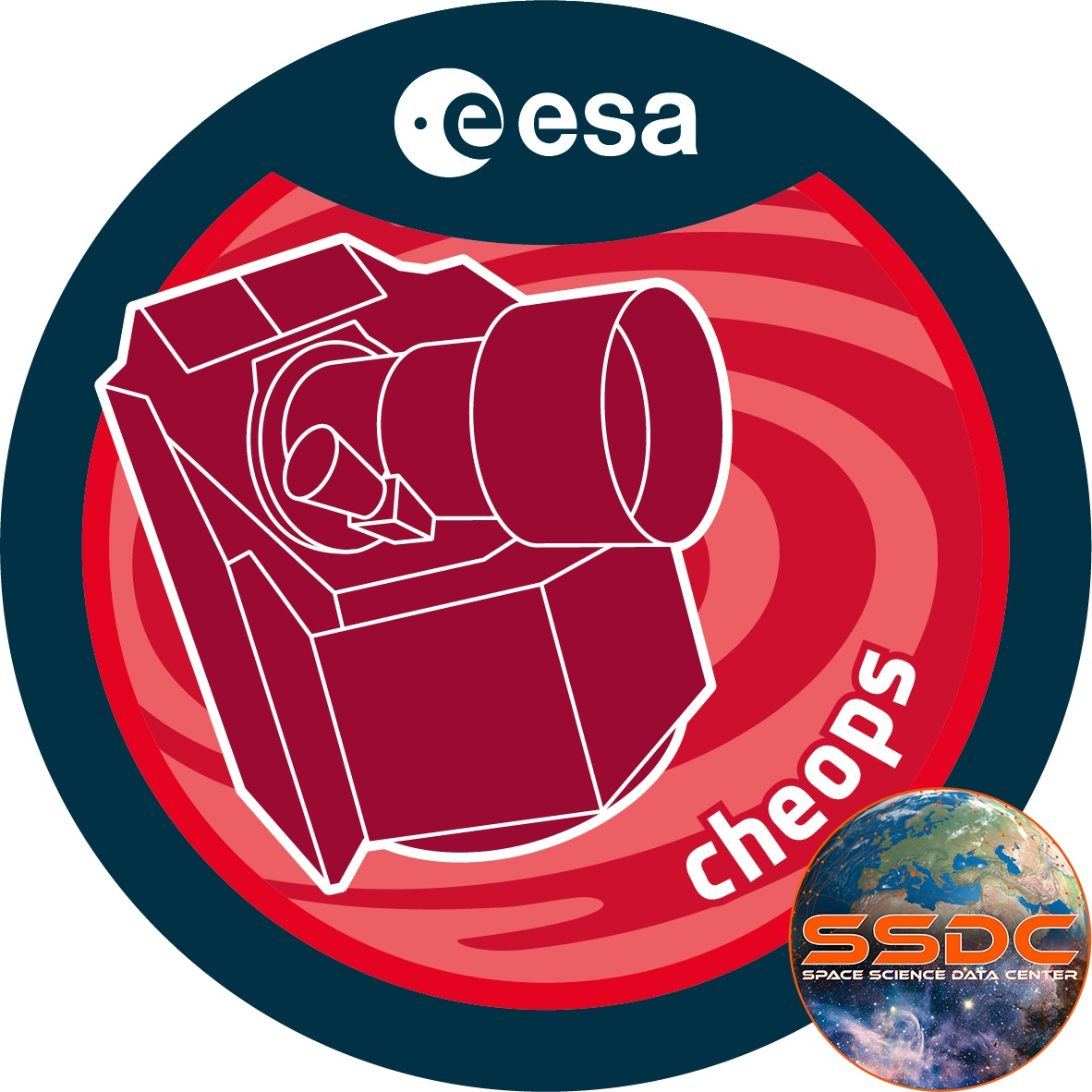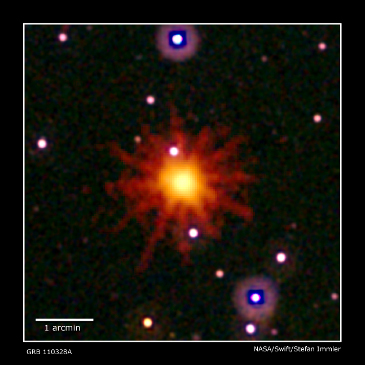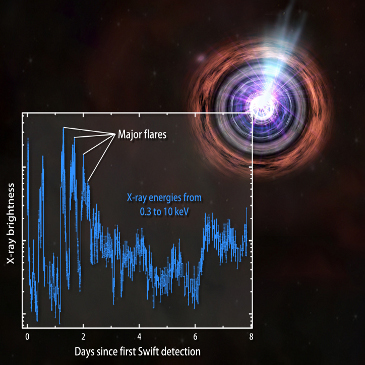| Oct 24, 2025 | Latest updates from the AGILE Data Center AGILE is a scientific mission dedicated to high-energy astrophysics. The AGILE satellite, designed for a nominal operative life of only two years, ceased observations on January 18, 2024, after almost 17 years of successful in-orbit operations. Hereafters are three of the main recent updates from AGILE during the current post-operative phase. 1. The open-source Python package named Agilepy, built on top of the command-line version of the AGILE/GRID Science Tools developed at INAF/OAS Bologna to analyse AGILE/GRID data, was updated twice. The most recent Agilepy version is v1.7.0 (Oct 17, 2025), also available on Zenodo, DOI: https://zenodo.org/records/17378356 2. The SSDC online interactive web table of the Second AGILE Catalog of Gamma-Ray sources (2AGL) gives access to the skymap images and now also to the available light curves (4-day timebins both as png plots and in ASCII data format), providing supplementary material to the published catalog paper. 3. A complete (Level 3) data reprocessing (pointing + spinning) was performed on 64-bit computers to produce new Aitoff maps of the entire AGILE sky (deep Aitoff skymaps) with the Scientific Build 25 and new calibrations (IRF H0025). 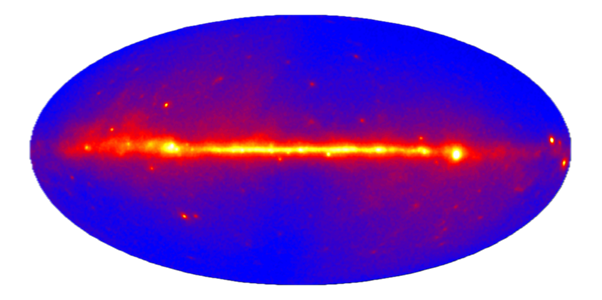 |
| Feb 28, 2025 | AGILE legacy archive follow-up of the exceptional Km3Net neutrino event Km3-230213A New ATel issued: ATel #17056 (G. Panebianco et al.). |
| Jul 31, 2024 | eROSITA-DE DR1 Catalogues in the SED Builder We announce that, since July 2024, the eROSITA-DE DR1 Catalogues described in Merloni et al. 2024 (A&A, 682, A34) are available in the SSDC SED Builder. These catalogues (Main, Hard, and Supplementary), including both point-like and extended sources, have been obtained using the data acquired in the first six months of the eROSITA all-sky survey (eRASS1), completed in June 2020. In the SED Builder tool, a selection of bands among those provided by the eROSITA-DE Consortium has been carried out for both the Main and the Supplementary catalogues. Besides the 0.2-2.3 keV band (band 1), five additional bands (P1, ..., P5) have been selected. For the Hard catalogue, all bands (0, 1, 2, and 3) have been included in the SED Builder. The possibility of loading data from the Supplementary catalogue, which includes a higher fraction of spurious sources, is not given by default but needs to be hand-confirmed by the user. |
| Jul 11, 2024 | The MATISSE tool updates towards planetary geology A new paper, with first author Veronica Camplone (SSDC/INAF-OAR/UniPv), has been recently published in the journal Astronomy & Computing. This article details a significant update to the ASI-SSDC scientific web tool dedicated to the analysis of planetary exploration data, MATISSE (Multi-purpose Advanced Tool for Instruments for the Solar System Exploration). MATISSE, launched in 2013, allows for the search and visualization of data, projected even on the three-dimensional shape of the studied objects, using a common web browser without the need for additional software installation. This tool is constantly evolving thanks to new collaborations between SSDC and various research groups, both Italian and international. Currently, MATISSE provides access to data related to Mercury, Venus, Mars, Ceres, Vesta, and Didymos, enabling researchers to conduct comparative analyses and deepen their understanding of the processes characterizing the different explored worlds. The article outlines the recent addition of an advanced functionality to the tool, which allows for data searches based not only on geographical or temporal information but also on higher-level semantic information contained in geological maps. Specifically, the article describes how the ability to search by selecting data on Mercury acquired by the MDIS camera aboard NASA's MESSENGER spacecraft has allowed a focus on craters with central pits using only Matisse, without the need to cross-reference data from various sources. The enhanced functionalities of MATISSE now enable the integration of geological maps and the analysis of specific data based on selected parameters, such as target, mission, instrument, geological units, and area of interest. To demonstrate the effectiveness of this approach, the work focused on the central pit craters of Mercury, particularly in the Hokusai, Victoria, and Derain quadrangles. Using MATISSE for this application allowed for the analysis of these morphologies, confirming a tendency for their location on volcanic terrains. The integrated research approach adopted in this study has proven to be a significant advantage in geological analysis, accelerating the process of data collection and interpretation. In conclusion, this study shows how the continuous evolution of scientific tools dedicated to data management, and management based on FAIR (Findable, Accessible, Interoperable, Reusable) principles, like MATISSE, has the potential to open new perspectives in understanding geological processes on a planetary scale. |
| Feb 29, 2024 | New AGILE Public Data up to January 15, 2024 We are pleased to announce the publication of new AGILE gamma-ray data up to January 15, 2024. The new public AGILE archive now contains all data from December 1, 2007 up to January 15, 2024, i.e. from Observation Block (OB) 4900, start of Cycle-1 up to the last complete OB 43100 of the Cycle-17. We recall that AGILE's scientific observations ended on January 18, 2024, and the satellite re-entered into the atmosphere on February 14, 2024 as a consequence of natural decay of its low Earth orbit. AGILE-GRID event files (EVT) and spacecraft auxiliary (LOG) files are available from the SSDC Multimission Archive (MMIA) webpage for the AGILE Mission. The AGILE public scientific software package AGILE_SW_6.0, adapted from the AGILE Science Tools (TAGNAME = BUILD25), is available here. For an easy on-line AGILE data analysis, the interested user may also query the entire public AGILE level 3 (LV3) archive through the AGILE-LV3 data analysis tool. The AGILE-LV3 tool is meant to be easily comprehensible, and it does not require any install-on-premises software or calibrations. An open-source Python package named Agilepy, built on top of the command-line version of the AGILE/GRID Science Tools, has been developed at INAF/OAS Bologna to analyse AGILE/GRID data. Since version 1.5.0, Agilepy has implemented an automated download of public AGILE GRID data using an SSDC REST Api. The most recent Agilepy version is v1.6.4. |
| Feb 14, 2024 | The AGILE satellite ceased operations and re-entered today into the atmosphere New GCN issued: GCN #35726 (M. Tavani et al.). New ATel issued: ATel #16450 (M. Tavani et al.). |
| Jan 18, 2024 | AGILE satellite ceased scientific observations After 17 years of productive operations, the AGILE satellite ceased scientific observations on January 18, 2024. Further communication and press release will follow. |
| Jan 11, 2024 | AGILE detection of gamma-ray rebrightening of the blazar PKS 1424-418 New ATel issued: ATel #16400 (A. Bulgarelli et al.). |
| Dec 15, 2023 | GRB 231215A: AGILE detection New GCN issued: GCN #35361 (F. Verrecchia et al.). |
| Dec 06, 2023 | GRB 231205B: AGILE detection New GCN issued: GCN #35295 (C. Casentini et al.). |
| Dec 01, 2023 | GRB 231129C: AGILE detection New GCN issued: GCN #35244 (G. Panebianco et al.). |
| Nov 17, 2023 | GRB231117A: AGILE/MCAL analysis New GCN issued: GCN #35085 (C. Casentini et al.). |
| Nov 17, 2023 | GRB 231117A: AGILE detection of a bright short burst New GCN issued: GCN #35075 (P.W. Cattaneo et al.). |
| Nov 16, 2023 | GRB 231115A: AGILE/MCAL upper limits New GCN issued: GCN #35061 (C. Pittori et al.). |
| Nov 14, 2023 | LIGO/Virgo S231113bw: upper limits from AGILE/MCAL New GCN issued: GCN #35024 (L. Foffano et al.). |
| Nov 06, 2023 | LICIACube data publicly availble at SSDC The data from the ASI LICIACube mission, which performed a flyby of the Didymos-Dimorphos binary asteroid system on 27th September 2022, soon after the first planetary defense test performed by the NASA DART mission, are now publicly available from both the LICIACube SOC, hosted by SSDC, and the SSDC webtool MATISSE. In particular, on the SOC it is be possible to find all the data acquired by the two LICIACube cameras, LEIA and LUKE, in both raw and calibrated form: it is possible to either download the FITS files or the PDS4 granules (FITS observation + XML labels). Also the NAIF SPICE kernels for the mission are available for the download by the SOC, so that accurate mission trajectories, attitudes and pointing can be computed. On the other hand, by means of MATISSE it is possible to search for LUKE images acquired over Didymos interactively projected over the 3D shape model of the target, to be viewed in common web-browsers or to be downloaded and analysed offline. |
| Oct 16, 2023 | New AGILE Public Data up to September 30, 2023 We are pleased to announce the publication of new AGILE gamma-ray data up to September 30, 2023.The new public AGILE archive now contains all data from December 1, 2007 up to September 30, 2023, i.e. from the start of Cycle-1, Observation Block (OB) 4900, up to up to OB 42400 of the on-going Cycle-16. AGILE-GRID event files (EVT) and spacecraft auxiliary (LOG) files are available from the SSDC Multimission Archive (MMIA) webpage for the AGILE Mission. The AGILE public scientific software package AGILE_SW_6.0, adapted from the AGILE Science Tools (TAGNAME = BUILD25), is available here. For an easy on-line AGILE data analysis, the interested user may also query the entire public AGILE level 3 (LV3) archive through the AGILE-LV3 data analysis tool. The AGILE-LV3 tool is meant to be easily comprehensible, and it does not require any install-on-premises software or calibrations. An open-source Python package named Agilepy, built on top of the command-line version of the AGILE/GRID Science Tools, has been developed at INAF/OAS Bologna to analyse AGILE/GRID data. Since version 1.5.0, Agilepy has implemented an automated download of public AGILE GRID data using an SSDC REST Api. The most recent Agilepy version is v1.6.4. |
| Sep 01, 2023 | The Swift X-ray Observations Campaign of the Repeating FRB20220912A New ATel issued: ATel #16221 (F. Verrecchia et al.). |
| Aug 13, 2023 | GRB 230812B: AGILE/MCAL detection New GCN issued: GCN #34402 (C. Casentini et al.). |
| Jul 27, 2023 | GRB 230723A: AGILE/MCAL detection New GCN issued: GCN #34237 (G. Panebianco et al.). |
| Jun 09, 2023 | GRB 230608A: AGILE detection New GCN issued: GCN #33946 (F. Longo et al.). |
| May 30, 2023 | LIGO/Virgo/KAGRA S230529ay: upper limits from AGILE/MCAL New GCN issued: GCN #33894 (F. Longo et al.). |
| May 26, 2023 | New AGILE Public Data now available up to March 31, 2023 We are pleased to announce the publication of new AGILE gamma-ray data up to March 31, 2023. The new public AGILE archive now contains all data from December 1, 2007 up to March 31, 2023, i.e. from Observation Block (OB) 4900, start of Cycle-1 up to OB 41200 of the on-going Cycle-16. AGILE-GRID event files (EVT) and spacecraft auxiliary (LOG) files are available from the SSDC Multimission Archive (MMIA) webpage for the AGILE Mission. Since October 2015 all AGILE-GRID data are published as soon as they are processed and validated. To produce your own maps and run likelihood tasks please download and install the new public AGILE software available here, and follow the User Manual included. The AGILE public scientific software package AGILE_SW_6.0, adapted from the AGILE Science Tools (TAGNAME = BUILD25), was published on Apr 18, 2019. It includes updated scientific software and calibrations, an updated model for the Galactic diffuse gamma-ray emission, a refined procedure for point-like source detection, and the search for extended gamma-ray sources. An open-source Python package named Agilepy, built on top of the command-line version of the AGILE/GRID Science Tools, has been developed at INAF/OAS Bologna to analyse AGILE/GRID data. Since version 1.5.0, Agilepy has implemented an automated download of public AGILE GRID data using an SSDC REST Api. For an easy on-line AGILE data analysis, the interested user may also query the entire public AGILE level 3 (LV3) archive through the AGILE-LV3 data analysis tool. The AGILE-LV3 tool is meant to be easily comprehensible, and it does not require any install-on-premises software or calibrations. NOTE: due to a temporary problem on the AGILE telemetry time stamps, a correction has been implemented in 2022 on the real time ground software. The reprocessing of the consolidated archive for the 6-months period from September 30, 2021 to March 31, 2022 (OBs 37700-38800) is still pending, and the corresponding data are not public yet. The public archive is not affected. All AGILE payload functions are nominal. |
| May 24, 2023 | GRB 230524A: AGILE detection New GCN issued: GCN #33867 (G. Panebianco et al.). |
| May 19, 2023 | LIGO/Virgo S230518h: AGILE/MCAL observations New GCN issued: GCN #33826 (F. Verrecchia et al.). |
| Apr 26, 2023 | AGILE detection of the gamma-ray source AGL J2114+6249 New ATel issued: ATel #16012 (L. Foffano et al.). |
| Apr 19, 2023 | GRB 230418A: AGILE detection New GCN issued: GCN #33656 (G. Panebianco et al.). |
| Apr 11, 2023 | GRB 230410B: AGILE detection of a burst New GCN issued: GCN #33604 (F. Verrecchia et al.). u |
| Apr 07, 2023 | GRB 230405B: AGILE detection New GCN issued: GCN #33585 (C. Casentini et al.). |
| Apr 06, 2023 | AGILE detection of the gamma-ray source AGL J1626-3528 New ATel issued: ATel #15979 (C. Pittori et al.). |
| Apr 04, 2023 | Fourth Announcement of Opportunity for the CHEOPS Guest Observers programme The Announcement of Opportunity for the CHEOPS Guest Observers (GO) programme have been released on April 4 2023 and it is the first opportunity in the CHEOPS' first extended mission. The call opened on April 4 and will close on May 25 2023 and will include observing time from 25 September 2023 to 30 September 2024. The science cases may include exomoons, ring structures, stellar activity and more. Full details on the call, on the Programme and how to apply can be found here. The main ESA website are the following: |
| Apr 02, 2023 | GRB 230402A: AGILE detection New GCN issued: GCN #33555 (C. Casentini et al.). |
| Mar 18, 2023 | Gamma-ray rebrightening of the blazar PKS 0402-362 detected by AGILE New ATel issued: ATel #15952 (C. Pittori et al.). |
| Mar 09, 2023 | GRB 230307A: AGILE/MCAL analysis New GCN issued: GCN #33444 (C. Casentini et al.). |
| Mar 09, 2023 | GRB 230308A: AGILE/MCAL detection New GCN issued: GCN #33435 (C. Casentini et al.). |
| Mar 07, 2023 | Extended CHEOPS mission lifetime ESA's Science Programme Committee (SPC) has confirmed the continued operations of the science missions including CHEOPS. CHEOPS approved extension will cover 2026 and an indicative extension to 2029 upon ongoing committements from national contributors. The ESA news is here. |
| Mar 07, 2023 | GRB 230307A: AGILE/MCAL detection New GCN issued: GCN #33412 (C. Casentini et al.). |
| Feb 18, 2023 | GRB 230217A: AGILE/MCAL detection New GCN issued: GCN #33343 (C. Casentini et al.). |
| Feb 15, 2023 | Gamma-ray activity of the blazar PKS 0402-362 detected by AGILE New ATel issued: ATel #15905 (A. Bulgarelli et al.). |
| Feb 15, 2023 | GRB 230209B: AGILE detection New GCN issued: GCN #33325 (C. Casentini et al.). |
| Feb 07, 2023 | GRB 230207B: AGILE detection of a burst New GCN issued: GCN #33296 (C. Casentini et al.). |
| Feb 05, 2023 | GRB 230204B: AGILE detection New GCN issued: GCN #33272 (C. Casentini et al.). |
| Jan 10, 2023 | AGILE detection of gamma-ray activity from blazar 4C 29.45 New ATel issued: ATel #15853 (A. Di Piano et al.). |
| Jan 04, 2023 | GRB 230104A: AGILE/MCAL detection New GCN issued: GCN #33148 (A. Ursi et al.). |
| Jan 02, 2023 | GRB 230102A: AGILE/MCAL detection New GCN issued: GCN #33138 (A. Ursi et al.). |
| Dec 27, 2022 | GRB 221226A: AGILE detection New GCN issued: GCN #33113 (G. Panebianco et al.). |
| Dec 22, 2022 | GRB 221221A: AGILE detection New GCN issued: GCN #33093 (C. Casentini et al.). |
| Dic 21, 2022 | AGILE detection of increasing gamma-ray activity of blazar PKS 1424-418 New ATel issued: ATel #15818 (F. Verrecchia et al.). |
| Nov 30, 2022 | AGILE detection of renewed Gamma-ray activity from 3C 454.3 New ATel issued: ATel #15782 (G. Panebianco et al.). |
| Nov 28, 2022 | GRB 221126A: AGILE detection New GCN issued: GCN #32992 (C. Casentini et al.). |
| Nov 19, 2022 | Ongoing gamma-ray flare from the PKS 0805-07 detected by AGILE New ATel issued: ATel #15768 (A. Bulgarelli et al.). |
| Oct 29, 2022 | GRB 221028A: AGILE detection New GCN issued: GCN #32885 (A. Ursi et al.). |
| Oct 29, 2022 | GRB 221027A: AGILE detection New GCN issued: GCN #32884 (A. Ursi et al.). |
| Oct 26, 2022 | GRB 221023A: AGILE/GRID analysis New GCN issued: GCN #32856 (F. Verrecchia et al.). |
| Oct 24, 2022 | GRB 221023A: AGILE detection of a burst New GCN issued: GCN #32825 (A. Ursi et al.). |
| Oct 23, 2022 | GRB 221022B: AGILE detection New GCN issued: GCN #32822 (C. Casentini et al.). |
| Oct 19, 2022 | AGILE detection of a burst from SGR J1935+2154 reported by VZLUSAT-2 New GCN issued: GCN #32801 (C. Casentini et al.). |
| Oct 18, 2022 | AGILE detection of the 2022 October 17 burst from SGR J1935+2154 reported by Konus-Wind New GCN issued: GCN #32796 (F. Verrecchia et al.). |
| Oct 18, 2022 | AGILE detection of short X-ray flaring activity contemporary to SGR J1935+2154 reported bursts New GCN issued: GCN #32789 (C. Casentini et al.). |
| Oct 11, 2022 | GRB 221009A/Swift J1913.1+1946: AGILE-GRID detection New ATel issued: ATel #15662 (G. Piano et al.). |
| Oct 10, 2022 | GRB 221009A (Swift J1913.1+1946): AGILE/GRID detection New GCN issued: GCN #32657 (A. Ursi et al.). |
| Oct 10, 2022 | GRB 221009A (Swift J1913.1+1946): AGILE/MCAL detection New GCN issued: GCN #32650 (A. Ursi et al.). |
| Sep 22, 2022 | SSDC Solar System group at EPSC 2022 This week Edoardo Rognini and Veronica Camplone are at the European Planetary Science Congress in Granada, Spain, with the work "Mercury exploration with MATISSE tool". The combination of a thermophysical model and the capability of selecting data basing upon geological maps, makes MATISSE a very powerful tool for the study of the first planet of the solar system. A capability that would become crucial with the ESA-JAXA BepiColombo mission approximating its scientific phase. |
| Sep 10, 2022 | GRB 220910A: AGILE detection New GCN issued: GCN #32540 (A. Ursi et al.). |
| Jul 31, 2022 | Gamma-ray rebrightening of the blazar PKS 1424-418 detected by AGILE New ATel issued: ATel #15533 (F. Verrecchia et al.). |
| Jul 25, 2022 | Ongoing gamma-ray flare from the blazar PKS 1424-418 detected by AGILE New ATel issued: ATel #15527 (G. Piano et al.). |
| Jul 22, 2022 | AGILE news AGILE, PUBLISHED THE FIRST ARTICLE ABOUT THE "NEW YEAR'S BURST" The first article about the GRB 220101A, the exceptionally energetic "New Year's Burst", has been published by AGILE on July, 15, 2022 (Ursi et al., ApJ 933, 2022). Few hours after the midnight of January 1, 2022, several satellites devoted to high-energy astrophysics, including AGILE had greeted the beginning of the new year by revealing what is probably the most energetic Gamma-Ray Burst (GRB) ever reported in the history of the observations of these phenomena, i.e., the GRB 220101A. In its 15 years activity, AGILE has already had the opportunity to reveal some particularly intense GRBs, such as the GRB 080916C and the GRB 160625B, but these events are quite rare. GRB 220101A took place more than 12 billion light years away, at the time when the Universe was just about 1.3 billion years old, and its equivalent isotropic energy is the highest ever reconstructed for a GRB. This record-breaking energy has drawn a great deal of attention from the scientific community in a short time. In the following days, more than twenty GCN communications were released, reporting observations carried out by other space missions and by astronomical ground-based observatories. AGILE data provide a first characterization of the prompt phase of this GRB, which corresponds to the emission of high-energy radiation in the initial shocks taking place within the central engine. The different detectors onboard the satellite, whose energy coverage ranges from the X-ray (SuperAGILE 20-60 keV) to the gamma-ray (AGILE-MCAL 0.4-100 MeV) band, allowed to provide a first comprehensive overview of the temporal evolution and the energetics of this event. Using AGILE data together with public data from the Swift satellite, it was also possible to study also the so-called "afterglow" emission, that is, the delayed emission at lower energies, produced by the interactions of the initial shocks with the surrounding interstellar medium. This analysis allows to obtain interesting information regarding the environment in which such energetic event took place. NEW AGILE TGF CATALOG UPDATE UP TO DECEMBER 31, 2021 AGILE confirms itself as an exceptional instrument, not only for the observation of cosmic phenomena, but it continues to give fundamental contribution also for the observation of high-energy phenomena from the Earth, such as the Terrestrial Gamma-Ray Flashes (TGFs) (A. Lindanger et al. 2020; C. Maiorana et al. 20209). Recently all TGFs seen by AGILE up to 31 December 2021 have been published as an interacting SSDC web page, including details and additional information compared to the original publications of the third TGF catalog in 2020. Additional links: ASI news (in Italian): https://www.asi.it/2022/07/agile-pubblicato-il-primo-studio-sul-grb-di-capodanno/ ASI news (in English): https://www.asi.it/en/2022/07/agile-published-the-first-article-about-the-new-years-burst/ |
| Jul 15, 2022 | GRB 220715A: AGILE/MCAL detection New GCN issued: GCN #32401 (A. Ursi et al.). |
| Jun 30, 2022 | GRB 220624A: AGILE/GRID refined analysis New GCN issued: GCN #32303 (F. Verrecchia et al.). |
| Jun 24, 2022 | GRB 220624A: AGILE/GRID analysis New GCN issued: GCN #32261 (F. Verrecchia et al.). |
| Jun 24, 2022 | GRB 220624A: AGILE detection New GCN issued: GCN #32259 (A. Ursi et al.). |
| Jun 23, 2022 | GRB 220623A: AGILE detection New GCN issued: GCN #32247 (A. Ursi et al.). |
| Jun 06, 2022 | Paper about SSDC activities for LICIACube published A paper describing the role of SSDC in the LICIACube mission has been recently published on the Planetary Science Journal. Led by Angelo Zinzi, coordinator of Solar System Exploration activities in SSDC, the paper focuses on the preparation of the mission Science Operations Center (SOC), hosted and managed by SSDC. The LICIACube SOC is in charge of processing and archiving the data. Raw images will be calibrated using algorithms developed by INAF. Both raw and calibrated images will be archived following the PDS4 standard, so that, after the proprietary period lasting 9 months from the DART impact on Dimorphos, they can be publicly released straightaway. The paper also describes how the SSDC MATISSE webtool is being adapted to fully exploit LICIACube images, main changes including new geological functionalities and a new thermophysical model, best suited for small, rubble-pile asteroids. |
| May 27, 2022 | GRB 220527A: AGILE detection New GCN issued: GCN #32129 (A. Ursi et al.). |
| May 11, 2022 | GRB 220511A: AGILE detection New GCN issued: GCN #32021 (A. Ursi et al.). |
| Apr 30, 2022 | GRB 220430A: AGILE detection New GCN issued: GCN #31975 (A. Ursi et al.). |
| Apr 23, 2022 | GRB 220423A: AGILE detection New GCN issued: GCN #31938 (A. Ursi et al.). We notice that today, April 23rd 2022, is the 15th anniversary of the AGILE launch. The AGILE instrument has been flawlessly operating in orbit since then. We take this opportunity to thank ASI, the AGILE scientific Team and the ground segment team for their committment to the excellence of the mission (GCN #31939 , M. Tavani et al.). |
| Apr 06, 2022 | AGILE confirmation of the gamma-ray flaring activity from the FSRQ 3C 345 New ATel issued: ATel #15314 (F. Verrecchia et al.). |
| Mar 23, 2022 | GRB 220323A: AGILE/MCAL detection New GCN issued: GCN #31784 (A. Ursi et al.). |
| Mar 10, 2022 | GRB 220308A: AGILE detection New GCN issued: GCN #31733 (A. Ursi et al.). |
| Mar 09, 2022 | Mercury NASA MESSENGER's images on MATISSE Last week an update on the MATISSE webtool, made it possible to search and retrieve calibrated images from the NASA MESSENGER MDIS-NAC camera using the NASA ODE REST protocol. This is a crucial addition, taken into account the thermophysical model already available for Mercury and the work on the geological units planned to be released in the next months. All these new functionalities could be of major interest for the study of Mercury, in preparation for the ESA-JAXA BepiColombo mission, presently on its way to starting orbiting the planet in 2025, making MATISSE a useful tool for data exploitation. |
| Feb 19, 2022 | GRB 220219A: AGILE/MCAL detection New GCN issued: GCN #31611 (A. Ursi et al.). |
| Feb 11, 2022 | GRB 220210A: AGILE detection New GCN issued: GCN #31575 (A. Ursi et al.). |
| Feb 10, 2022 | GRB 220209A: AGILE/MCAL detection New GCN issued: GCN #31563 (A. Ursi et al.). |
| Feb 08, 2022 | The Second AGILE-MCAL GRB Catalog: 13 years of observations We are pleased to announce that "The Second AGILE MCAL Gamma-Ray Burst Catalog: 13 yr of Observations" has been published in the Astrophysical Journal: A. Ursi et al., ApJ 925 (2022). This new catalog presents the results of a systematic search and analysis of Gamma-Ray Burst (GRBs) detected by the Astrorivelatore Gamma ad Immagini LEggero (AGILE) MiniCALorimeter (MCAL) in the energy band 0.4–100 MeV, over a time frame of 13 years, from November 2007 to November 2020. The MCAL GRB sample consists of 503 bursts triggered by MCAL, 394 of which were fully detected onboard with high time resolution. The sample consists of about 44% short GRBs and 56% long GRBs. The AGILE MCAL GRB sample in the new catalog mostly consists of hard-spectrum GRBs, with a large fraction of short-duration events. The MCAL bursts details can be used to perform joint broad-band analysis with other missions, and to provide insights on the high-energy component of the prompt emission in the tens of mega electron volt energy range. An on-line version of the 2nd AGILE MCAL GRB Catalog is also available as an interactive web table at SSDC. The interactive webpage offers access to supplementary AGILE data products, such as: GRB MCAL lightcurves over 4 different timescales, hardness ratios, AGILE ratemeters lightcurves, and T50 and T90 lightcurve estimates. For each event, the available supplementary data products can be visualized through the SSDC “GRB Explorer” tool. |
| Jan 31, 2022 | SSDC MATISSE at the Mercury Exploration Assessment Group Annual Meeting 2022 Helding in virtual form from 1st to 3rd February 2022, this year's Mercury Exploration Assessment Group (MExAG) Annual Meeting will view the participation of the SSDC Solar System Group presenting the current state and planned evolutions of the scientific webtool MATISSE related to Mercury exploration. The agenda of the meeting includes an overview of NASA programs, ongoing science of the innermost planet, updates on ongoing concepts for future spacecraft missions, discussion of the MExAG Goals Document for the future of Mercury science and exploration. For SSDC Angelo Zinzi will present a poster in which the focus of SSDC to the exploration of Mercury will be highlighted as up to now a thermophysical model is available through MATISSE, whereas the group is working to add observations (from NASA's MESSENGER MDIS-NAC) and semantic information (geological maps). The SSDC interest in Mercury exploration is also demonstrated by the recent publication of a work by Edoardo Rognini focused on the effects of its surface temperatures on the exosphere composition. |
| Jan 27, 2022 | SSDC contribution to the 1st ASI Workshop on Astrobiology now available online The proceedings of the 1st Italian Space Agency Workshop on Astrobiology, held in virtual form from 27th to 29th October 2020, have been now published on the "Memorie della Società Astronomica Italiana" journal. The full list of contributions in PDF format are available for the download. SSDC participated to this workshop by presenting its tool ExoplAn3T, dedicated to exoplanetary systems. In particular the possible applications of this tool to the astrobiology field has been then described by Angelo Zinzi and colleagues. Full details on this work can be found here. |
| Jan 21, 2022 | AGILE observations of a bright burst from SGR 1935+2154 New GCN issued: GCN #31515 (A. Ursi et al.). |
| Jan 12, 2022 | AGILE observations of a burst from SGR 1935+2154 New GCN issued: GCN #31444 (A. Ursi et al.). |
| Jan 12, 2022 | CHEOPS Science Workshop VI: the SSDC contributions to the mission The CHEOPS Science Workshop VI is currently ongoing, from January 11 to 13 2022 (https://cheops.unibe.ch/scienceworkshop2021). Its main goal is to be the occasion for the planetary science community at large to discuss and review the main results obtained by CHEOPS after the first two years of scientific operations. CHEOPS is the ESA missions, launched on December 2019 and dedicated to study bright, nearby stars already known to host exoplanets, to improve the system knowledge through high-precision observations of the planet's size. SSDC is involved in the mission for what regards the set up and maintainance of the unique Scientific Archive mirror, available at: https://cheops-archive.ssdc.asi.it/archive_browser/
|
| Jan 01, 2022 | GRB 220101A: AGILE detection New GCN issued: GCN #31354 (A. Ursi et al.). |
| Dec 31, 2021 | GRB 211229B: AGILE detection New GCN issued: GCN #31344 (A. Ursi et al.). |
| Dec 29, 2021 | Third Announcement of Opportunity for the CHEOPS Guest Observers programme and Discretionary Time The third annual announcement of opportunity (AO-3) for the CHEOPS Guest Observers Programme should have been released on November 9 2021 but it has been postponed to February 15. Full details of the timeline of the call will be posted on the ESA webpage when available. This will be the last AO for the nominal CHEOPS mission lifetime and will include observing time from approximately June 2022 to late September 2023. Nowadays it is possible to apply for observing time on CHEOPS through the Discretionary Programme. Details on the Programme, and how to apply, can be found here. The main ESA website are the following:
|
| Dec 27, 2021 | The SSDC mirror Archive Browser Published on-line The SSDC CHEOPS Scientific Archive mirror web interface, the Archive Browser, has been published on-line on November 30 at the address: https://cheops-archive.ssdc.asi.it/archive_browser/. It includes all data of the latest complete reprocessing included in the main archive at the Geneva SOC, and new data are ingested daily. |
| Dec 26, 2021 | GRB 211226A: AGILE/MCAL detection of a burst New GCN issued: GCN #31309 (A. Ursi et al.). |
| Dec 24, 2021 | AGILE observations of a bright burst from SGR 1935+2154 New GCN issued: GCN #31296 (A. Ursi et al.). |
| Dec 20, 2021 | GRB 211219A: AGILE detection New GCN issued: GCN #31270 (A. Ursi et al.). |
| Dec 06, 2021 | GRB 211206A: AGILE/MCAL detection of a burst New GCN issued: GCN #31175 (A. Ursi et al.). |
| Dic 05, 2021 | AGILE detects a gamma-ray rebrightening of the blazar PKS 0903-57 New ATel issued: ATel #15086 (C. Pittori et al.). |
| Nov 23, 2021 | GRB 211120A: AGILE detection New GCN issued: GCN #31105 (A. Ursi et al.). |
| Nov 05, 2021 | GRB 211105A: AGILE detection of a burst New GCN issued: GCN #31044 (A. Ursi et al.). |
| Oct 29, 2021 | AGILE detection of intense transient gamma-ray activity from Cygnus X-3 emerging from a prolonged quenching state New ATel issued: ATel #15009 (G. Piano et al.). |
| Oct 24, 2021 | GRB 211023A: AGILE detection New GCN issued: GCN #30969 (A. Ursi et al.). |
| Oct 18, 2021 | AGILE detection of gamma-ray flaring activity from the FSRQ TXS 0646-176 New ATel issued: ATel #14981 (C. Pittori et al.). |
| Sep 13, 2021 | AGILE observations of two bright bursts from SGR 1935+2154 New GCN issued: GCN #30835 (A. Ursi et al.). |
| Sep 10, 2021 | Updated online version of the 3rd AGILE TGF Catalog, including events up to October 31, 2020 We announce that the SSDC online version of the 3rd AGILE Terrestrial Gamma-ray Flashes (TGF) Catalog, initially including events detected by the Minicalorimeter (MCAL) during the period March 2015 - September 2018 (A. Lindanger et al. 2020 and C. Maiorana et al. 2020), has been recently updated to include 517 new events associated with lightning sferics detected from October 1, 2018 to October 31, 2020. The total number of AGILE TGF events associated with lightning sferics from March 2015 to October 2020 is more than a thousand (1116). The complete SSDC AGILE TGF web table is available here, and it also gives access to the available TGF light curves and counts details, providing supplementary material to the published papers. The current version, published online on September 2, 2021 also includes minor bug fixes affecting the previous plotting of some of the TGF lightcurves during the so-called DRIFT period (see references for more details). |
| Aug 18, 2021 | GRB 210818A: AGILE detection New GCN issued: GCN #30654 (A. Ursi et al.). |
| Aug 09, 2021 | AGILE detection of enhanced gamma-ray activity from the blazar BL Lac New ATel issued: ATel #14839 (G. Piano et al.). |
| Lug 27, 2021 | GRB 210727A: AGILE/MCAL detection New GCN issued: GCN #30533 (A. Ursi et al.). |
| Lug 14, 2021 | AGILE detection of gamma-ray flaring activity from the FSRQ Ton 0599 New ATel issued: ATel #14785 (F. Verrecchia et al.). |
| Lug 13, 2021 | AGILE confirmation of the gamma-ray flaring activity from the blazar BL Lac New ATel issued: ATel #14782 (G. Piano et al.). |
| Lug 13, 2021 | AGILE detection of transient gamma-ray activity from Cygnus X-3 during a prolonged quenched state New ATel issued: ATel #14780 (G. Piano et al.). |
| Lug 05, 2021 | GRB 210705A: AGILE/MCAL detection of a burst New GCN issued: GCN #30373 (A. Ursi et al.). |
| Lug 05, 2021 | GRB 210704A: AGILE/MCAL detection New GCN issued: GCN #30372 (A. Ursi et al.). |
| Lug 03, 2021 | GRB 210702A: AGILE detection New GCN issued: GCN #30363 (A. Ursi et al.). |
| Jun 30, 2021 | Asteroid Day: the SSDC contribution to asteroid science In memory of the Tunguska asteroidal event, occurred on 30th June 1908, since 2014 this day is named Asteroid Day. The study of asteroids is raising interest over the years and, over the last period, the attention to the threat that Near Earth Asteroids (NEA) potentially represent for human civilization has become an hot topic. SSDC actively participates to a series of programs expressely dedicated to physical and orbital characterization of these objects, in particular by taking part in the H2020 NEOROCKS project, the LICIACube mission and in the future constitution of a long lasting ASI-SSDC NEO Physical Properties Data Center. NEOROCKS NEOROCKS is an H2020 funded project aimed at improving our knowledge of the physical characteristics of the NEO population, in which SSDC is contributing by allowing for a better exploitation of data coming from different sources, using standard protocols to build a database that will be publicly accessible through a web portal with advanced functionalities. This novel application will allow to easily crossmatch different datasets in order to better identify potential hazardous objects and to adequately plan follow-up observations. More info at this link [VIDEO]: https://www.youtube.com/watch?v=DNGbCUAXu0E LICIACube LICIACube is an Italian mission targeting the Didymos-Dimorphos asteroid system to be launched in the fall 2021, that will be carried on by the NASA DART spacecraft for 10 months and will collect images of the effects produced by the DART impact over the Dimorphos surface. LICIACube is equipped with two different cameras, a panchromatic one named LEIA and a RGB one named LUKE, that will allow to perform several studies related to the surface characteristics, the plume generated by the impact and the computation of the shape model for Dimorphos. SSDC is involved in the LICIACube mission for data exploitation and preservation, and it will host the Scientific Operations Center which will organize, calibrate, and distribute the data to partner organizations (e.g. NASA) and to the scientific community through the MATISSE SSDC tool. Link to the LICIACube SOC: https://www.ssdc.asi.it/liciacube/ |
| Jun 11, 2021 | GRB 210610B: AGILE detection New GCN issued: GCN #30195 (A. Ursi et al.). |
| Jun 07, 2021 | GRB 210606B: AGILE detection New GCN issued: GCN #30142 (A. Ursi et al.). |
| May 31, 2021 | GRB 210531A: AGILE/MCAL detection (Fermi Trigger 644155206 / GRB 210531500) New GCN issued: GCN #30106 (A. Ursi et al.). |
| May 26, 2021 | Transient gamma-ray emission from Cygnus X-3 detected by AGILE during the current quenched/hypersoft state New ATel issued: ATel #14662 (G. Piano et al.). |
| May 17, 2021 | AGILE confirmation of the gamma-ray flaring activity from the two blazars PKS 0514-459 and TXS 1700+685 New ATel issued: ATel #14634 (A. Bulgarelli et al.) |
| May 17, 2021 | GRB 210517A: AGILE detection New GCN issued: GCN #30036 (A. Ursi et al.). |
| May 11, 2021 | GRB 210511B: AGILE detection New GCN issued: GCN #29991 (A. Ursi et al.). |
| Apr 11, 2021 | GRB 210410A: AGILE/MCAL analysis New GCN issued: GCN #29798 (A. Ursi et al.). |
| Apr 10, 2021 | GRB 210410A: AGILE detection of a burst New GCN issued: GCN #29782 (A. Ursi et al.). The AGILE satellite detected the long burst GRB 210410A that triggered the automatic AGILE Mini-CALorimeter (MCAL) GRB alert Notice (trigger id 545100796). For more information about automatic AGILE MCAL ALERT notices, please see: https://gcn.gsfc.nasa.gov/agile_mcal.html |
| Feb 08, 2021 | GRB 210207B: AGILE observations New GCN issued: GCN #29428 (A. Ursi et al.). |
| Feb 05, 2021 | GRB 210205B: AGILE/MCAL detection of a burst New GCN issued: GCN #29404 (A. Ursi et al.). |
| Feb 03, 2021 | GRB 210202A: AGILE/MCAL detection New GCN issued: GCN #29389 (A. Ursi et al.). |
| Jan 12, 2021 | GRB 210112A: AGILE detection New GCN issued: GCN #29293 (A. Ursi et al.). |
| Dec 27, 2020 | GRB 201227A: AGILE detection of a burst New GCN issued: GCN #29179 (A. Ursi et al.). |
| Dec 09, 2020 | GRB 201207A: AGILE detection New GCN issued: GCN #29010 (A. Ursi et al.). |
| Dec 01, 2020 | AGILE detection of the bright M-class solar flare of November 29, 2020 FThe AGILE satellite detected the remarkable X-ray emission associated to the medium-strength flare (class M4.4) at UT 2020-11-29 13:18:00. This is the strongest solar flare of the new solar cycle 25 thus far. See AGILE details and light curves in the published ATel #14236. New ATel issued: ATel #14236 (A. Ursi et al.). |
| Nov 14, 2020 | AGILE detection of C-class solar flares at the beginning of the new solar cycle 25 From October 27 to November 12, 2020 the AGILE Anti-Coincidence scientific ratemeters oriented toward the Sun (AC Lat4; 80-200 keV) detected about 45 intense X-ray emissions from C-class solar flares. See details and light curves in the published ATel #14172. New ATel issued: ATel #14172 (A. Ursi et al.). |
| Nov 04, 2020 | Released the Second Announcement of Opportunity for the CHEOPS Guest Observers programme The Second Announcement of Opportunity (AO-2) for the CHEOPS Guest Observers Programme has been released on November 4 2020 and it will be closed on December 1 2020 (13:00 CET/12:00 GMT). It solicits proposals for observations covering the period from March 26 2021 to March 25 2022. The ESA invitation from the ESA Director of Science and the main ESA website are the following: |
| Nov 4, 2020 | GRB 201103B: AGILE detection New GCN issued: GCN #28831 (A. Ursi et al.). |
| Nov 4, 2020 | GRB 201104A: AGILE/MCAL detection New GCN issued: GCN #28829 (A. Ursi et al.). |
| Oct 21, 2020 | GRB 201020B: AGILE detection New GCN issued: GCN #28714 (A. Ursi et al.). |
| Oct 12, 2020 | Fermi trigger No 624139481: AGILE detection New GCN issued: GCN #28605 (A. Ursi et al.). |
| Oct 09, 2020 | GRB 201009A: AGILE detection of a burst New GCN issued: GCN #28588 (A. Ursi et al.). |
| Sep 21, 2020 | GRB 200920B: AGILE/MCAL detection of a burst New GCN issued: GCN #28464 (A. Ursi et al.). |
| Sep 15, 2020 | GRB 200914A: AGILE detection New GCN issued: GCN #28426 (A. Ursi et al.). |
| Sep 07, 2020 | GRB 200907A: AGILE/MCAL detection of a burst New GCN issued: GCN #28378 (A. Ursi et al.). |
| Sep 03, 2020 | AGILE detection of a burst (AGILE trigger no. 526185273) New GCN issued: GCN #28356 (A. Ursi et al.). |
| Aug 29, 2020 | GRB 200829A: AGILE/MCAL detection New GCN issued: GCN #28314 (A. Ursi et al.). |
| Aug 26, 2020 | GRB 200826A: AGILE detection New GCN issued: GCN #28289 (C. Pittori et al.). |
| Aug 09, 2020 | GRB 200808A: AGILE detection New GCN issued: GCN #28235 (A. Ursi et al.). |
| Jul 17, 2020 | GRB 200716C: AGILE/MCAL detection New GCN issued: GCN #28133 (A. Ursi et al.). |
| Jul 16, 2020 | GRB 200716A: AGILE detection New GCN issued: GCN #28116 (A. Ursi et al.). |
| Jul 15, 2020 | GRB 200714E: AGILE detection New GCN issued: GCN #28105 (A. Ursi et al.). |
| June 19, 2020 | GRB 200619A: AGILE detection New GCN issued: GCN #27991 (A. Ursi et al.). |
| June 5, 2020 | New AGILE Public Data now available up to March 31, 2020. We are pleased to announce the publication of new AGILE gamma-ray data up to March 31, 2020. The new public AGILE archive now contains all data from December 1, 2007 up to March 31, 2020, i.e. from Observation Block (OB) 4900, start of Cycle-1 up to OB 34000 of the on-going Cycle-13. AGILE-GRID event files (EVT) and spacecraft auxiliary (LOG) files are available from the SSDC Multimission Archive (MMIA) webpage for the AGILE Mission. Since October 2015 all AGILE-GRID data are published as soon as they are processed and validated. To produce your own maps and run likelihood tasks please download and install the new public AGILE software available here, and follow the User Manual included. The AGILE public scientific software package AGILE_SW_6.0, adapted from the AGILE Science Tools (TAGNAME = BUILD25), was published on Apr 18, 2019. It includes updated scientific software and calibrations, an updated model for the Galactic diffuse gamma-ray emission, a refined procedure for point-like source detection, and the search for extended gamma-ray sources. For an easy on-line AGILE data analysis, the interested user may also query the entire public AGILE level 3 (LV3) archive through the AGILE-LV3 data analysis tool. The AGILE-LV3 tool is meant to be easily comprehensible, and it does not require any install-on-premises software or calibrations. The underlying AGILE software and calibrations will be updated also in the AGILE-LV3 Tool in the next few months. NOTE on COVID-19 related changes to operations: reduced operations at the ASI Malindi ground station because of temporary COVID-19 precautions. Limited telemetry since April 1, 2020 (from OB 34100), only AGILE-MCAL and instrument ratemeters are on since April 16, 2020. All AGILE payload functions are nominal. |
| May 21, 2020 | GRB 200521A: AGILE/MCAL and ratemeters detection New GCN issued: GCN #27776 (F. Verrecchia et al.). The AGILE satellite detected the short burst GRB 200521A that triggered the automatic AGILE Mini-CALorimeter (MCAL) GRB alert Notice (trigger ID 517148200). GCN/AGILE-MCAL ALERT NOTICE SIGN-UP: to sign up for the AGILE_MCAL_ALERT type, just send an email (especially with your SITE_NAME) to sbarthel@milkyway.gsfc.nasa.gov saying you want this AGILE-MCAL ALERT notice type added to your configuration. For more information about automatic AGILE MCAL ALERT notices, please see: https://gcn.gsfc.nasa.gov/agile_mcal.html |
| May 12, 2020 | AGILE detection of a burst from SGR 1935+2154 on May 10, 2020 New GCN issued: GCN #27727 (F. Verrecchia et al.). |
| May 04, 2020 | AGILE detection of a short and hard X-ray burst possibly related to SGR 1935+2154 New GCN issued: GCN #27687 (A. Ursi et al.). The AGILE satellite detected a short hard X-ray burst at T0 = 2020-05-03 23:25:13.50 (UT) compatible with a source at the position of SGR 1935+2154. The event is visible in the scientific ratemeters of the SuperAGILE (SA; 20-60 keV) detector and of the Anti-Coincidence (AC, 50-200 keV). The SA and AC ratemeters light curves can be found here. |
| May 03, 2020 | GRB 200503A: AGILE observations New GCN issued: GCN #27685 (A. Ursi et al.). |
| May 03, 2020 | GRB 200502A: AGILE observations New GCN issued: GCN #27684 (A. Ursi et al.). |
| Apr 29, 2020 | AGILE detection of a hard X-ray burst in temporal coincidence with a radio burst from SGR 1935+2154 New ATel issued: ATel #13686 (M. Tavani et al.) |
| Apr 28, 2020 | AGILE observations of the SGR 1935+2154 "burst forest" New ATel issued: ATel #13682 (A. Ursi et al.) |
| Apr 01, 2020 | AGILE detection of enhanced gamma-ray activity from the blazar PKS 0903-57 New ATel issued: ATel #13602 (F. Lucarelli et al.) |
| Mar 28, 2020 | GRB 200327A: AGILE/MCAL observations New GCN issued: GCN #27461 (A. Ursi et al.). The AGILE satellite detected the short burst GRB 200327A, also reported by Fermi/GBM (GCN #27458). This GRB was also previously reported as an automatic GCN/AGILE-MCAL ALERT NOTICE, trigger ID 512427408. GCN/AGILE-MCAL ALERT NOTICE SIGN-UP: to sign up for the AGILE_MCAL_ALERT type, just send an email (especially with your SITE_NAME) to sbarthel@milkyway.gsfc.nasa.gov saying you want this AGILE-MCAL ALERT notice type added to your configuration. For more information on automatic AGILE MCAL ALERT notices see: https://gcn.gsfc.nasa.gov/agile_mcal.html |
| Mar 25, 2020 | GRB 200325A: AGILE/MCAL observations New GCN issued: GCN #27437 (A. Ursi et al.). The AGILE satellite detected the short burst GRB 200325A, also reported by Fermi/GBM (GCN #27434). This GRB was also previously reported as an automatic GCN/AGILE-MCAL ALERT NOTICE, trigger ID 512191111. GCN/AGILE-MCAL ALERT NOTICE SIGN-UP: to sign up for the AGILE_MCAL_ALERT type, just send an email (especially with your SITE_NAME) to sbarthel@milkyway.gsfc.nasa.gov saying you want this AGILE-MCAL ALERT notice type added to your configuration. For more information on automatic AGILE MCAL ALERT notices see: https://gcn.gsfc.nasa.gov/agile_mcal.html |
| Mar 11, 2020 | GRB 200311A: AGILE/MCAL and scientific ratemeters observations New GCN issued: GCN #27365 (A. Ursi et al.). The AGILE satellite detected the long burst GRB 200311A, also reported by Fermi/GBM (GCN #27363). This GRB was also previously reported as an automatic GCN/AGILE-MCAL ALERT NOTICE, trigger ID 511024575. GCN/AGILE-MCAL ALERT NOTICE SIGN-UP : to sign up for the AGILE_MCAL_ALERT type, just send an email (especially with your SITE_NAME) to sbarthel@milkyway.gsfc.nasa.gov saying you want this AGILE-MCAL ALERT notice type added to your configuration. For more information on automatic AGILE MCAL ALERT notices see: https://gcn.gsfc.nasa.gov/agile_mcal.html |
| Feb 07, 2020 | Gamma-ray flare from Cygnus X-3 detected by AGILE New ATel issued: ATel #13458 (G. Piano et al.). |
| Jan 28, 2020 | AGILE gamma-ray observations of Cygnus X-3 during the current quenched/hypersoft state New ATel issued: ATel #13423 (G. Piano et al.). |
| Jan 28, 2020 | GRB 200128B: AGILE/MCAL detection of a burst New GCN issued: GCN #26917 (A. Ursi et al.). This GRB was also previously reported as an automatic GCN/AGILE-MCAL ALERT NOTICE, trigger ID 507299009. The GCN/AGILE-MCAL TRIGGER ALERT NOTICES, active since May 11, 2019, alert the community on transient events that trigger the AGILE MCAL on-board trigger logic, and are successively selected and identified as GRBs by an offline burst search algorithm (with significance values greater than 5 sigma). GCN/AGILE-MCAL ALERT NOTICE SIGN-UP : To encorporate the AGILE_MCAL_ALERT type, just send an email (especially with your SITE_NAME) to sbarthel@milkyway.gsfc.nasa.gov saying you want this AGILE-MCAL ALERT notice type added to your configuration. For more information on automatic AGILE MCAL ALERT notices see:https://gcn.gsfc.nasa.gov/agile_mcal.html |
| Dec 23, 2019 | New AGILE Public Data from the start of Cycle-1 up to the end of Cycle-12 We are pleased to announce the publication of new AGILE gamma-ray data up to November 30, 2019. The new public AGILE archive now contains all data from December 1, 2007 up to November 30, 2019, i.e. from the start of Cycle-1 up to the end of Cycle-12. AGILE-GRID event files (EVT) and spacecraft auxiliary (LOG) files are available from the SSDC Multimission Archive (MMIA) webpage for the AGILE Mission. Since October 2015 all AGILE-GRID data are published as soon as they are processed and validated. AGILE satellite operations and all AGILE payload functions are nominal. To produce your own maps and run likelihood tasks please download and install the new public AGILE software available here, and follow the User Manual included. The AGILE public scientific software package AGILE_SW_6.0, adapted from the AGILE Science Tools (TAGNAME = BUILD25), was published on Apr 18, 2019. It includes updated scientific software and calibrations, an updated model for the Galactic diffuse gamma-ray emission, a refined procedure for point-like source detection, and the search for extended gamma-ray sources. For an easy on-line AGILE data analysis, the interested user may also query the entire public AGILE level 3 (LV3) archive through the AGILE-LV3 data analysis tool. The AGILE-LV3 tool is meant to be easily comprehensible, and it does not require any install-on-premises software or calibrations. The underlying AGILE software and calibrations will be updated also in the AGILE-LV3 Tool in the next few months. |
| Dec 22, 2019 | GRB 191221B: AGILE/MCAL observations New GCN issued: GCN #26549 (F. Longo et al.). This GRB was also previously reported as an automatic GCN/AGILE-MCAL ALERT NOTICE, trigger ID 504045551. The GCN/AGILE-MCAL TRIGGER ALERT NOTICES, active since May 11, 2019, alert the community on transient events that trigger the AGILE MCAL on-board trigger logic in one or more predefined timescales (sub-ms, 1 ms, 16 ms, 64 ms, 256 ms, 1024 ms, and 8192 ms), and are successively selected and identified as GRBs by an offline burst search algorithm that yields total significance values greater than 5 sigma. GCN/AGILE-MCAL ALERT NOTICE SIGN-UP ACTION ITEM: Since the "Modify Sites Config" webform page has not yet been updated to encorporate the AGILE_MCAL_ALERT type, just send an email (especially with your SITE_NAME) to sbarthel@milkyway.gsfc.nasa.gov saying you want this AGILE-MCAL ALERT notice type added to your configuration. For more information on automatic AGILE MCAL ALERT notices see: https://gcn.gsfc.nasa.gov/agile_mcal.html |
| Dec 16, 2019 | AGILE detection of enhanced gamma-ray activity from the FSRQ PKS 0208-512 New ATel issued: ATel #13352 (F. Lucarelli et al.) |
| Dec 04, 2019 | Enhanced gamma-ray activity from Eta Carinae detected by AGILE AGILE is detecting gamma-ray emission above 100 MeV from a source positionally consistent with the colliding wind binary Eta Carinae: New ATel issued: "Enhanced gamma-ray activity from Eta Carinae", ATel #13329 (G. Piano et al.). This high-energy gamma-ray activity is consistent with the emission pattern of October 2008, when AGILE observed a peak gamma-ray emission from Eta Carinae a few months before the periastron passage of January 2009 (Tavani et al., ApJ 698, L142, 2009). The next periastron passage should occur by the end of February 2020. See also: AGILE top results: April 21, 2009 "AGILE Detection of Gamma-ray Emission from the Eta-Carinae Region" |
Nov 05, 2019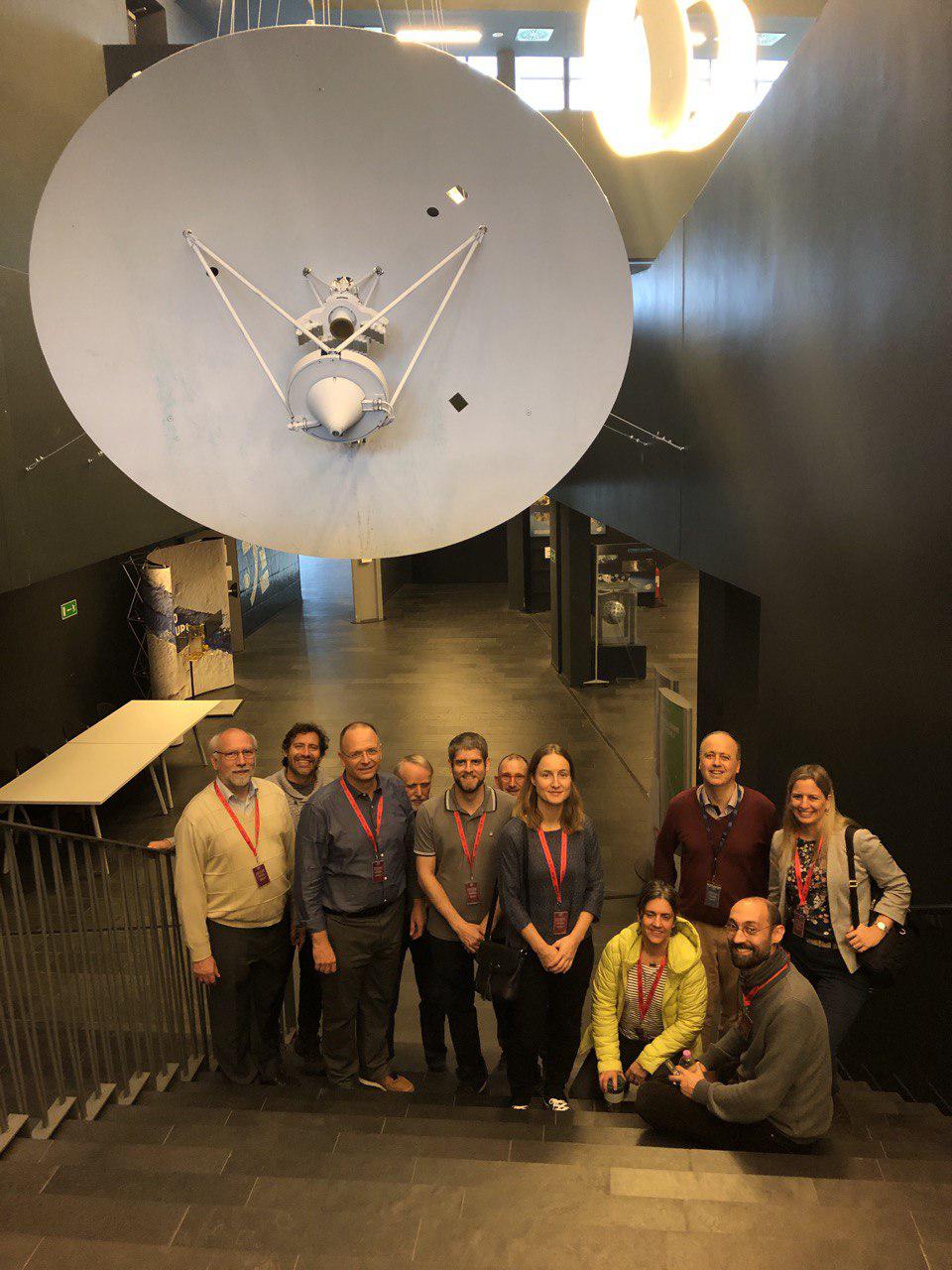 | The #14 CHEOPS SOC meeting @ SSDC SSDC is hosting within the ASI Headquarters the #14 CHEOPS SOC meeting, the operative progress meeting of the Science Operation Center team, which has the responsability to manage the CHEOPS data, when it will be in operation, and create the official Science Archive. SSDC is a member of the SOC group with the responsability to host the unique Science Archive mirror. The group visiting SSDC/ASI include the SOC Development manager from the University of Geneva and the ESA project scientist.
|
| Nov 01, 2019 | GRB 191031D: AGILE/MCAL observations New GCN issued: GCN #26123 (A. Ursi et al.). |
| Oct 31, 2019 | New AGILE Public Data Now Available We are pleased to announce the publication of new AGILE gamma-ray data up to September 30, 2019. We recall that since October 2015 all AGILE-GRID data are published as soon as they are processed and validated. AGILE satellite operations and all AGILE payload functions are nominal. The new public AGILE archive now contains all data from December 1, 2007 up to Sep 30, 2019, i.e. from the start of Cycle-1 up to the on-going Cycle-12. AGILE-GRID event files (EVT) and spacecraft auxiliary (LOG) files are available from the SSDC Multimission Archive (MMIA) webpage for the AGILE Mission. To produce your own maps and run likelihood tasks please download and install the new public AGILE software available here, and follow the User Manual included. The new AGILE public scientific software package AGILE_SW_6.0, adapted from the AGILE Science Tools (TAGNAME = BUILD25), was published on Apr 18, 2019. It includes new scientific software and calibrations, an updated model for the Galactic diffuse gamma-ray emission, a refined procedure for point-like source detection, and the search for extended gamma-ray sources. For an easy on-line AGILE data analysis, the interested user may also query the entire public AGILE level 3 (LV3) archive through the AGILE-LV3 data analysis tool.The AGILE-LV3 tool is meant to be easily comprehensible, and it does not require any install-on-premises software or calibrations. The underlying AGILE software and calibrations will be updated also in the AGILE-LV3 Tool in the next few months. |
| Oct 30, 2019 | AGILE confirmation of the gamma-ray flaring activity from the narrow-line Seyfert1 Galaxy PKS 2004-447 New ATel issued: ATel #13244 (F. Verrecchia et al.). |
| Sep 17, 2019 | Planetary Geological Mapping project with SSDC participation published on GeoMedia A first outline about the geological mapping project led by the Geological Survey of Italy, ISPRA, and with the participation of SSDC-ASI has been published on the May/June 2019 issue of GeoMedia. The main goal of the project is to apply the same cartographic standard rules used in the Italian Geological Mapping Project (CARG Project) to the realization of geological and geomorphological maps of other planets. In the published report, the Eberswalde crater on Mars has been used as prototype area for its great variability of forms of erosion and demolition and the conspicuous literature. The project presented here is included into the H2020-PLANMAP pilot project, to which SSDC is contributing through the MATISSE webtool (and in particular its brand-new version MATISSE 2.0, currently under development and testing). This tool would indeed result to be fundamental for searching and exploring geological maps produced by PLANMAP converting the areas of interest in different formats, from those typical of the classical 2D GIS applications up to those suited for state-of-the-art 3D Virtual Reality environments. |
| Sep 02, 2019 | AGILE detection of renewed gamma-ray activity from the FSRQ PKS 1830-211 New ATel issued: ATel #13065 (F. Lucarelli et al.). |
| Aug 30, 2019 | GRB 190829A: AGILE ratemeters detection and AGILE-MCAL and AGILE-GRID analysis AGILE observed the long GRB 190829A at T0 = 2019-08-29 19:55:53 (UT) first reported by Fermi GBM (GCN #25551) and by Swift (GCN #25552). The scientific ratemeters of the Anti-Coincidence (50-200 keV) and Super-AGILE (SA; 18-60 keV) detected the burst. The GRB 190829A was also seen at VHE gamma-ray energy by H.E.S.S.(GCN 25566). AGILE ratemeters detection and AGILE-MCAL upper limits are reported in GCN #25577 (C. Pittori et al.). AGILE-GRID upper limits and a possible sub-threshold gamma-ray source detection are reported in GCN #25578 (G. Piano et al.). |
| Aug 09, 2019 | AGILE detection of gamma-ray flaring activity from the FSRQ PKS 0454-234 New ATel issued: ATel #13011 (M. Cardillo et al.). |
| Aug 08, 2019 | New AGILE public data and new scientific software package now available We are pleased to announce the publication of new AGILE gamma-ray data up to May 31, 2019 and a new AGILE scientific software package. We recall that since October 2015 all AGILE-GRID data are published as soon as they are processed and validated. AGILE satellite operations and all AGILE payload functions are nominal. The new public AGILE archive now contains all data from December 1, 2007 up to May 31, 2019, i.e. from the start of Cycle-1 up to the on-going Cycle-12. AGILE-GRID event files (EVT) and spacecraft auxiliary (LOG) files are available from the SSDC Multimission Archive (MMIA) webpage for the AGILE Mission. To produce your own maps and run likelihood tasks please download and install the new public AGILE software available here, and follow the User Manual included. The new AGILE public scientific software package AGILE_SW_6.0, adapted from the AGILE Science Tools (TAGNAME = BUILD25), was published on Apr 18, 2019. It includes new scientific software and calibrations, an updated model for the Galactic diffuse gamma-ray emission, a refined procedure for point-like source detection, and the search for extended gamma-ray sources. For an easy on-line AGILE data analysis, the interested user may also query the entire public AGILE level 3 (LV3) archive through the AGILE-LV3 data analysis tool. The AGILE-LV3 tool is meant to be easily comprehensible, and it does not require any install-on-premises software or calibrations. The underlying AGILE software and calibrations will be updated also in the AGILE-LV3 tool in the next few months. |
| Jul 31, 2019 | AGILE follow-up of the high-energy neutrino candidate event IceCube-190730A New ATel issued: ATel #12970 (F. Lucarelli et al.). |
Jul 20, 2019 | The Moon and SSDC: examples from MATISSE Moon Mapping project and Fermi LAT July 20, 2019 marked the 50th anniversary of the first humans landing on the Moon on July 20, 1969 as part of NASA's Apollo 11 lunar mission. Such Apollo 11 mission changed our world and ideas of what is possible by successfully landing humans on the surface of the moon, and bringing them home safely, for the first time in history. During the Apollo program of the 1960s and '70s, NASA sent 9 missions to the Moon, and 6 of them landed astronauts safely on the surface, the only times humans have visited another world. A multinational crew of astronauts, including Luca Parmitano of ESA (European Space Agency) at the second time, is arrived at the International Space Station, with a launch from the Baikonur Cosmodrome in Kazakhstan aboard the Soyuz MS-13 spacecraft, in coincidence with this anniversary. The SSDC activities dedicated to the Moon are mainly those belonging to the "Moon Mapping" research cooperation project, established in 2014 by the Chinese and Italian governments to promote cooperation and exchange between students and scientists from both countries. The Italian Space Agency (ASI) had the responsibility for the coordination of the Italian side of the project and SSDC played a key role in this assignment, in particular during the operational phase, lasted from 2015 to 2017. During this period several universities and research institutes carried on joint activities using data acquired by instruments onboard the Chinese lunar exploration missions Chang'e 1 and Chang'e 2, with major focus on data pre-processing, structural and elemental mapping of the Moon and interaction with the solar wind. The great part of the data have been analyzed and visualized by means of the SSDC tool MATISSE, that allowed to search and map the data directly of the 3D model of the Moon, apart from converting them to 2D formats of widespread use in the scientific community of interest. The final results of the "Moon Mapping" project will be comprised in a textbook, dedicated to the wide public, whose first draft version has been presented during the "2018 Italy-China Week for the Science, Technology and Innovation" (available here in PDF format). Another scientific space mission supported by SSDC, the Fermi Gamma-ray Space Telescope Large Area Telescope (LAT) has produced a novel image of our Moon. If we observe the gamma-ray sky above 100 MeV photon energy the Moon is brighter than the Sun! This surprising vision of the Moon produced by the Fermi LAT is represented, for example, in the image representing the integrated photon intensity significance and based on data collected by the first seven years of operation, reported in 2016 also by the APOD web site. The Fermi LAT doesn't distinguish details on the lunar surface, but a gamma-ray glow consistent with the Moon's size and position in the sky is clearly found at the center of the false-color map. The brightest pixels correspond to the most significant detections of lunar gamma-rays. High-energy charged particles, i.e. cosmic rays, streaming through the Solar System constantly bombard the lunar surface, unprotected by a magnetic field, generating the gamma-ray glow. Because the cosmic rays come from all sides, the gamma-ray Moon is always full and does not go through phases. An updated analysis based on 11-years data is ongoing. The 2016 scientific paper is here. The corresponding INFN news (in Italian) is here.  |
| Jul 12, 2019 | AGILE new High-Energy TGF Catalog We are pleased to announce that the paper: "On The High-Energy Spectral Component and Fine Time Structure of Terrestrial Gamma-Ray Flashes" (Marisaldi et al.) has been accepted for publication in Journal of Geophysical Research, Doi: 10.1029/2019JD030554. The online version of the new AGILE-MCAL High-Energy Terrestrial Gamma-Ray Flashes (TGFs) Catalog is available here. The SSDC web table also gives access to the available TGF light curves and counts details, providing supplementary material to the submitted paper. This third AGILE TGF catalog includes a previously unpublished high-energy dataset of events with energy larger than 30 MeV, observed by the AGILE minicalorimeter (MCAL) from March 2015 to June 2015, in association with lightning measurements. |
| Jun 27, 2019 | Enhanced gamma-ray activity from Cygnus X-3 New ATel issued: ATel #12894 (G. Piano et al.). |
Jun 11, 2019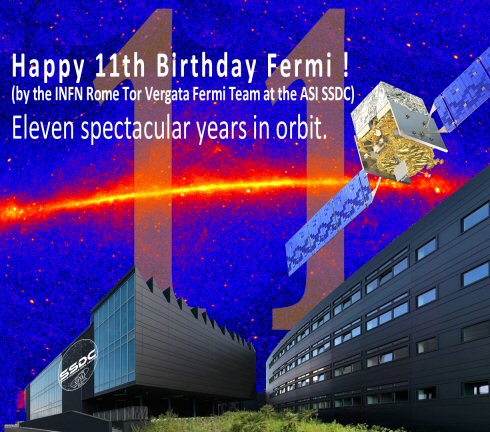 | Happy 11th birthday Fermi Today, Tuesday June 11th, The Fermi Gamma-ray Space Telescope is celebrating it's 11th anniversary of launch in orbit. In NASA Fermi social media pages (www.facebook.com/nasafermi/, twitter.com/nasafermi, www.tumblr.com and other) there is a Happy Birthday message, as well as kicking off 11 days of #FermiScience. This starts on Tuesday June 11th and goes until Friday June 21st, 2019. Each day will be a different highlight. "It has been an incredible 11 years and the excitement continues with new insights and discoveries. Happy Birthday to Fermi!" said Peter Michelson on behalf of the Fermi LAT Collaboration. Stefano Ciprini (INFN) and Dario Gasparrini (INFN) of the Fermi group at the SSDC join these 11th anniversary greetings, expressing their enthusiasm for the participation to Fermi LAT data analysis and science activities, and thank Peter and all the participants to the Fermi Mission.  |
| Jun 06, 2019 | Fermi trigger No 581478912 / GRB 190606A: AGILE/MCAL observations New GCN issued: GCN #24759 (A. Ursi et al.). |
| May 30, 2019 | GRB 190530A: AGILE/GRID analysis New GCN issued: GCN #24683 (F. Verrecchia et al.). |
| May 30, 2019 | GRB 190530A: AGILE-MCAL detection New GCN issued: GCN #24678 (F. Lucarelli et al.). |
| May 06, 2019 | AGILE detection of enhanced gamma-ray emission from the FSRQ PKS 0736+01 region New ATel issued: ATel #12733 (F. Lucarelli et al.). |
| May 02, 2019 | GRB 190501A: AGILE detection and refined analysis of a burst New GCN issued: GCN #24360: GRB 190501A: AGILE/MCAL and scientific ratemeters detection of a burst (A. Ursi et al.) GCN #24361: GRB 190501A: AGILE/GRID detection (F. Lucarelli et al.) GCN #24363: GRB 190501A: refined position from AGILE/GRID analysis (F. Verrecchia et al.) |
| Apr 24, 2019 | New gamma-ray flux record from the FSRQ PKS1830-211 detected by AGILE New ATel issued: ATel #12685 (M. Cardillo et al.). |
| Apr 22, 2019 | Ongoing gamma-ray flaring activity from Cygnus X-3 detected by AGILE New ATel issued: ATel #12678 (G. Piano et al.). |
| Apr 20, 2019 | AGILE detection of enhanced gamma-ray emission from Cygnus X-3 New ATel issued: ATel #12677 (G. Piano et al.). |
| Apr 03, 2019 | The new AGILE-GRID Catalog: 2AGL We are pleased to announce that "The Second AGILE Catalog of Gamma-Ray Sources" (A. Bulgarelli et al., 2019), arXiv:1903.06957, has been accepted for publication in Astronomy & Astrophysics. The new 2AGL incorporates several analysis improvements, including better calibrations, an updated model for the Galactic diffuse gamma-ray emission, and the inclusion of a search for extended gamma-ray sources. The 2AGL Catalog includes 175 high-confidence sources, with a sub-class of 29 "AGILE only" gamma-ray sources that are not present in 1FGL, 2FGL or 3FGL Fermi catalogs. An on-line version of the new 2AGL Catalog, plus some supplementary information, including AGILE skymaps, is now available as an interactive web table at SSDC. After the paper publication on A&A, a new version of the 2AGL webpage (V2.0) at SSDC will also give access to other AGILE data products, such as spectra and light curves. |
| Apr 02, 2019 | AGILE detection of the source AGL J2233-2212 in temporal and space closeness to the IceCube-190331A neutrino event New ATel issued: ATel #12623 (F. Lucarelli et al.). |
| Apr 02, 2019 | AGILE detection of a very strong gamma-ray flaring activity from the FSRQ PKS1830-211 New ATel issued: ATel #12622 (M. Cardillo et al.). |
| Mar 18, 2019 | AGILE detection of renewed gamma-ray flaring activity from the FSRQ PKS1830-211 New ATel issued: ATel #12594 (C. Pittori et al.). |
| Mar 05, 2019 | GRB 190305A: AGILE/MCAL detection of a burst New GCN issued: GCN #23930 (A. Ursi et al., on behalf of the AGILE Team). |
| Mar 01, 2019 | AGILE detection of enhanced gamma-ray activity from the FSRQ PKS 1830-211 New ATel issued: ATel #12541 (F. Lucarelli et al.). |
| Feb 02, 2019 | GRB 190202A: AGILE ratemeters detection New GCN issued: GCN #23835 (F. Verrecchia et al., on behalf of the AGILE Team). |
| Jan 17, 2019 | GRB 190117A: AGILE/MCAL detection of a burst New GCN issued: GCN #23752 (A. Ursi et al., on behalf of the AGILE Team). |
| Jan 15, 2019 | GRB 190114C: AGILE/MCAL detection of a burst New GCN issued: GCN #23712 (A. Ursi et al., on behalf of the AGILE Team). |
| Jan 15, 2019 | New AGILE Public Data Now Available We are pleased to announce the publication of new AGILE gamma-ray data up to November 30, 2018. Since December 28, 2018, the new public AGILE archive now contains all data from December 1, 2007 up to November 30, 2018,i.e. from the start of Cycle-1 up to the end of Cycle-11. AGILE-GRID event files (EVT) and spacecraft auxiliary (LOG) files are available from the SSDC Multimission Archive (MMIA) webpage for the AGILE Mission. We recall that since October 2015 all AGILE-GRID data are published as soon as they are processed and validated. The new AGILE Cycle-11 data were obtained with AGILE observing a large portion of the sky in spinning mode, and they have been processed with the latest available software and calibrations. AGILE satellite operations and all AGILE payload functions are nominal. For an easy on-line AGILE data analysis, the interested user may also query the entire public AGILE level 3 (LV3) archive through the AGILE-LV3 data analysis tool. The AGILE-LV3 web tool is meant to be easily comprehensible, and it does not require any installed software or calibrations. We also plan to update the underlying AGILE software and calibrations in the next few months. Stay tuned! |
| Jan 03, 2019 | GRB 190103A: AGILE/MCAL detection of a burst New GCN issued: GCN #23600 (A. Ursi et al., on behalf of the AGILE Team). |
| Dec 25, 2018 | GRB 181225A: AGILE/MCAL detection of a burst New GCN issued: GCN #23560 (A. Ursi et al., on behalf of the AGILE Team). |
| Nov 22, 2018 | GRB 181121A: AGILE/MCAL detection of a burst New GCN issued: GCN #23429 (A. Ursi et al., on behalf of the AGILE Team). |
| Nov 13, 2018 | AGILE confirmation of flaring activity from the new gamma-ray source Fermi J1153-1124 New ATel issued: ATel #12208 (F. Lucarelli et al.). |
| Nov 05, 2018 | NASA Dawn mission ends after 11 years NASA Dawn mission, the first one to explore two different objects of the main asteroid belt (Vesta and Ceres), ended few days ago after missing two scheduled communication sessions with NASA's Deep Space Network on Wednesday, Oct. 31, and Thursday, Nov. 1. The mission lasted 11 years and, among its precious scientific results, those regarding the composition of Vesta, that has been confirmed as the parent body of the HED meteorites and the discovery of a large carbonates deposit forming a peculiar bright spot inside the Occator crater of Ceres can be cited. SSDC contributions to Dawn are twofolds: the availability of the VIR imaging spectrometer data through the MATISSE tool, and the participation of Marco Giardino (SSDC ITC Manager) to the mission Dawn Archive Working Group. The VIR-Dawn data available through MATISSE have been also used for educational purposes, an activity now part of the curriculum of the "Introduction to Modern Astro-Plasma Physics" course of the East Windsor Regional School District in Hightstown, NJ (USA). |
| Oct 29, 2018 | AGILE is detecting a renewed and intense gamma-ray flare above 100 MeV from the direction of the Crab Nebula. New ATel issued: ATel #12148 (A. Bulgarelli et al.). |
| Oct 18, 2018 | AGILE detection of enhanced gamma-ray activity from the Crab Nebula New ATel issued: ATel #12123 (M. Cardillo et al.) and Erratum: ATel #12125 |
| Oct 12, 2018 | Ongoing episode of enhanced gamma-ray emission from the Crab Nebula detected by AGILE New ATel issued: ATel #12105 (F. Lucarelli et al.). |
| Oct 10, 2018 | SSDC interactive analysis tools among US Students: an american public school pioneer project As part of the collaborative efforts with SSDC, Dr. Franco Paoletti incorporated two remote space data analysis activities in the curriculum of the "Introduction to Modern Astro-Plasma Physics" course, recently approved by the Board of Education of the East Windsor Regional School District in Hightstown, NJ (USA). The two activities will see students analyzing data coming from both Solar System exploration and high-energy observations of the Universe, and will be performed using the SSDC interactive online analysis tools: MATISSE for Solar System observations and AGILE-LV3 for the gamma-ray AGILE satellite data. The activities point to reproduce published scientific results, such as the characterization of dark material on the Vesta asteroid (e.g. Palomba et al., 2014) and the analysis of a couple of exceptional bright flares seen in gamma-rays from monster black holes in distant galaxies (e.g. Astronomer's Telegrams: ATel #9186 and ATel #7631). The final goal is to provide the students with knowledge, skills, and competences required to correctly use tools specifically designed at our data center for professional researchers, and to get a better understanding of the day to day work of an astrophysicist. |
| Sep 16, 2018 | GRB 180914B: AGILE/MCAL refined analysis New GCN issued: GCN #23242 (A. Ursi et al., on behalf of the AGILE Team). |
| Sep 15, 2018 | GRB 180914B: AGILE/GRID detection New GCN issued: GCN #23231 (F. Verrecchia et al., on behalf of the AGILE Team). |
| Sep 15, 2018 | GRB 180914B: AGILE/MCAL detection of a burst New GCN issued: GCN #23226 (A. Ursi et al., on behalf of the AGILE Team). |
| Sep 11, 2018 | AGILE detection of a prolonged enhanced gamma-ray emission from the blazar 4C +38.41 New ATel issued: ATel #12026 (M. Cardillo et al.). |
| Sep 03, 2018 | AGILE detection of a gamma-ray flare from the high-redshift FSRQ 4C +38.41 New ATel issued: ATel #12005 (G. Piano et al.). |
| Jul 20, 2018 | AGILE/MCAL detection of GRB 180720A New GCN issued: GCN #22970 (A. Ursi et al., on behalf of the AGILE Team). |
| Jul 04, 2018 | AGILE detection of prolonged and intense gamma-ray emission from Cygnus X-3 New ATel issued: ATel #11814 (G. Piano et al.). |
| Jul 02, 2018 | AGILE detection of enhanced gamma-ray emission from Cygnus X-3 New ATel issued: ATel #11804 (G. Piano et al.). |
| Jun 26, 2018 | 16th AGILE Scientific Workshop: presentations available We are pleased to announce that all the presentations authorized for distribution given during the 16th AGILE Workshop "Fast and AGILE: Multimessenger Astrophysics and Beyond" (ASI, 18 May, 2018), are now publicly available. The slides (pdf format) may be viewed, together with the final program and the recorded videos of the event, at the Workshop web site. On behalf of the Workshop SOC and LOC, we thank very much all the participants. |
| Jun 21, 2018 | New AGILE Public Data now available up to May 31, 2018 We announce the publication of new AGILE gamma-ray data. The public AGILE archive now contains all data from December 1, 2007 to May 31, 2018, i.e. from the start of Cycle-1 up to the on-going Cycle-11. AGILE-GRID event files (EVT) and spacecraft auxiliary (LOG) files are available from the SSDC Multimission Archive (MMIA) webpage for the AGILE Mission. We recall that, starting from October 2015 the standard one-year proprietary period was eliminated, and all AGILE-GRID data are now published as soon as they are processed and validated. The new public AGILE Cycle-11 data were obtained with AGILE observing a large portion of the sky in spinning mode, and they have been processed with the latest public software and calibrations. For an easy on-line AGILE data analysis, we recall that the interested user may also query the entire public AGILE level 3 (LV3) archive through the AGILE-LV3 data analysis tool. |
| Jun 11, 2018 | MATISSE v1.5 online with a better 3D online visualization method A new version of MATISSE (https://tools.ssdc.asi.it/matisse.jsp) has been released, with the major update regarding the 3D online visualization method. Thanks to the use of a new javascript (https://kitware.github.io/vtk-js/) it is now possible to directly view online the 3D high-resolution models for the great part of the MATISSE targets, including the comet 67P, Vesta, Ceres and Venus, thus overtaking the limitation for larger objects present with the previous technology used. This version has been labeled v1.5 and comes after the implementation of the SAMP protocol to interoperate with VESPA datasets (v1.3) and the addition of the 1 and 2 micron spectral parameters for VIR-Dawn observations of Vesta (v1.4). |
| Jun 05, 2018 | AGILE detection of enhanced gamma-ray emission from the blazar 3C 279 New ATel issued: ATel #11687 (M. Cardillo et al.). |
| May 29, 2018 | AGILE/MCAL detection of GRB 180529 and a possible precursor New GCN issued: GCN #22741 (A. Ursi et al., on behalf of the AGILE Team). |
| Apr 23, 2018 | NASA's Transiting Exoplanet Survey Satellite (TESS) mission has been launched The NASA's Transiting Exoplanet Survey Satellite (TESS) mission has been launched on April 18 aboard a SpaceX Falcon 9 rocket. The mission will be devoted to the discovery of habitable planets around the brightest stars in the solar system neighbourhood through the detection of planetary transits during a two years survey. The mission will exchange its results with the ESA small mission CHEOPS that will be lanched at the end of 2018, dedicated to characterize a sample of systems known to host exoplanets but also to improve parameters of newly discovered ones. |
| Apr 20, 2018 | AGILE detection of prolonged gamma-ray emission from the Galactic Nova ASASSN-18fv New ATel issued: ATel #11553 (G. Piano et al.). |
| Apr 06, 2018 | New AGILE Public Data Now Available up to December 31, 2017 We are pleased to announce the publication of new AGILE gamma-ray data. The public AGILE archive now contains all data from December 1, 2007 to December 31, 2017, i.e. from the start of Cycle-1 up to the start of the on-going Cycle-11. AGILE-GRID event files (EVT) and spacecraft auxiliary (LOG) files are available from the SSDC Multimission Archive (MMIA) webpage for the AGILE Mission. We recall that, starting from October 2015 the standard one-year proprietary period was eliminated, and all AGILE-GRID data are now published as soon as they are processed and validated. The new AGILE Cycle-10 and Cycle-11 data which become public today were obtained with AGILE observing a large portion of the sky in spinning mode, and they have been processed with the latest available software and calibrations. For an easy on-line AGILE data analysis, the interested user may also query the entire public AGILE level 3 (LV3) archive through the AGILE-LV3 data analysis tool. By simply entering in the AGILE-LV3 web form the source name or coordinates of the object of interest and clicking on one of the 'Interactive Analysis' buttons on the query-result table, the user can execute the official AGILE Maximum Likelihood (ML) analysis in each available time bin of the chosen duration (default is 28 days). By selecting more than one time bin, with a click of the mouse it is also possible to generate in few minutes the complete gamma-ray light curve above 100 MeV over the selected period with default analysis parameters. The AGILE-LV3 tool is meant to be easily comprehensible, even without many instructions and it does not require any install-on-premises software or calibrations. Your feedback will be greatly appreciated. |
| Mar 13, 2018 | AGILE confirms enhanced gamma-ray emission from the Crab Nebula New ATel issued: ATel #11415 (A. Bulgarelli et al.). |
| Feb 10, 2018 | Fermi LAT detection of a GeV gamma-ray flare from the distant blazar PKS 0226-559 New ATel posted by the Fermi team at SSDC: ATel #11283 |
| Jan 24, 2018 | AGILE observations of gamma-ray emission from the blazar PKS B1424-418 New ATel issued: ATel #11222 (A. Ursi et al.). |
| Jan 19, 2018 | AGILE observations of intense gamma-ray emission from the blazar 3C 279 New ATel issued: ATel #11200 (F. Lucarelli et al.). |
| Jan 12, 2018 | GRB 180111A: AGILE/MCAL detection New GCN issued: GCN #22321 (F. Verrecchia et al., on behalf of the AGILE Team). |
| Jan 04, 2018 | AGILE detection of a rebrightening of the gamma-ray source AGL J2251-1239 New ATel issued: ATel #11127 (G. Piano et al.). |
| Dec 31, 2017 | AGILE detection of a rapid gamma-ray flare from the blazar 3C 279 New ATel issued: ATel #11115 (C. Pittori et al.). |
| Dec 27, 2017 | GRB 171227A: AGILE/MCAL detection New GCN issued: GCN #22288 (F. Verrecchia et al., on behalf of the AGILE Team). |
| Dec 18, 2017 | AGILE detection of gamma-ray emission from the FSRQ Ton 0599 New ATel issued: ATel #11073 (A. Bulgarelli et al.). |
| Dec 09, 2017 | AGILE detection of increasing gamma-ray activity from CTA 102 New ATel issued: ATel #11045 (F. Lucarelli et al.). |
| Dec 08, 2017 | AGILE detection of gamma-ray activity from the source AGL J2251-1239 New ATel issued: ATel #11043 (F. Lucarelli et al.). |
| Nov 24, 2017 | Enhanced gamma-ray emission from the FSRQ PKS 0131-522 New ATel issued: ATel #11003 (G. Piano et al.). |
| Nov 13, 2017 | Early AGILE gamma-ray observations of the recent Glitch in the Crab Pulsar New ATel issued: ATel #10965 (F. Verrecchia et al.). |
| Nov 08, 2017 | AGILE detection of transient gamma-ray activity from the FSRQ Ton 599 New ATel issued: ATel #10937 (G. Piano et al.). |
| Oct 31, 2017 | Fermi LAT detection of a GeV gamma-ray flare from blazar CGRaBS J0809+5341 (87GB 080551.6+535010) New ATel posted by the Fermi team at SSDC: ATel #10905 |
| Sep 29, 2017 | AGILE confirmation of gamma-ray activity from the IceCube-170922A error region New ATel issued: ATel #10801 (F. Lucarelli et al.). |
| Aug 25, 2017 | GRB 170825A: AGILE/MCAL Detection New GCN issued: GCN #21689 (M. Cardillo et al., on behalf of the AGILE Team). |
| Aug 07, 2017 | AGILE detection of an unknown gamma-ray source AGL J1412-0522 New ATel issued: ATel #10623 (G. Piano et al.). |
| Jul 31, 2017 | AGILE Cycle-10 Public Data Now Available and New On-line AGILE-LV3 Analysis Tool AGILE Cycle-10 data up to the June 30, 2017 are now publicly available, according to the current AGILE scientific data policy. Starting from October 2015 all AGILE-GRID data are published as soon as they are processed and validated. The new public AGILE archives now contain all data from the start of Cycle-1 on December 1, 2007 Observation Block (OB) 4900, up to the first half of Cycle-10, OB 26500. AGILE Level 2 archive (STD1) of event lists and ancillary files is available from the Multimission Archive (MMIA) webpage for the AGILE Mission.. We are pleased to announce also the publication of the AGILE-LV3 data analysis tool, which provides an easy web interface for interactive on-line analysis on AGILE-GRID data, based on the official AGILE scientific software release. It does not require any install-on-premises software or calibrations. The user may query the entire new public AGILE Level 3 archive (STD1Kal) of counts, exposure and diffuse gamma-ray maps by simply entering in the AGILE-LV3 web form the source name or coordinates of the object of interest. From the query-result table, by clicking on one of the 'Interactive Analysis' buttons the user can execute the AGILE Maximum Likelihood (ML) analysis at the source coordinates. By selecting more than one time bin, with a click of the mouse it is also possible to generate in few minutes the complete gamma-ray light curve above 100 MeV over the selected period with default analysis parameters (default is 28-day timebins). |
| Jul 20, 2017 | Fermi and Swift discovery of GeV gamma-ray and X-ray emission from the blazar S4 0444+63 New ATel posted by the Fermi team at SSDC: ATel #10584 |
| Jul 07, 2017 | AGILE detection of a gamma-ray flare from the blazar 3C 279 New ATel issued: ATel #10563 (A. Bulgarelli et al.). |
| Jul 07, 2017 | Renewed gamma-ray emission from the FSRQ CTA 102 detected by AGILE New ATel issued: ATel #10560 (A. Bulgarelli et al.). |
| Jun 06, 2017 | AGILE detection of enhanced gamma-ray activity from BL Lacertae New ATel issued: ATel #10469 (G. Piano et al.). |
| May 18, 2017 | Enhanced gamma-ray emission from the FSRQ CTA 102 detected by AGILE New ATel issued: ATel #10386 (G. Minervini et al.). |
| Apr 18, 2017 | AGILE detection of enhanced gamma-ray activity from a new unidentified source, AGL J0523+0646 New ATel issued: ATel #10282 (F. Lucarelli et al.). |
| Mar 17, 2017 | Enhanced Gamma-Ray Emission from the Microquasar Cygnus X-3 Detected by AGILE New ATel issued: ATel #10179 (G. Piano et al.). |
| Mar 01, 2017 | AGILE Detection of Enhanced Gamma-Ray Emission from the Microquasar Cygnus X-3 New ATel issued: ATel #10138 (G. Piano et al.). |
| Feb 27, 2017 | All AGILE Data up to the end of Cycle-9 are now publicly available In 2015 the AGILE Mission Board suggested a change in the AGILE gamma-ray scientific data policy. The standard one-year proprietary period requirement was eliminated, and starting from October 2015 all AGILE-GRID data are published as soon as they are processed and validated. The new public AGILE archive now contains all data from the start of Cycle-1 on December 1, 2007 Observation Block (OB) 4900, up to the end of Cycle-9 on November 30, 2016, OB 25100. Data are available from the ASDC Multimission Archive (MMIA) webpage for the AGILE Mission.. The query to the archive give access to all AGILE public data through an interactive webpage including the ASDC "Interactive Analysis" tool. The tool allows web users to preview the AGILE data fields, and to perform a preliminary analysis around a chosen sky position. |
| Jan 27, 2017 | GRB 170127C (Fermi/GBM trigger 507173752): AGILE analysis New GCN issued: GCN #20545 (A. Ursi et al., on behalf of the AGILE Team). |
| Jan 25, 2017 | GRB 170115B: AGILE/SuperAGILE localisation New GCN issued: GCN #20525 (Y. Evangelista et al., on behalf of the AGILE Team). |
| Jan 17, 2017 | GRB 170115B: AGILE detection New GCN issued: GCN #20474 (F. Verrecchia et al., on behalf of the AGILE team). |
| Jan 04, 2017 | AGILE confirmation of enhanced gamma-ray activity from NGC 1275 New ATel issued: ATel #9934 (F. Lucarelli et al.). |
| Dec 29, 2016 | AGILE detection of renewed and intense gamma-ray flaring from the FSRQ CTA 102 New ATel issued: ATel #9911 (A. Bulgarelli et al.). |
| Dec 14, 2016 | AGILE detection of intense gamma-ray emission from the FSRQ CTA102 New ATel issued: ATel #9863 (A. Bulgarelli et al.). |
| Dec 09, 2016 | Swift observation of strong X-ray and UV activity of CTA 102 New ATel issued: ATel #9841 (S. Ciprini et al.). |
| Dec 09, 2016 | AGILE detection of a new episode of enhanced gamma-ray emission from the FSRQ CTA102 New ATel issued: ATel #9840 (F. Verrecchia et al.). |
| Nov 24, 2016 | AGILE detects renewed gamma-ray emission from the FSRQ CTA 102 New ATel issued: ATel #9788 (A. Bulgarelli et al.). |
| Nov 11, 2016 | AGILE detection of enhanced gamma-ray emission from the FSRQ CTA 102 New ATel issued: ATel #9743 (G. Minervini et al.). |
| Oct 14, 2016 | AGILE detection of transient emission from the FSRQ TXS 0907+230 region New ATel issued: ATel #9623 (P. Munar-Adrover et al.). |
| Oct 12, 2016 | New episode of enhanced gamma-ray emission from the Crab Nebula detected by AGILE New ATel issued: ATel #9617 (P. Munar-Adrover et al.). |
| Oct 3, 2016 | Enhanced gamma-ray emission from the Crab Nebula detected by AGILE New ATel issued: ATel #9586 (A. Bulgarelli et al.). |
| Sep 21, 2016 | PKS 1510-089 in high gamma-ray state as detected by AGILE New ATel issued: ATel #9520 (G. Minervini et al.). |
| Sep 4, 2016 | Renewed Gamma-Ray Emission from the blazar PKS 1510-089 Detected by AGILE New ATel issued: ATel #9450 (P. Munar-Adrover et al.). |
| Aug 30, 2016 | AGILE Detection of Gamma-Ray Emission from the Microquasar Cygnus X-3 New ATel issued: ATel #9429 (G. Piano et al.). |
| Aug 09, 2016 | Renewed gamma-ray activity from the blazar PKS 1510-089 detected by AGILE New ATel issued: ATel #9350 (C. Pittori et al.). |
| Aug 01, 2016 | AGILE follow-up of the neutrino ICECUBE-160731 event New ATel issued: ATel #9295 (F. Lucarelli et al.). |
| Jul 11, 2016 | AGILE detection of enhanced gamma-ray emission from the FSRQ 4C +01.02 New ATel issued: ATel #9232 (F. Verrecchia et al.). |
| June 28, 2016 | ASDC participation to high-school outreach program In mid June 2016, twenty high-school students from Liceo Classico "Aristofane" and Liceo Classico "Giulio Cesare" of Rome, spent one week at the Headquarters of the Italian Space Agency (ASI) to participate to the "Alternanza Scuola-Lavoro" (School and Work synergy) project, according to the new indications of the Italian Ministry for Education, University and Research (MIUR) aimed at giving a real work experience to high-school students. On June 17, 2016, the students used ASDC tools to analyze data coming from both Solar System exploration and Universe observation missions, under the guide of Stefano Ciprini, Dario Gasparrini, Fabrizio Lucarelli, Carlotta Pittori and Angelo Zinzi. After a brief introduction by Ciprini and Pittori on the astrophysical observations of the Universe, and by Zinzi on the exploration of the Solar System, the students were divided into four groups of five persons each. The students chose their preferred field of analysis, so that two groups used planetology ASDC tools and the other two groups used Universe observation ASDC tools. 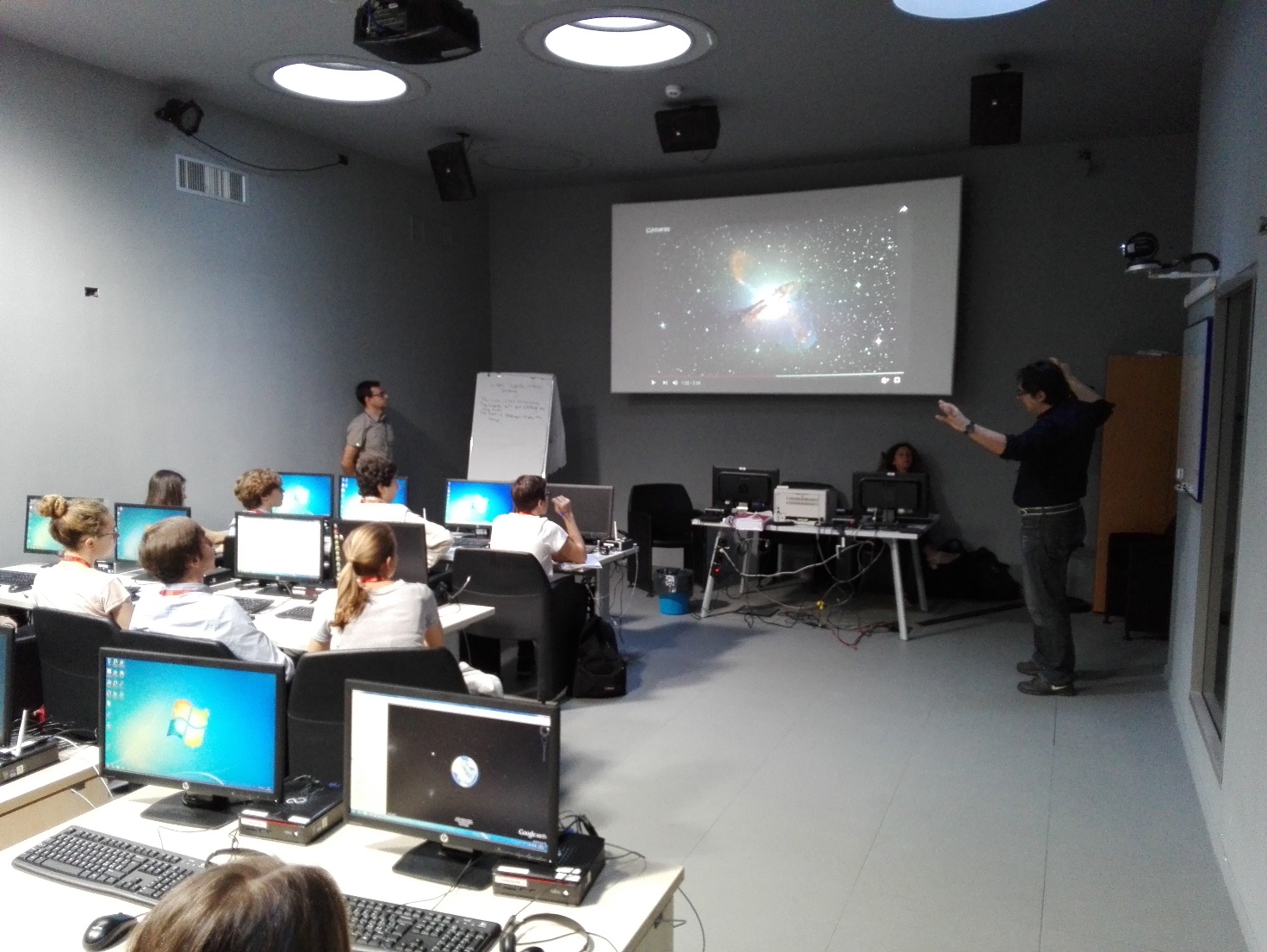 Stefano Ciprini and Carlotta Pittori introducing the subject of Active Galactic Nuclei (AGN) observations. 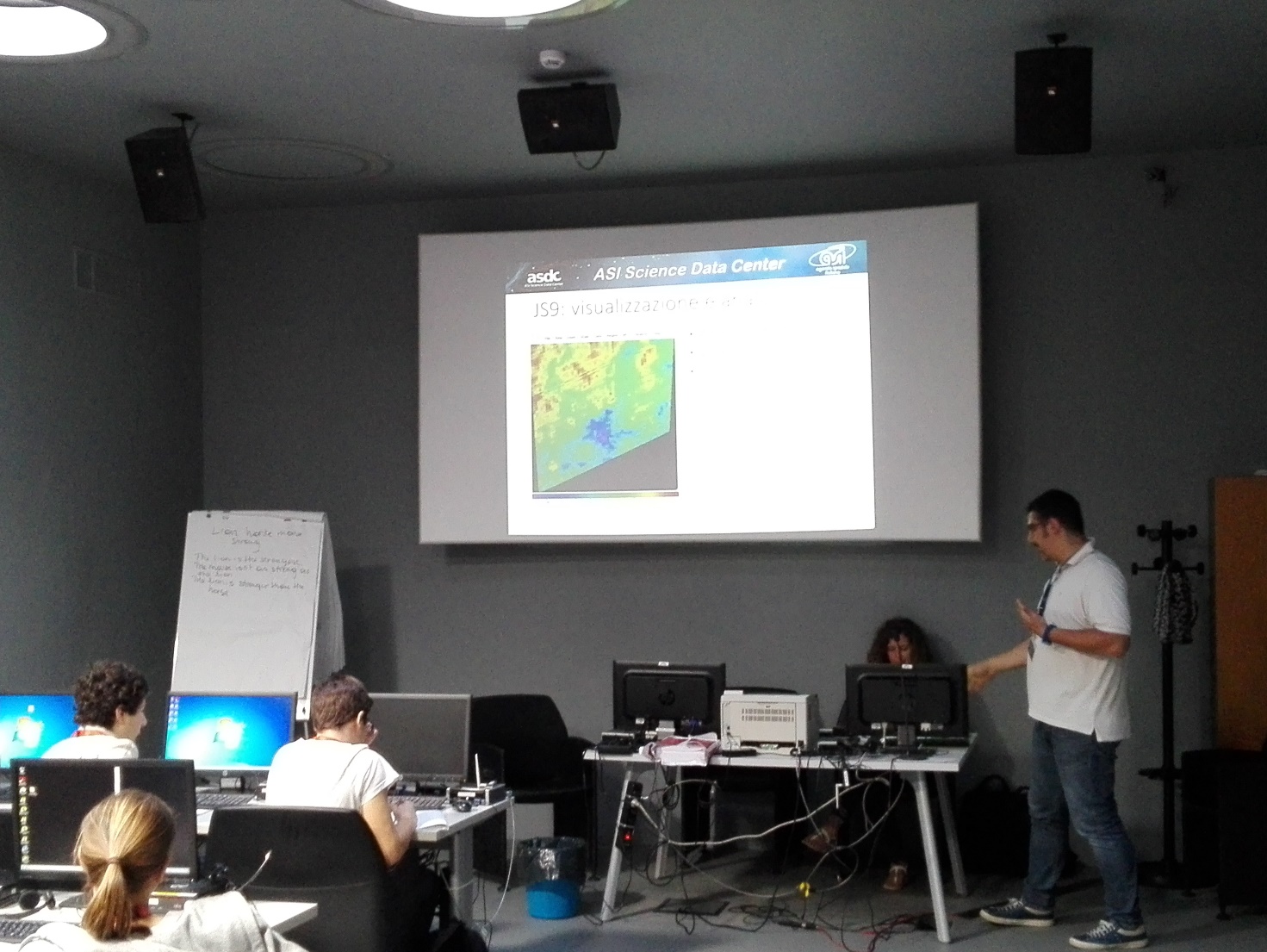 Angelo Zinzi talking about the use of infrared spectra for mineralogic analysis on asteroids. The planetological analysis was carried out by looking at data acquired by VIR spectrometer onboard NASA Dawn mission over the asteroid Vesta. The search for the data was conducted using the ASDC tool MATISSE, whose output (in FITS format) was then passed on to the JS9 tool to evaluate the 1.98 μm band depth, on the basis of the work by Palomba et al. (2015) devoted to the characterization of dark units on Vesta. 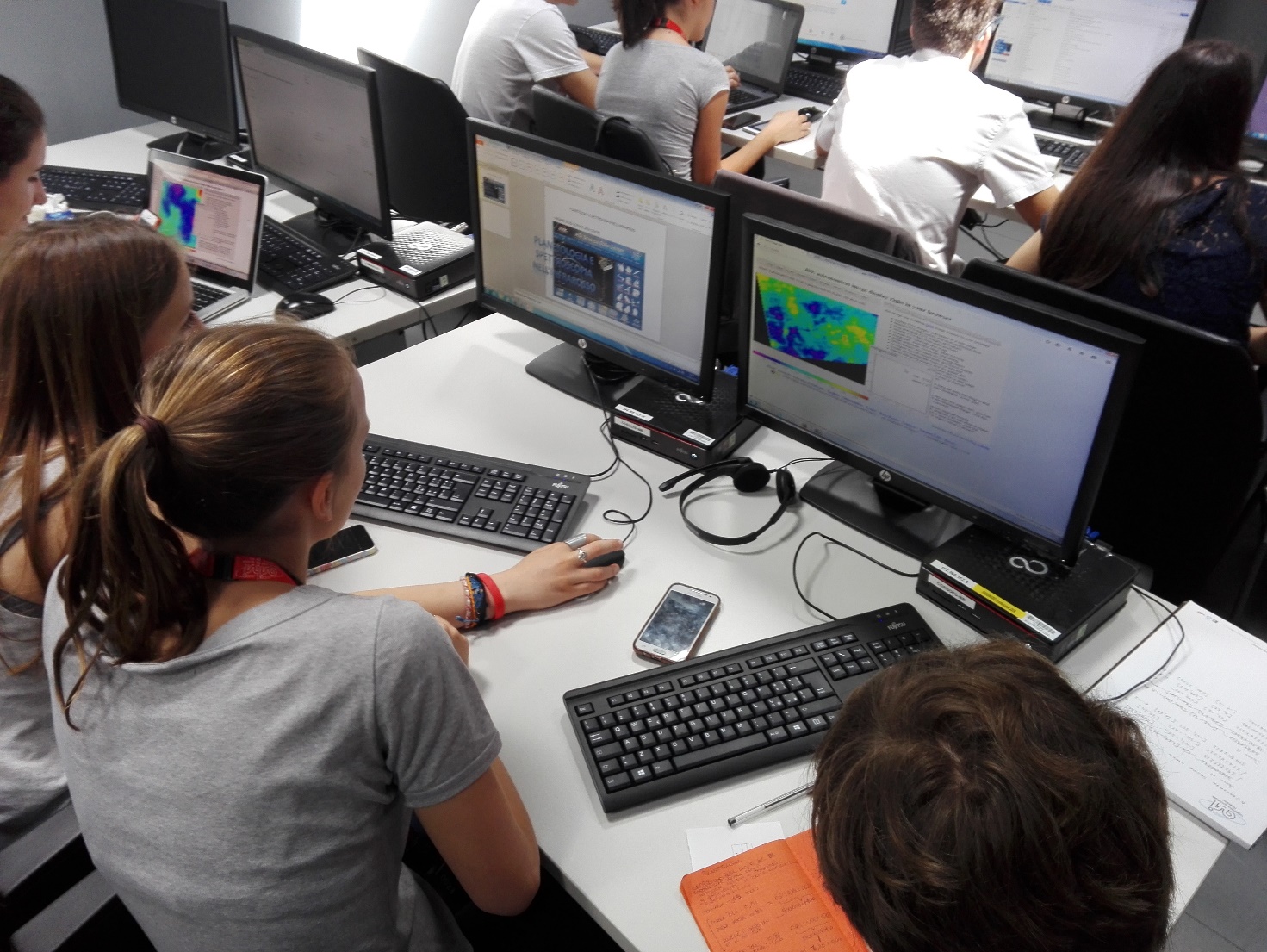 Students working with planetological data The groups of students who chose to use the Universe observation tools from ASDC had to replicate the analysis of a couple of exceptional bright flares seen in gamma-rays from the AGILE satellite from the two AGNs PKS 1510-059 and 3C 279. Starting from the AGILE Astronomer's Telegrams (ATels) #6366 and #7631, announcing the dramatic gamma-ray enhancements, they identified the period of AGN activity and searched the correspondent AGILE data from the MMIA Archive. For this special occasion, we provided the students with access to the AGILE LV3 online analysis tool accessible through the ASDC web pages (the tool will soon become public). They very easily familiarized with the tool and, by means of that, they were able to produce a sky map and a light curve of the two sources, showing the rapid increase in gamma-ray flux observed in correspondence of the period reported in the ATels. At the end of the day, the students compiled a "Daily Log" with all the capabilities acquired during the work. 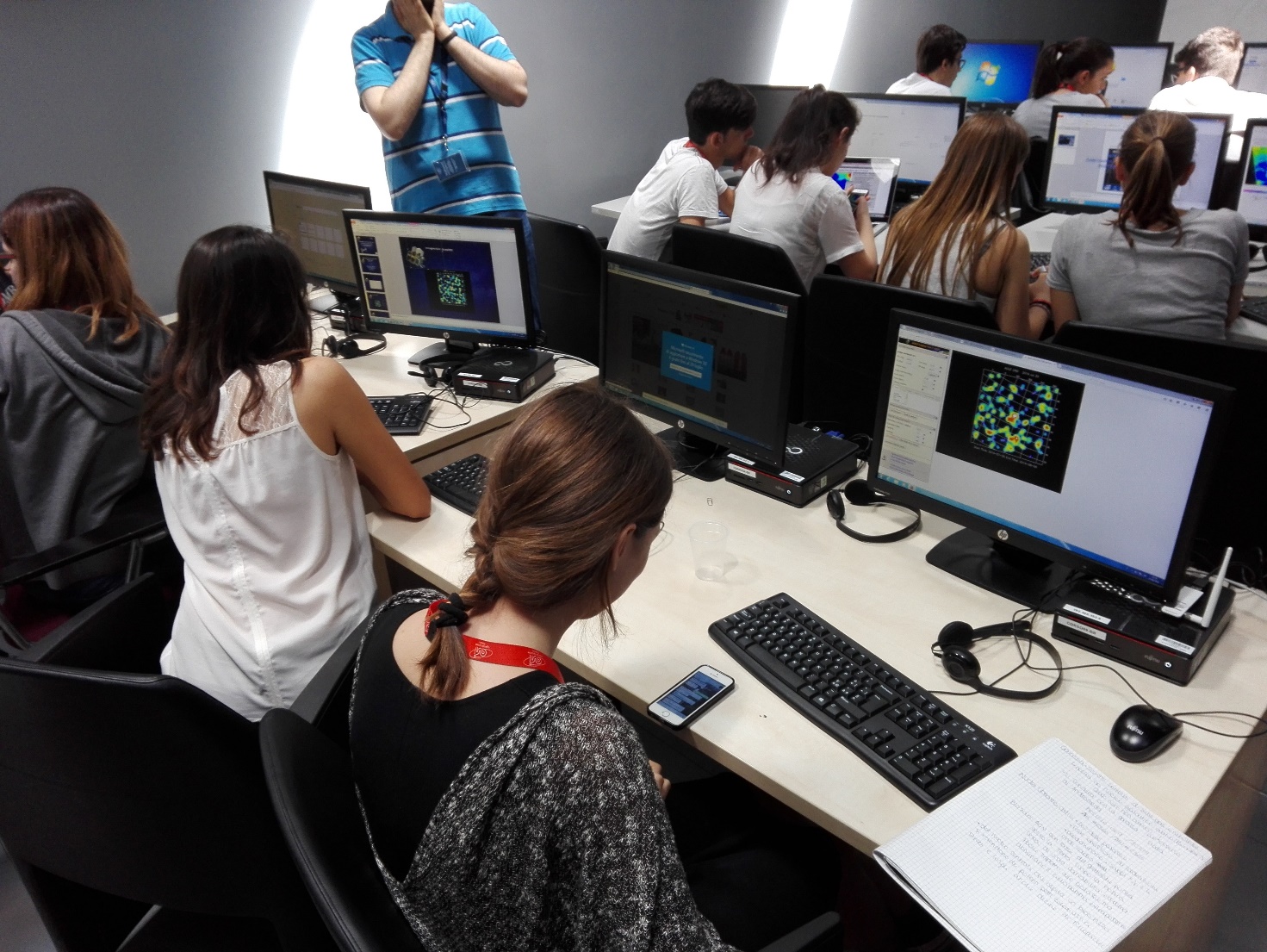 Students analysing AGN data |
| June 28, 2016 | MATISSE on Astrobetter A post about MATISSE, the ASDC web-tool for the exploitation of planetary exploration data, has been recently published on the Astrobetter blog. Accordingly to the goal of Astrobetter to give "tips and tricks for professional astronomers", in the aforementioned post the main characteristics of MATISSE have been described together with an example of usage of the tool. In particular the analysis of the thermal infrared part of the spectrum of asteroid Vesta acquired by VIR instrument aboard NASA Dawn mission has been shown. As these data are publicly available the example can be easily replicated by everyone accessing MATISSE. |
| Jun 24, 2016 | A gamma-ray flare from 3C 454.3 detected by AGILE New ATel issued: ATel #9186 (G. Munar-Adrover et al.). 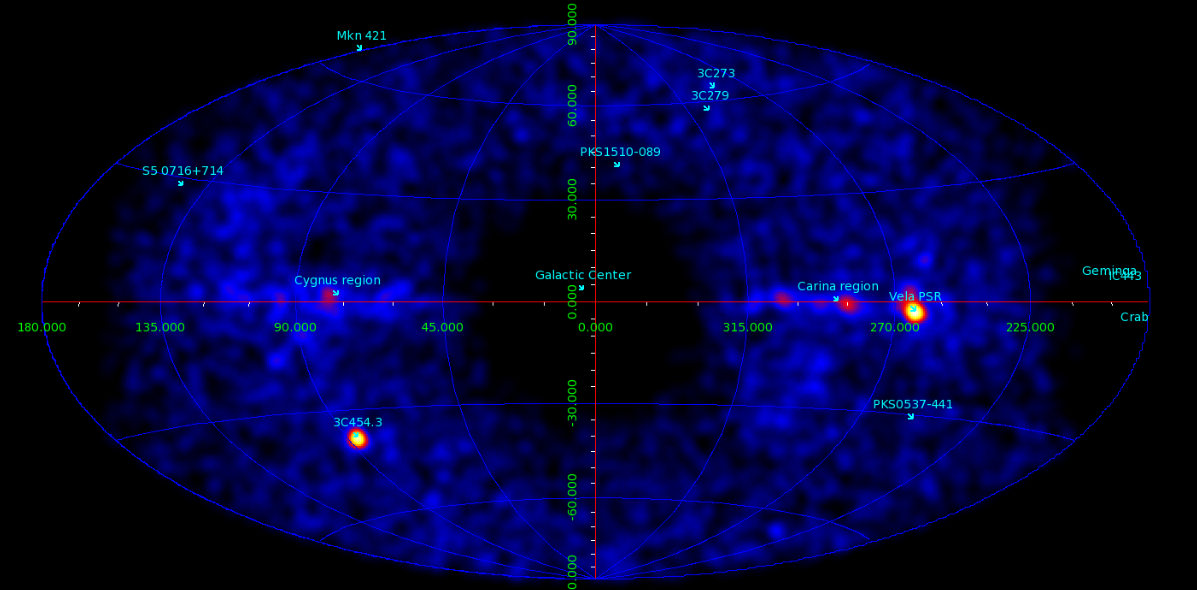 AGILE-GRID sky map (E >100 MeV) in Aitoff projection during the period 22-24 June, 2016, showing the 3C 454.3 flare. |
| Jun 21, 2016 | Renewed gamma-ray activity of the Blazar 3C 454.3 detected by AGILE New ATel issued: ATel #9176 (A. Bulgarelli et al.). |
| Jun 18, 2016 | AGILE confirmation of enhanced gamma-ray activity from the Blazar 1ES 1959+650 New ATel issued: ATel #9168 (F. Lucarelli et al.). |
| Jun 15, 2016 | AGILE detection of increasing gamma-ray activity from the Blazar 3C 454.3 New ATel issued: ATel #9157 (F. Lucarelli et al.). |
| June 14, 2016 | Fermi Gamma-ray Space Telescope's 8th Birthday Happy birthday, Fermi! Here below the official message to members and affiliated scientists of the Fermi Large Area Telescope (LAT) Collaboration by the Dr. Peter Michelson, professor of Physics at Stanford University, California, USA and Principal Investigator for the LAT on the Fermi spacecraft. <<Dear Colleagues, The Fermi Gamma-ray Space Telescope (then known as GLAST) was launched on June 11, 2008 at just past noon (EDT). We should all celebrate the incredible successes of this observatory over the past 8 years. It true has transformed our view of the high-energy Universe and continues to make discoveries about our Universe. Congratulations to all members of the Fermi LAT Collaboration and thank you for your incredible contributions. I am so proud to be a member of such a wonderful collaboration. All the Best, Peter>>. In these days the gamma-ray mission Fermi, and the other flying NASA missions for the observation of the X-ray sky (Swift, NuSTAR), have received the positive green light to the extension of their mission budget funding and operation lifetime at least to 2018. The NASA has announced this at the end of its evaluation procedure, the Senior Review 2016, on June 9, 2016. The Fermi mission operations have been extended until 2018, with a request to plan for operations through at least 2020. An ASI/INFN/INAF joint public statement is available here. The ASDC is contributing to the Fermi mission by maintaining a mirror data archive of the LAT high level science data, participating in the data validation, science data analysis, software tools, in the analysis, construction, distribution of the LAT source catalogs. Further activities include the exploitation of the LAT data in connection with multifrequency and multi-mission data, and the contribution to services, duties and coordinations within the LAT experiment. 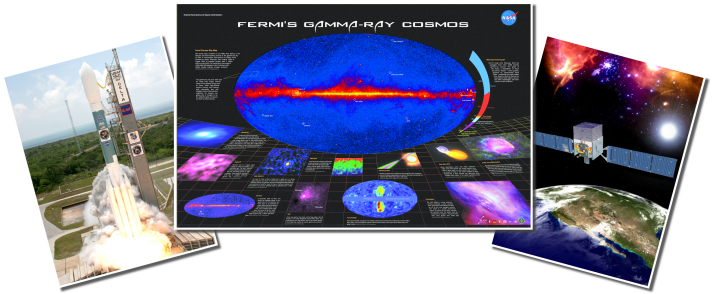 |
| May 23, 2016 | The 4th Moon Mapping project Workshop On May 10 and 11 2016 the 4th workshop dedicated to the Italian-Chinese project known as "Moon Mapping" took place at the ASI headquarters in Rome. The event started with the joined signature of the Intellectual Property agreement by ASI President R. Battiston and COSE vice-president G. Xie. More than 30 researchers and students from Italy and China involved in the study of the Moon by means of data acquired by instruments onboard the Chinese Chang'e 1 and Chang'e 2 missions participated to the meeting. The main topics of the joint project (i.e., Map of the solar wind ion, Structure map of the Moon, Map of elements distribution and Establishment of 3D digital visualization system) have been actively discussed together with the presentation of external activities related to the exploration of the Moon and of the Solar System in general. During the visit to Italy, the Chinese delegation also visited the INFN National Laboratories in Frascati and the facilities of Thales Alenia Space and ALTEC in Turin. Detailed information about the Moon Mapping project can be found on https://solarsystem.ssdc.asi.it/moonmapping  ASI President R. Battiston and COSE vice president G. Xie while signing the Intellectual Property agreement  |
| Apr 29, 2016 | A novel image of the Moon, based on data collected by the Fermi Gamma-ray Space Telescope's Large Area Telescope (LAT) instrument during its first seven years of operation (2008-2015)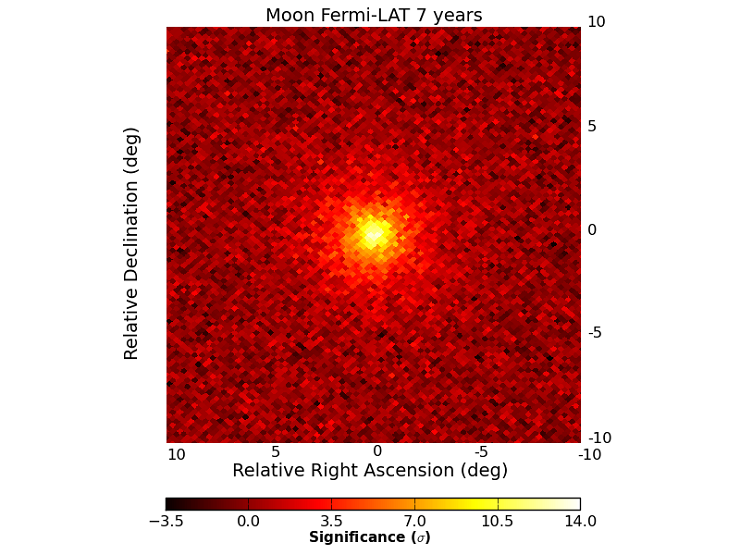 If you could only see gamma-rays, photons with up to a billion or more times the energy of visible light, the Moon would be brighter than the Sun! That startling notion underlies this novel image of the Moon, based on data collected by the Fermi Gamma-ray Space Telescope's Large Area Telescope (LAT) instrument during its first seven years of operation (2008-2015). Fermi's gamma-ray vision doesn't distinguish details on the lunar surface, but a gamma-ray glow consistent with the Moon's size and position is clearly found at the center of the false color map. The brightest pixels correspond to the most significant detections of lunar gamma-rays. Why is the gamma-ray Moon so bright? High-energy charged particles streaming through the Solar System known as cosmic rays constantly bombard the lunar surface, unprotected by a magnetic field, generating the gamma-ray glow. Because the cosmic rays come from all sides, the gamma-ray Moon is always full and does not go through phases. The first gamma-ray image of the Moon was captured by the EGRET instrument onboard the Compton Gamma-ray Observatory, launched 25 years ago. |
| Apr 20, 2016 | AGILE detection of enhanced gamma-ray activity from a new unidentified source at high Galactic latitude, AGLJ0917+1511 New ATel issued: ATel #8974 (F. Lucarelli et al.). |
| Apr 19, 2016 | Enhanced gamma-ray emission from the microquasar Cygnus X-3 detected by AGILE New ATel issued: ATel #8970 (G. Piano et al.). |
| Apr 16, 2016 | AGILE confirmation of enhanced gamma-ray emission from the FSRQ PKS 2023-07 New ATel issued: ATel #8960 (F. Verrecchia et al.). |
| Apr 8, 2016 | AGILE detection of gamma-ray activity from the FSRQ S5 1039+81 region New ATel issued: ATel #8925 (A. Bulgarelli et al.). |
| Mar 28, 2016 | AGILE detection of a gamma-ray flare from the FSRQ PKS 2023-07 New ATel issued: ATel #8879 (G. Piano et al.). |
| Mar 25, 2016 | A new gamma-ray transient, AGL J1835-6040, detected by AGILE New ATel issued: ATel #8866 (C. Pittori et al.). |
| Mar 16, 2016 | MATISSE published on Elsevier's Astronomy and Computing A paper describing both architecture and functionalities of the ASDC webtool MATISSE has been recently published on Astronomy and Computing journal. The PDF of the paper can be downloaded for free until May 4 at http://authors.elsevier.com/a/1Sivt7tDLP025w. Article title: MATISSE: a novel tool to access, visualize and analyze data from planetary exploration missions Full bibliographic details: Astronomy and Computing (2016), pp. 16-28 DOI information: 10.1016/j.ascom.2016.02.006 |
| Mar 03, 2016 | ASDC contributions to the Italian National Congress on Planetary Sciences At the 13th Italian National Congress on Planetary Sciences, held in Bormio from 21st to 26th February 2016, the ASDC Solar System Exploration coordinator Angelo Zinzi illustrated the latest upgrades to the ASDC MATISSE tool and presented the Moon Mapping project, an example of successful cooperation between Italy and China, using the data from the Chang'e-1 and Chang'e-2 satellites. |
| Jan 27, 2016 | AGILE confirms the enhanced gamma-ray emission from Cygnus X-3 New ATel issued: ATel #8597 (M. Tavani et al.). |
| Jan 27, 2016 | AGILE detection of renewed gamma-ray activity from the blazar PKS 1502+106 New ATel issued: ATel #8593 (C. Pittori et al.). |
| Jan 12, 2016 | AGILE detection of increased gamma-ray emission from the FSRQ PKS 1313-333 New ATel issued: ATel #8536 (A. Lucarelli et al.). |
| Dec 30, 2015 | AGILE detection of enhanced gamma-ray activity from the CTA 102 region New ATel issued: ATel #8476 (A. Bulgarelli et al.). |
| Nov 28, 2015 | Increasing gamma-ray activity from the FSQR 4C +40.25 New ATel issued: ATel #8344 (G. Piano et al.). |
| Nov 10, 2015 | Renewed gamma-ray activity of the high-redshift quasar 0836+71 (4C 71.07) New ATel issued: ATel #8266 (C. Pittori et al.). 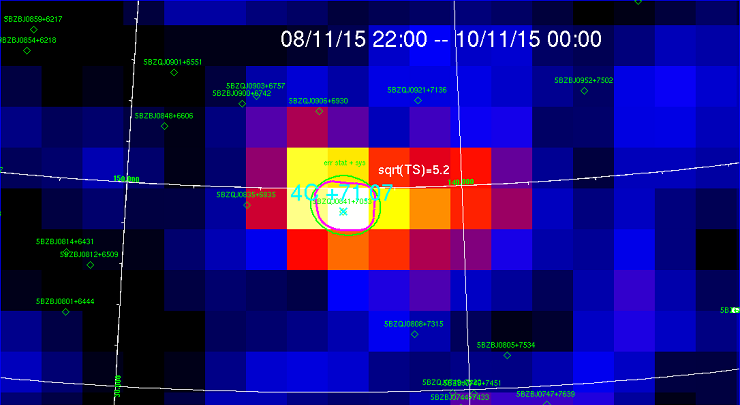 AGILE intensity map (E >100 MeV) of the 4C +71.07 field during the flare, on a 26-hours integration time from 2015-11-08 22:00 UT to 2015-11-10 00:00 UT. |
| Oct 29, 2015 | AGILE detection of enhanced gamma-ray activity from the S5 0836+71 (4C +71.07) region New ATel issued: ATel #8223 (A. Bulgarelli et al.). |
| Oct 16, 2015 | MATISSE v1.1 now online with major upgrades A new version of MATISSE (Multi-purpose Advanced Tool for Instruments for the Solar System Exploration) has been released. The most noticeable features introduced with the version 1.1 now online are:
For any question or suggestion feel free to contact angelo.zinzi@asdc.asi.it 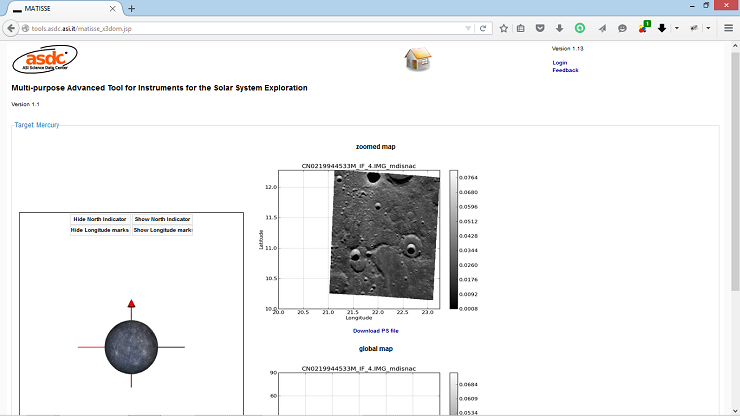 The MATISSE output page, with the 3D view of Mercury and the 2D projected map of data selected 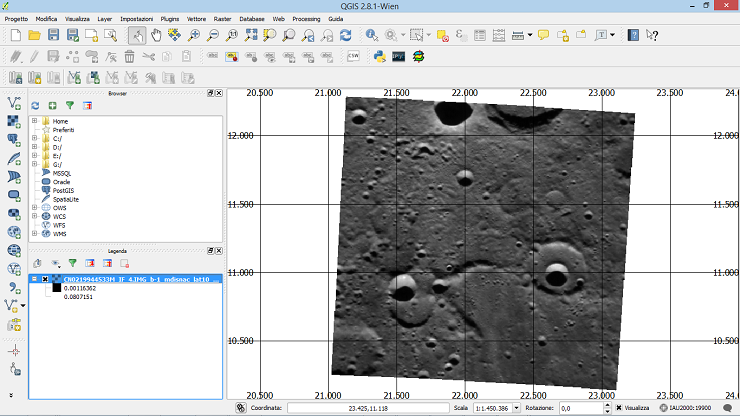 GeoTIFF image from Mercury created with MATISSE and viewed with QGIS |
| Oct 06, 2015 | New AGILE data distribution policy and new public data up to June 30, 2015 A change in AGILE gamma-ray scientific data policy was suggested by the Mission Board and it has been approved by ASI. To strengthen the engagement of the Scientific Community during the extended lifetime of the AGILE mission the standard one-year proprietary period was eliminated. Starting from October 5, 2015, all AGILE-GRID data will be published as soon as they will be processed and validated, about 4 times a year. The new public AGILE archive now contains all data from December 1, 2007 up to June 30, 2015. AGILE data are available as usual from the ASDC Multimission Archive (MMIA) webpage for the AGILE Mission. |
| Oct 06, 2015 | AGILE detection of enhanced gamma-ray activity from a source at high Galactic coordinates, AGLJ1948-7906 New ATel issued: ATel #8129 (A. Bulgarelli et al.). |
| Sep 29, 2015 | "Sigillo d'Argento" lifetime career award of the Trieste Province to Prof. Guido Barbiellini Amidei for his outstanding scientific and academic achievements On Monday September 28, 2015 Prof. Guido Barbiellini Amidei, currently co-Principal Investigator of the AGILE Mission of the Italian Space Agency and one of the founding members of the NASA international experiment Fermi, has been awarded the honor of the "Sigillo" of the Province of Trieste. Prof. Barbiellini Amidei, full professor at the Physics Department of the Trieste University, currently retired, has a long experience in the field of elementary particles and of high-energy astrophysics of cosmic radiation. Both AGILE and Fermi instruments use silicon detectors, precisely proposed for a space application by Prof. Barbiellini Amidei in 1987. His many students and colleagues have always admired his working method and his team-working attitude in common projects, often following his original intuitions. For further information see MEDIA INAF and ASI News.  |
| Jun 22, 2015 | AGILE detection of enhanced gamma-ray activity from BL Lacertae New ATel issued: ATel #7687 (F. Lucarelli et al.). |
| Jun 15, 2015 | AGILE detection of a bright gamma-ray flare from the blazar 3C 279 New ATel issued: ATel #7631 (F. Lucarelli et al.). |
| Jun 04, 2015 | Renewed gamma-ray activity of the FSRQ PKS 2032+107 detected by AGILE New ATel issued: ATel #7589 (F. Lucarelli et al.). |
| May 20, 2015 | AGILE detects the new gamma-ray source AGL J0134-3340 New ATel issued: ATel #7539 (G. Piano et al.). |
| Apr 29, 2015 | Confirmation by AGILE of increased gamma-ray emission from the FSRQ PKS 2032+107 New ATel issued: ATel #7457 (C. Pittori et al.). |
| Apr 21, 2015 | Lunar data ingested in ASDC's MATISSE tool In the framework of the Chinese-Italian "Moon Mapping" project lunar data acquired by the Chinese mission Chang'E-1 are now accessible through the MATISSE tool at ASDC for the members of the collaboration. The data comprise all 187 quadrangles in which the Moon has been divided for DEM (Digital Elevation Model) and DOM (Digital Ortophoto Map) and the 3 Element Abundance Maps (EAM), at a resolution of 5°x5° available at http://moon.bao.ac.cn/ceweb/datasrv/dmsce1.jsp after registration and login. MATISSE can visualize all the products on a 4 pixel per degree (ppd) model of the Moon and DEM and DOM can be downloaded as Paraview files at a resolution of 60 ppd (corresponding to the DEM one). |
| Mar 17, 2015 | AGILE detects enhanced gamma-ray activity from the radio galaxy NGC 1275 region New ATel issued: ATel #7239 (F. Verrecchia et al.). |
| Mar 15, 2015 | AGILE detection of an unidentified gamma-ray source at low Galactic latitude, AGLJ2251+6454 New ATel issued: ATel #7227 (A. Bulgarelli et al.). |
| Mar 09, 2015 | AGILE detects enhanced gamma-ray emission above 100 MeV from the blazar BZQ J0447-0322 region New ATel issued: ATel #7193 (C. Pittori et al.). |
| Feb 27, 2015 | AGILE detects enhanced gamma-ray emission above 100 MeV from the blazar S4 0554+58 region New ATel issued: ATel #7155 (F. Lucarelli et al.). |
| Feb 06, 2015 | ASDC Solar System coordinator to present Italian Space Agency exhibition about Rosetta on 14 February 2015 On 14 February 2015 at 4:30 pm Angelo Zinzi (ASI Science Data Center - Solar System Exploration) wil present the exhibition "Rosetta cacciatrice di comete" ("Rosetta the comet chaser"), held in Faenza, at the Palazzo delle Esposizioni (Corso Mazzini, 92). The exhibition will be open from 14 February to 1st March with free entrance and is the outcome of the cooperation between the Italian Space Agency and the Casa Museo 'Raffaele Bendandi'. Opening hours: from Tuesday to Sunday, from 9.30 am to 12.30 pm and from 3.30 pm to 6.30 pm (morning only on Thursday and Saturday). For more info go to the Italian Space Agency press release here. |
| Jan 21, 2015 | ASDC Solar System Exploration at the AGU Fall Meeting 2014 Global maps of albedo, VIS/IR slope and organics, computed with the VIRTIS instrument onboard ESA Rosetta mission, have been projected with a prototipal stand-alone Python software developed at ASDC on the 3D shape model of the comet 67P Churyumov-Gerasimenko and shown in the oral presentation by Filacchione et al. at the American Geophysical Union Fall Meeting held in San Francisco on December 2014. The video of the presentation can be watched here. |
| Jan 20, 2015 | AGILE satellite: 40.000th orbit around the Earth successfully completed On January 19, 2015 at 05:49:25 UTC the AGILE satellite successfully completed its 40.000th pass over the ASI Malindi Ground Station. Launched April 23, 2007 in low Earth orbit, AGILE is working nominally after almost 8 years. The Italian satellite continues its exploration of the high-energy Universe, also giving a crucial contribution to the study of extreme Terrestrial atmospheric events (TGFs). All AGILE data are regularly received and processed at the AGILE Data Center at ASDC, where the public archive now contains all observations from December 1, 2007 up to November 30, 2013. The data are available from the ASDC Multimission Archive webpage for the AGILE Mission. Also read: "Le 40mila orbite di Agile", ASI news (in italian). |
| Jan 20, 2015 | MATISSE v1.0 available The new version of the tool can be considered the first stable one, including important features such as the full selection of data based not only upon geographical charateristics, but also on the phase, incidence and emission angles. The visualization has been improved by using an arrow indicating the North, 4 marks indicating longitudes 0°, 90°, 180° and 270° and a grid superiposed over the shape model. Furthermore a Paraview-formatted file for high-resolution analysis is included in the downloadable archive. The tool is available at https://tools.ssdc.asi.it/matisse.jsp. |
| Jan 13, 2015 | New release of the ASDC Swift/UVOT on-line imaging tool An new release of the ASDC Swift/UVOT on-line imaging tool has been recently published. This new version is based on the updated ASDC imaging tools window layout originally developed for the AGILE one and applied to Swift/XRT data, with an improved display capabilities such as plot recentering and smoothing, and improved catalogs overlay. Moreover a new detection parameter, "Quality Filter", has been added and a faster processing procedure released. Further updates to the analysis capabilities together with a new simple "interactive" user defined analysis will be released in the future. |
| Dec 22, 2014 | All AGILE Cycle-6 Public Data Now Available The proprietary period for all AGILE Cycle-6 Observation Blocks, up to 2013-11-30 (from OB 15600 to OB 17900) has currently expired. The data are now public and available from the ASDC Multimission Archive (MMIA) webpage for the AGILE Mission. AGILE Cycle-6 data were obtained with AGILE observing a large portion of the sky in spinning mode, and they have been processed with the latest available software and calibrations. The new public archive now contains all AGILE data from December 1, 2007 up to November 30, 2013 (from Cycle-1 to Cycle-6). The query to the archive give access to all AGILE public data through an interactive webpage including the ASDC "Interactive Analysis" tool. The tool allows web users to preview the AGILE data fields, and to perform a preliminary analysis around a chosen sky position. |
| Nov 22, 2014 | AGILE detection of intense gamma-ray emission above 100 MeV from the blazar 4C+21.35 (PKS 1222+21) New ATel issued: ATel #6733 (F. Verrecchia et al.). |
| Oct 01, 2014 | AGILE Cycle-6 Public Data Now Available The proprietary period for the first AGILE Cycle-6 Observation Blocks, up to 2013-06-30 (from OB 15600 to OB 16900) has currently expired. The data are now public and available from the ASDC Multimission Archive (MMIA) webpage for the AGILE Mission. AGILE Cycle-6 data were obtained with AGILE observing a large portion of the sky in spinning mode, and they have been processed with the latest available software and calibrations. The query to the archive give access to all AGILE public data through an interactive webpage including the ASDC "Interactive Analysis" tool. The tool allows web users to preview the AGILE data fields, and to perform a preliminary analysis around a chosen sky position. |
| Sep 10, 2014 | AGILE detects enhanced gamma-ray emission from the FSRQ PKS 0502+049 New ATel issued: ATel #6457 (F. Lucarelli et al.). |
| Sep 09, 2014 | MATISSE presented at EPSC 2014 On Thursday 11th September, in the session MTI5 of the EPSC 2014 presentely held in Estoril (Portugal), the new version of MATISSE will be illustrated. The talk will be presented by Angelo Zinzi in room Venus at 2 pm. The abstract of the talk is downloadable at www.epsc2014.eu. |
| Sep 09, 2014 | The MATISSE hands-on tutorial video is online The full video (abouth 90 minutes) of the hands-on tutorial of MATISSE, registered on 3rd June 2014, is now available for streaming and download on https://solarsystem.ssdc.asi.it. Everyone interested to MATISSE is strongly encouraged to view the video in order to better know the tool. |
| Aug 28, 2014 | A new gamma-ray transient, AGL J1608-5253, detected by AGILE in the Galactic Plane New ATel issued: ATel #6427 (F. Verrecchia et al.). 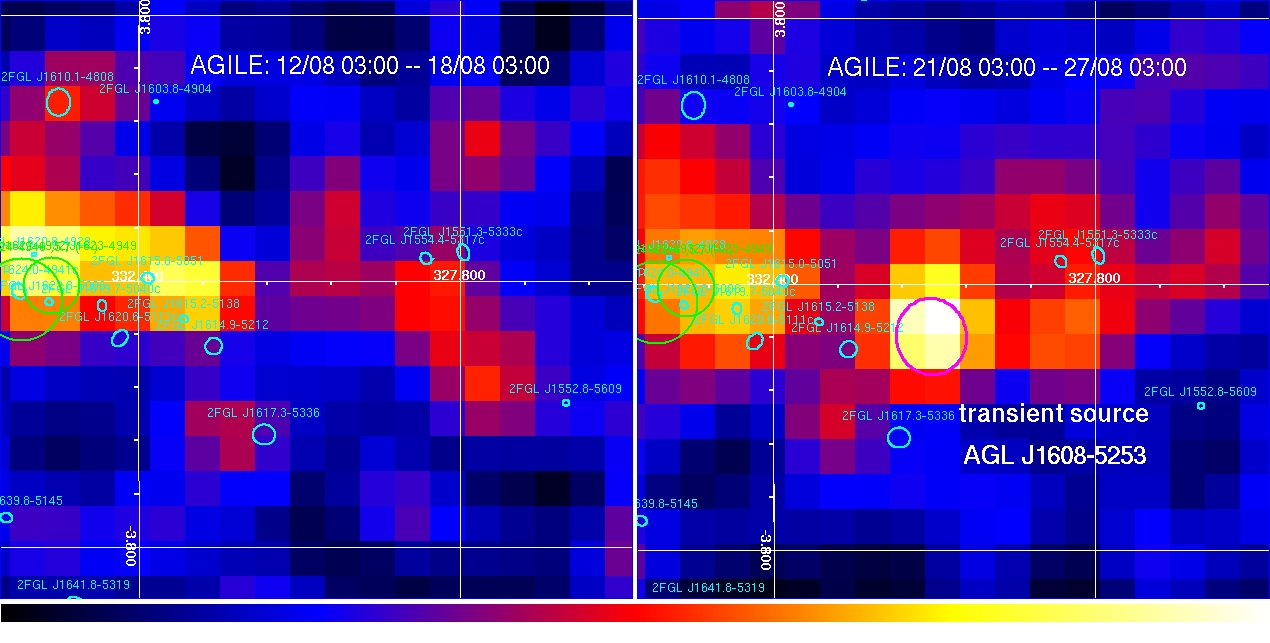 AGILE 6-day intensity map (E> 100 MeV) of the transient source region during the flare on August 21-27, 2014, and before it on August 12-18 2014. |
| Aug 03, 2014 | AGILE detection of a flare from PKS 1510-089 New ATel issued: ATel #6366 (A. Bulgarelli et al.). |
| Aug 03, 2014 | AGILE detection of a flare from the FSRQ 3C 279 New ATel issued: ATel #6365 (A. Bulgarelli et al.). |
| Jun 14, 2014 | Increasing gamma-ray activity of the Blazar 3C 454.3 detected by AGILE New ATel issued: ATel #6234 (A. Bulgarelli et al.). |
| Jun 13, 2014 | AGILE detection of a gamma-ray flare from the PSR B1259-63 region New ATel issued: ATel #6231 (C. Pittori et al.). |
| Jun 09, 2014 | Renewed gamma-ray activity of the Blazar 3C 454.3 detected by AGILE New ATel issued: ATel #6217 (F. Verrecchia et al.). |
| Jun 05, 2014 | IPN Triangulation of GRB 140604A (short/hard) New GCN issued: GCN #16350 (S. Golenetskii et al.; G. Di Cocco, F. Fuschino, M. Galli, C. Labanti, and M. Marisaldi, on behalf of the AGILE MCAL team). |
| May 28, 2014 | AGILE detects enhanced gamma-ray activity of the Blazar 3C 454.3 New ATel issued: ATel #6182 (F. Verrecchia et al.). |
| May 16, 2014 | 12th AGILE Scientific Workshops: presentations now available. We are pleased to announce that all the presentations authorized for distribution given during the 12th AGILE Workshops "ASTRO-EARTH: astrophysics and high-energy terrestrial phenomena" (8-9 May, 2014), are now publicly available. The slides (pdf format) may be viewed, together with the final program, at the Workshops web sites: https://www.ssdc.asi.it/12thagilemeeting/ On behalf of the Workshops SOC and LOC, we thank very much all the participants. |
| Mar 31, 2014 | GRB 140330A: intense and persistent gamma-ray emission detected by AGILE. New GCN issued: GCN #16058 (C. Pittori et al.) Following the IPN triangulation of GRB 140330A (GCN #16051) and subsequent gamma-ray data analysis, the high-energy source detected by Fermi (GCN #16048) and by AGILE (GCN #16058) was found to be unrelated to GRB 140330A, and it has been tentatively associated with the extra-galactic radio source PKS 2136-642, as reported in GCN #16062. |
| Feb 12, 2014 | AGILE gamma-ray detection of a new unidentified source in 2010 has led to the discovery of the first ever known Be-BH binary system. On July 2010 the ASI AGILE gamma-ray satellite recorded an intense and sporadic gamma-ray emission above 100 MeV from a new unidentified source, AGL J2241+4454 (Lucarelli F. et al., ATel #2761). MWC 656 (also known as HD 215227) is a rapidly spinning Be-type star located within the error circle of the AGL J2241+4454 gamma-ray source, which was identified as its candidate optical counterpart, and proposed as a new member of the small class of gamma-ray emitting binaries (Williams S. J. et al., ApJ 723, 2010). A recent detailed analysis of the optical spectrum of MWC 656 allowed researchers to infer the characteristics of its companion, that turned out to be an object with a mass between 3.8 and 6.9 solar masses. Such a compact object can only be a black hole, as no neutron star with more than about three solar masses can exist according to current theoretical and observational studies. This important discovery was recently published in Nature by a group of Spanish scientists (Casares J. et al., Nature 505, 2014). Two of them, Marc Ribò and Josep M. Paredes, members of the Group High Energy Astrophysics at Universitat de Barcelona, have also been AGILE Guest Observers in past ASI Announcements of Opportunity. |
Feb 06, 2014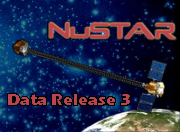 | NuSTAR 3rd Data Release at ASDC The NuSTAR 3rd Data Release is available from February 6, 2014 at ASDC. This new release contains 104 new data sets of 21 distinct targets observed up to June 30, 2013. All the NuSTAR public data at ASDC are fully integrated in the ASDC Multi-Mission Interactive Archive (MMIA). Through the MMIA the user can perform on-line analysis of all NuSTAR public observations, without the need to download any software, including the extraction of high-level scientific products (cleaned event files, sky images, energy spectra, light-curves, ARFs and RMFs). A new version of the NuSTAR Data Analysis Software (NuSTARDAS v.1.3.1, developed by ASDC in collaboration with Caltech) is available within the new release of the HEASARC's HEASoft multi-mission software (v.6.15.1). An updated version (v.1.5) of the NuSTARDAS data analysis software guide is also available. For more details on NuSTAR, see: https://nustar.ssdc.asi.it/ http://www.nustar.caltech.edu/ http://heasarc.gsfc.nasa.gov/docs/nustar/ |
| Jan 21, 2014 | Fermi-LAT Detection of Delayed Gamma-ray Flares from Gravitational Lens B0218+357 Using data from the Fermi Large Area Telescope (LAT) scientists of the LAT Collaboration, including staff of ASDC, have discovered the first gamma-ray signature of a delay between flares from the gravitationally lensed images of a high-energy emitting blazar. The time delay was observed in LAT flux light curves of blazar S3 0218+35 (OD 330, B2 0218+35, 2FGL J0221.0+3555), a known double-image system as lens B0218+357 (2014 ApJL, accepted, arXiv:1401.0548). Long before light from B0218+357 reaches us, it passes directly through a face-on spiral galaxy, about 4 billion light-years away. The galaxy's gravity bends the light into different paths producing dual images of the background blazar. The B0218+357 lens images hold the record for the smallest separation of any lensed system known. While radio and optical telescopes can resolve and monitor the individual blazar images, Fermi's LAT cannot, but can, instead, observe a "delayed playback" effect. Three episodes of flares showed playback delays of 11.5 days. This accomplishment opens new avenues for research, including a novel way to probe emission regions near supermassive black holes, and multi-messenger opportunities triggered by observed gamma-ray flares and the Fermi LAT continuous sky monitor. Time-dependent searches for neutrino signals from flaring blazars seen by Fermi LAT, for example, are of interest of experiments like IceCube, ANTARES, KM3NeT. Lensed gamma-ray/neutrino blazars, in particular, might lead to neutrino quantum interference signals as the lens could act like a cosmic beam splitter, as noted by S. Ciprini (ASDC) when he discovered the first gamma-ray flare from this lens (Aug. 26, 2012, ATel#4343), and collaborator of this first study. C.C. Cheung (NASA GSFC) and S. Larsson (Stockholm Univ. and ASDC visitor) coordinated the LAT study of lens B0218+357, thanks also to a granted target-of-opportunity pointed observation of the LAT (Sept. 24 to Oct. 1, 2012) triggered by the observation of a second flare (ATel#4361). Intriguingly, the gamma-ray delay is about a day longer than radio observations report for this system. And while the flares and their playback show similar gamma-ray brightness, in radio wavelengths one blazar image is about four times brighter than the other. Gamma-rays should arise from different regions with respect to radio-band flux, so these emissions likely take slightly different paths, with correspondingly different delays and amplifications, as they travel through the lens. As long as the Fermi LAT all-sky survey is continuing it may even be possible to find other high-energy gravitational lenses, even if the gamma-ray lensing signal cannot be easy to disentangle, as emerged from a first study, lead by ASDC and the Padova Fermi group, on the other strong Fermi LAT lens known, blazar PKS 1830-211 (ATel #2943; ATel #4158; ApJ paper submitted by the LAT Coll.; 2011, A&A, 528, 3; and 2013 A&A, 558, 123). 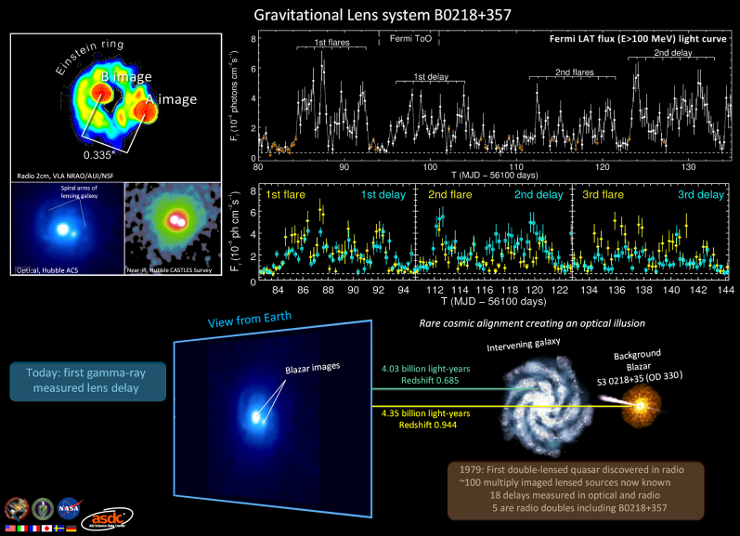 Further links: |
| Jan 17, 2014 | Gaia's first star! After a successful second insertion manoeuvre, Gaia has arrived at its operational 180 day-long Lissajous orbit around L2, 1.5 million Km from Earth. Nice trip Gaia! Everything is going quite well. The picture (below) shows the first public Gaia data: an image of Sadalmelik, a yellow supergiant star in Aquarius. 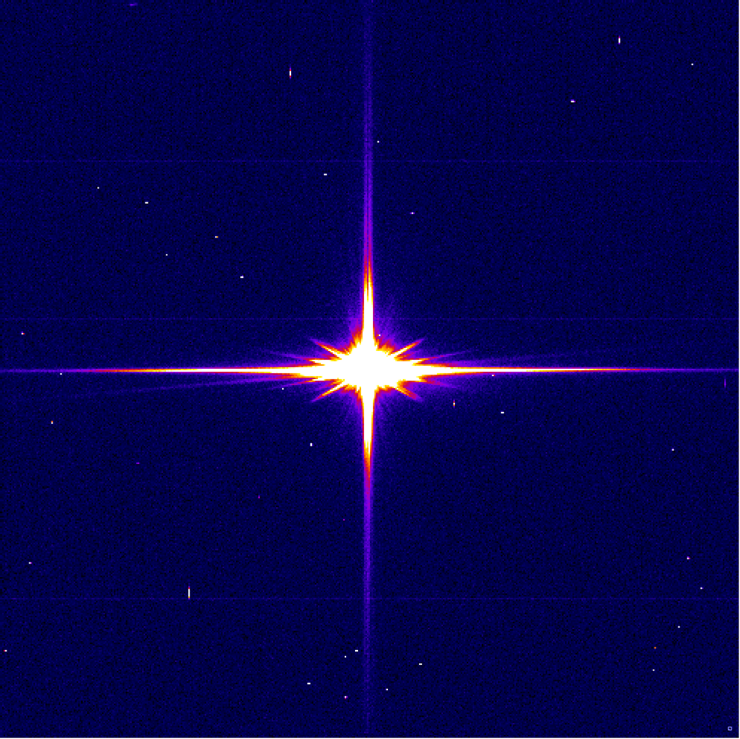 source: https://twitter.com/ESAGaia/status/423457053856636929/photo/1 The commissioning phase has begun: the next few days will be dedicated to calibration activities on the Basic Angle Monitoring and the Wavefront Sensor devices. Later on the Gaia telescopes will be aligned and focused. |
| Jan 15, 2014 | AGILE scientific operations in stand-by since Jan 1st, 2014 On January 1st, 2014 scientific in-orbit operations of the AGILE satellite have been temporarily interrupted. The payload is currently in a "stand-by" state, with only housekeeping telemetry being downlinked on alternate days. AGILE is now waiting for future ASI decisions about the mission funding. |
| Dec 22, 2013 | Confirmation by AGILE of increased gamma-ray emission from the blazar 3C 279 New ATel issued: ATel #5682 (E. Striani et al.). |
Dec 19, 2013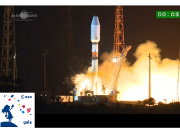 | Gaia launched! On 19 December 2013 09:12 GMT (10:12 CET) Gaia lifted off on a Soyuz rocket from the ESA Spaceport in Kourou, French Guiana, and is now travelling to L2. Up there 1 billion stars (in the Galaxy and beyond) wait to be observed by the satellite and their brightness, positions, motion, distance and astrophysical characteristics to be measured, to produce the richest 3D map of the sky ever realized. We are eager to see the expected and, even more, the unexpected results that Gaia will produce. Gaia will provide the detailed 3D distributions and space motions of a billion stars, brighter than 20th magnitude. The astrometric precision, reaching a few millionths of an arcsecond, will be unprecedented. This will allow our Galaxy to be mapped, for the first time, in three dimensions. Ten million stars will be measured with a distance accuracy of better than 1 percent and a 150 million to better than 10 percent. Compared to Hipparcos, Gaia will improve parallax and proper-motion accuracy by almost 100 times and the number of stars observed by 10 000 times. In addition it will measure radial velocities and spectrophotometry for the sources. Gaia will survey a vast population of solar system bodies (major planets, natural satellites, comets, and asteroids, including several thousands of near-Earth objects) and extragalactic objects (half a million quasars and thousands of supernovae). In addressing all these fields, Gaia will cover a significant part of modern astrophysics. The Gaia catalogue will be one of the largest and richest astronomical catalogue ever realized. The ASDC (ASI Science Data Center) coordinates the Italian contribution to DPAC-CU9, the coordination unit responsible for the realization of the Catalogue and for the release of the Gaia data. In the framework of a wide international collaboration, ASDC will host a copy of the Gaia catalogue and will contribute to CU9 activities. ASDC is responsible in CU9 for the cross-match of the Gaia catalogue with the largest public available optical and near-IR catalogues, as well as several other catalogues from radio to gamma-ray, ensuring an all-sky, multi-wavelength and multi-color vision of the Galaxy. In addition, ASDC is developing access and data mining tools to enable the astronomical community to handle and fully exploit the scientific potential of this enormous archive. In addition, ASDC is building the archive and database which will host the Gaia ancillary data obtained by the Italian teams involved in the project. This archive will include the measurements, observations and simulations needed for the absolute calibration of the Gaia spectro-photometric data. The archive is helping the work of the calibration team and will then be public. Finally ASDC is involved in DPAC-CU5 (responsible for the spectro-photometric data analysis and reduction) activities, namely the realization of the crowded fields analysis software and the data reduction of the photometric data needed for the validation of the Gaia spectro-photometric standards. ASI press release : http://www.asi.it/it/news/al_via_la_missione_gaia INAF press release : http://www.media.inaf.it/2013/12/19/gaia-appuntamento-con-la-storia/ ESA press release : http://www.esa.int/Our_Activities/Space_Science/Gaia/Liftoff_for_ESA_s_billion-star_surveyor |
Nov 25, 2013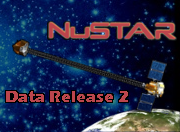 | NuSTAR 2nd Data Release at ASDC The NuSTAR 2nd Data Release is available from November 25, 2013 at ASDC. This new release contains 72 new data sets of 15 distinct targets observed up to December 31, 2012. The total exposure time of this new data release is 538 ks. We are pleased to announce that all the NuSTAR public data at ASDC are now fully integrated in the ASDC Multi-Mission Interactive Archive (MMIA). Through the MMIA the user can perform on-line analysis of all NuSTAR public observations, without the need to download any software, including the extraction of high-level scientific products (cleaned event files, sky images, energy spectra, light-curves, ARFs and RMFs). A new version of the NuSTAR Data Analysis Software (NuSTARDAS v.1.3.0, developed by ASDC in collaboration with Caltech) is available within the new release of the HEASARC's HEASoft multi-mission software (v.6.15). An updated version of the NuSTARDAS data analysis software guide is also available. For more details on NuSTAR, see: https://nustar.ssdc.asi.it/ http://www.nustar.caltech.edu/ http://heasarc.gsfc.nasa.gov/docs/nustar/ |
| Nov 22, 2013 | Complete set of AGILE Cycle-5 data now public The proprietary period for all AGILE Cycle-5 Observation Blocks up to 2012-11-30 (from OB 13200 to OB 15500), has currently expired. The data are now public and available from the ASDC Multimission Archive (MMIA) webpage for the AGILE Mission. The AGILE-GRID data published today are related to the last 10 AGILE observations of Cycle-5, from 2012-06-30 to 2012-11-30. AGILE Cycle-5 data were obtained with AGILE observing a large portion of the sky in spinning mode, and they have been processed with the latest available software and calibrations. The query to the archive give access to all AGILE public data from Cycle-1 to Cycle-5 (December 1, 2007 - November 30, 2012), through an interactive webpage including the ASDC "Interactive Analysis" tool. The tool allows web users to preview the AGILE data fields, and to perform a preliminary analysis around a chosen sky position. |
| Nov 09, 2013 | GRB 131108A: AGILE-GRID observation New GCN issued: GCN #15479 (A. Giuliani et al.) |
| Oct 24, 2013 | After a gamma-ray flare, AGILE detects the Crab Nebula returning to the normal flux level New ATel issued: ATel #5506 (F. Verrecchia et al.) |
| Oct 17, 2013 | An updated AGILE catalog including source variability in pointing mode has been published We are pleased to announce that the new AGILE-GRID catalog "An updated list of AGILE bright gamma-ray sources and their variability in pointing mode", is now available here as an interactive web table. In the on-line version of the catalog, the ASDC light curve tool can be accessed from the ASDC Data Explorer. |
| Oct 01, 2013 | AGILE Cycle-5 Public Data Now Available The proprietary period for 14 AGILE Cycle-5 Observation Blocks, up to 2012-06-30 (from OB 13200 to OB 14500) has currently expired. The data are now public and available from the ASDC Multimission Archive (MMIA) webpage for the AGILE Mission. AGILE Cycle-5 data were obtained with AGILE observing a large portion of the sky in spinning mode, and they have been processed with the latest available software and calibrations. The query to the archive give access to all AGILE public data through an interactive webpage including the ASDC "Interactive Analysis" tool. The tool allows web users to preview the AGILE data fields, and to perform a preliminary analysis around a chosen sky position. |
| Sep 26, 2013 | AGILE detection of increasing gamma-ray emission from the blazar PKS 1510-089 following an optical/near-infrared flare New ATel issued: ATel #5422 (V. Fioretti et al.) |
Aug 30, 2013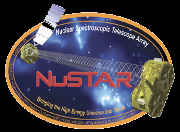 | NUSTAR ARCHIVE OPENING AT ASDC The NuSTAR data archive at the ASDC opened today, Aug 30, 2013, with an initial sample of 29 data sets from observations of a variety of objects. More data will be public in the coming months. The NuSTAR data analysis software ('nustardas', written by ASDC in collaboration with Caltech personnel) is available as a new sub-package in the HEASARC's FTOOLS/HEASoft multi-mission software as of the last release (FTOOLS v.6.14, 7 August 2013). Data analysis software guide is also available. For more details on NuSTAR, see https://nustar.ssdc.asi.it/ http://www.nustar.caltech.edu/ http://heasarc.gsfc.nasa.gov/docs/nustar/ |
| Aug 19, 2013 | Planck leaving L2 On Wednesday 14 August 2013, the Planck satellite started its way away from L2 after 1554 days of scientific operations. The departure maneuver was successfully executed taking Planck out of its operational orbit. On October 23rd, the Planck satellite will be turned off, and that marks the end of the Planck mission. |
| Jul 29, 2013 | Significant increase in the gamma-ray emission from the FSRQ 4C +38.41 (BZQ J1635+3808) reported by Fermi and AGILE satellites New Fermi LAT ATel issued: ATel #5232 (D. Gasparrini et al.) New AGILE GRID ATel issued: ATel #5234 (F. Lucarelli et al.). |
| Jun 08, 2013 | GRB 130606B: AGILE-MCAL observation New GCN issued: GCN #14823 (M. Marisaldi et al.). |
| Apr 30, 2013 | GRB 130427A: high energy gamma-ray detection by AGILE and Fermi AGILE detected high energy emission above 50 MeV with the Gamma-Ray Imaging Detector (GRID) and above 350 keV with the Mini-Calorimeter MCAL) from the long-duration GRB 130427A on April 27, localised by Swift (GCN 14448, Maselli et al.). Due to the exceptionally high fluence above 100 MeV of this burst, it was possible for the first time to derive its properties using the technique ("maximum likelihood") routinely used in the standard data analysis of AGILE-GRID point sources. This burst was detected above 100 MeV and reported previously by the Fermi Large Area Telescope (LAT). The LAT data show a multi-peaked light curve consistent with the Fermi GBM trigger. More than 200 photons above 100 MeV are observed within 100 seconds with a TS above 1000. Different observations by other space missions such as MAXI, INTEGRAL and Konus-Wind and by optical/NIR and radio ground-based telescopes followed. Some GCN issued: Swift localization: GCN# 14448 (Maselli et al.); MAXI-GSC detection: GCN# 14462 (Kawamuro et al.); Fermi-LAT detection: GCN# 14471 (Zhu et al.) and http://fermisky.blogspot.it; Fermi-GBM detection: GCN# 14473 (von Kienlin et al.); INTEGRAL-SPI detection: GCN# 14484 (Pozanenko et al.); Fermi-LAT refined analysis: GCN# 14508 (Zhu et al.). AGILE detection: GCN# 14515 (Verrecchia et al.). |
| Apr 11, 2013 | AGILE-MCAL Gamma-ray Burst Catalog on-line at ASDC We are pleased to announce that an on-line version of the AGILE-MCAL GRB catalog (M. Galli et al., A&A 2013) is available from the AGILE Data Center web pages in the form of an interactive web table. The interactive web table contains all the data for the published GRBs, including spectral data for 21 bursts, plus some supplementary information on other 7 events. Light Curves and Energy Spectra (when available) can be accessed from the GRB Explorer tool, in the AGILE MCAL Data Products tab. |
| Mar 28, 2013 | GRB 130327B: gamma-ray detection by AGILE The AGILE Gamma-Ray Imaging Detector (GRID) detected high energy emission above 80 MeV from the long-duration GRB 130327B, localised by Fermi-GBM (http://gcn.gsfc.nasa.gov/other/386065447.fermi). High energy emission above 100 MeV was also observed by Fermi-LAT. Konus-Wind observation followed, and a Swift TOO observation has been requested. New GCN issued: AGILE detection: GCN #14344 (Longo et al.); Fermi-GBM detection: GCN #14346 (Chaplin and Fitzpatrick); Fermi-LAT detection: GCN #14347 (Ohno et al.); Konus-Wind observation: GCN #14348 (Golenetskii et al.). |
| Mar 12, 2013 | Sustained gamma-ray emission from the Crab Nebula and hard X-ray and Optical follow up reported The Crab Nebula continues to be in a high-flux gamma-ray state above 100 MeV following the initial detections reported by Fermi-LAT (ATel #4855) and AGILE (ATel #4856). Hard X-ray and Optical preliminary analysis of follow up observations show no significant variations. New ATel issued: Sustained high-flux emission above 100 MeV from the Crab Nebula source, ATel #4867 (F. Verrecchia et al.) New ATel issued: Hard X-ray INTEGRAL observations of the Crab Nebula during its gamma-ray flare, ATel #4869 (E. Jourdain et al.) New ATel issued: Optical Observations of the Crab pulsar from March 2 through 4, 2013, with Aqueye at the Copernico telescope in Asiago (Cima Ekar Observatory), ATel #4878 (L. Zampieri et al.) |
| Mar 05, 2013 | Significant increase in the gamma-ray emission from the Crab Nebula region reported by Fermi and AGILE satellites A new increase of the gamma-ray activity above 100 MeV from the Crab Nebula has been recently reported by Fermi-LAT (ATel #4855) and AGILE-GRID (ATel #4856). On March 3, the daily-averaged gamma-ray flux was about a factor of 3 greater than the source average flux in the second Fermi LAT catalog. Fermi has interrupted the all-sky scanning mode on March 4 starting at 15:30 UTC to observe the Crab Nebula and is expected to remain in this observing mode for up to 300 ks, depending on when the flare fades. New ATel issued: Fermi LAT detection of a new gamma-ray flare from the Crab Nebula region, ATel #4855 (R. Ojha et al.) New ATel issued: Enhanced gamma-ray emission from the Crab Nebula region detected by AGILE, ATel #4856 (E. Striani et al.) |
| Feb 27, 2013 | AGILE detection of a new gamma-ray source at high Galactic latitude, AGLJ1647+5107 AGILE detection of a new gamma-ray source at high Galactic latitude, AGLJ1647+5107 New ATel issued: ATel #4842 (A. Bulgarelli et al.) |
| Feb 19, 2013 | ASI's Malindi ground station tracking capabilities resumed and AGILE satellite operations back to normal ASI's Malindi ground station problems that disrupted all AGILE satellite scientific telemetry download since Dec 21, 2012 have now been overcome. All AGILE payload functions are nominal, and the acquisition of AGILE-GRID scientific telemetry data has been resumed since yesterday, February 18, 2013. |
Feb 15, 2013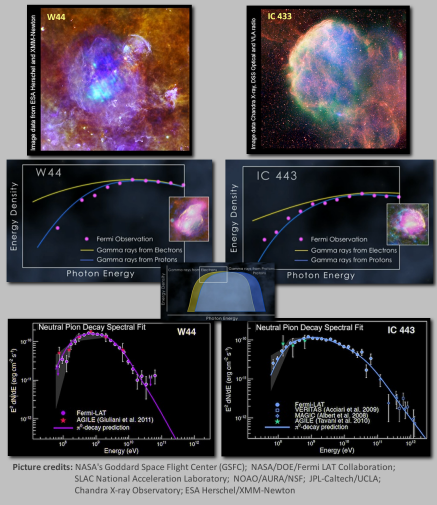 | Fermi Gamma-ray Space Telescope Proves Supernova Remnants Produce Cosmic Rays Through Detection of the Characteristic Pion-Decay Signature The Fermi Large Area Telescope (LAT) detected the characteristic pion-decay feature in the gamma-ray spectra of two supernova remnants (SNRs), IC 443 and W44. This detection provides direct evidence that cosmic-ray protons are accelerated in SNRs. Cosmic rays are particles (mostly protons) accelerated to relativistic speeds. Despite wide agreement that are the sources of galactic cosmic rays, unequivocal evidence for the acceleration of protons in these objects was still lacking. When accelerated protons encounter interstellar material, they produce neutral pions, which in turn decay into gamma rays. This offers a compelling way to detect the acceleration sites of protons. The identification of pion-decay gamma rays has been difficult until now because high-energy electrons also produce gamma rays via bremsstrahlung and inverse Compton scattering. The first clear-cut evidence the expanding debris of exploded stars produces some of the fastest-moving matter in the universe is revealed by observations of Fermi LAT. This discovery is a major step toward understanding the origin of cosmic rays, one of Fermi's primary mission goals. The Fermi discovery builds on the previous discovery of neutral pion decay in W44 observed by the Italian Space Agency's AGILE gamma ray observatory and published in late 2011. Read more: - NASA Top Story - SLAC Press release - The paper of the discovery on Science - Media INAF press release  |
Jan 22, 2013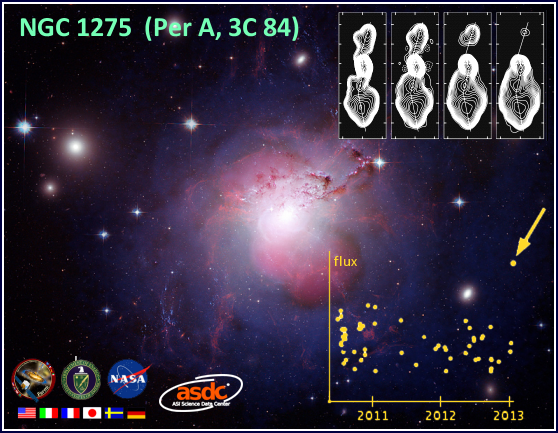 | Fermi LAT detection of renewed gamma-ray flaring activity from the radio galaxy NGC 1275 (Perseus A, 3C 84) New and interesting ATel issued: ATel#4753 (S. Ciprini). Fermi LAT has observed GeV gamma-ray flaring activity from a source positionally consistent with NGC 1275 (also known as Perseus A, 3C 84, and 2FGL J0319.8+4130) a radio galaxy located at the center of the Perseus galaxy cluster. On 2013 January 20, NGC 1275 was in a high state with an average daily gamma-ray flux (E>100MeV) of (1.1+/-0.3) x 10^-6 photons cm^-2 s^-1 (error statistical only). Fermi already observed increased GeV activity from this blazar in 2010 July (ATel#2737). Thanks to this very high energy gamma-ray emission was discovered by the MAGIC imaging air Cherenkov telescopes (ATel#2916). The current renewed activity is characterized by a GeV flux significantly larger than the past flares. NGC 1275 has been in a relatively high gamma-ray state in the last months and now the GeV flux observed is reaching the highest historical value observed for the source. TeV-Cherenkov and radioastronomy communities are highly interested in the gamma-ray flaring activity of this nearby radio galaxy.  |
Jan 15, 2013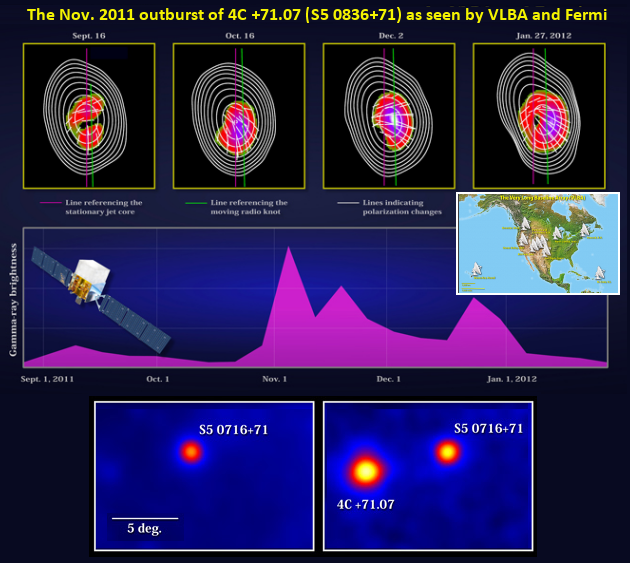 | Fermi and VLBA observe blazar's gamma-ray flares erupted far from its black hole In 2011, a months-long blast of gamma-ray energy (E>100MeV) launched by an enormous black hole in the blazar 4C +71.07 (S5 0836+71, z=2.172) 10.6 billion years ago swept past Earth. The correspondence between the re-weakening of the gamma-ray activity measured by the NASA's Fermi Gamma-ray Space Telescope, and the radio phenomenology observed by the ground with the Very Long Baseline Array (VLBA) of radiotelescopes is spectacular. 4C +71.07, placed in the Ursa Major constellation, was discovered as a source of strong radio emission in the 1960s. In early November 2011, at the height of the outburst, this blazar was more than 10000 times brighter in gamma-rays than the combined luminosity of all of the stars in our Milky Way galaxy. Prior to its strong outbursts in 2011, blazar 4C +71.07 was a weak source for Fermi's LAT. This renewed activity came after a long slumber, and that's important because it allows us to explicitly link the gamma-ray flares to the rising emission observed by radio telescopes. Theorists expect gamma-ray outbursts from blazars and other type of active galactic nuclei (AGN) occur only in close proximity to an AGN's central black hole, the central engine ultimately responsible for the activity and variability. A few rare observations suggested this is not the case. Using a combination and correlation of gamma-ray flux variability monitoring data obtained with Fermi LAT and radio flux-structure data obtained with the VLBA on 4C +71.07 at different epochs, astrophysicists have discovered the clearest and most distant evidence that the theory still needs some work. Surprising the gamma-ray emission originated from a blob of plasma placed about 70 light-years away from the 4C +71.07 galaxy's central black hole. (... read more).  |
| Jan 04, 2013 | Malindi Ground station problems impact on AGILE telemetry download Due to ASI's Malindi ground station technical problems, the acquisition of telemetry data from the AGILE satellite has been significantly reduced since December 21, 2012. All AGILE payload functions are nominal, and normal operations will be resumed as soon as the Malindi antenna system problems are solved. |
| Dec 20, 2012 | All AGILE Cycle-4 Public Data Now Available The proprietary period for all AGILE Cycle-4 Observation Blocks (OB), from OB 10800 to OB 13100 has currently expired. The GRID data published today are related to the last 4 AGILE observations of Cycle-4, from 2011-09-30 to 2011-11-30 taken in spinning observing mode. The data have been processed with the latest available software and calibrations. Public data are available from the ASDC Multimission Archive (MMIA) webpage for the AGILE Mission. The public AGILE archive now contains all data from December 1, 2007 (Cycle-1) to September 30, 2011 (Cycle-4). The query to the archive give access to the public data, producing an interactive table includingthe ASDC "On-line Analysis" tool. |
| Dec 10, 2012 | Fermi Improves its Vision for Thunderstorm Gamma-Ray Flashes Thanks to improved data analysis techniques and a new operating mode, the Gamma-ray Burst Monitor (GBM) aboard NASA's Fermi Gamma-ray Space Telescope is now 10 times better at catching the brief outbursts of high-energy light mysteriously produced above thunderstorms on our Earth. These atmospheric outbursts, known as terrestrial gamma-ray flashes (TGFs), last only a few thousandths of a second, but their gamma rays rank among the highest-energy light that naturally occurs on Earth. On April 2012 ASDC hosted a Workshop on "Lightning, Terrestrial Gamma-Ray Flashes, and Meteorology" in the frame of the AGILE Mission. The enhanced Fermi GBM discovery rate is helping scientists show most TGFs also generate a strong burst of radio waves, a finding that will change how scientists study this poorly understood phenomenon (... read more). 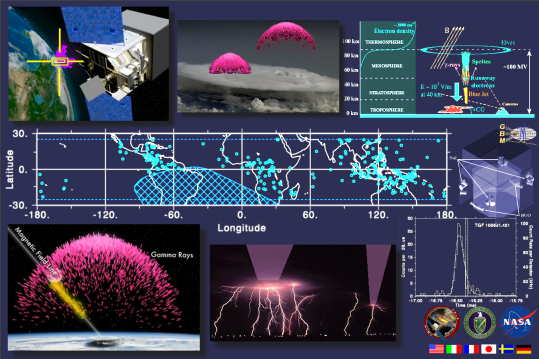 |
| Nov 21, 2012 | AGILE Cycle-4 Public Data Now Available The proprietary period for the AGILE Cycle-4 Observation Blocks (OB) from OB 10800 to OB 12700 has currently expired. The data are public and available from the ASDC Multimission Archive (MMIA) webpage for the AGILE Mission. The new public GRID data are related to the first 20 AGILE observations of Cycle-4, from 2010-11-30 to 2011-09-30 taken in spinning observing mode. The data have been processed with the latest available software and calibrations. The new public AGILE archive now contains all data from December 1, 2007 (Cycle-1) to September 30, 2011 (Cycle-4). The query to the archive give access to the public data, producing an interactive table including the ASDC "On-line Analysis" tool. |
| Oct 09, 2012 | Swift discovers a new black hole in our Galaxy On Sept. 16, the Swift satellite detected a rapidly brightening source located a few degrees from the center of our Milky Way galaxy. This source, named Swift J1745-26, is thought to be an X-ray nova and produced an outburst that revealed the presence of a previously unknown black hole. The black hole should be a member of a low-mass X-ray binary (LMXB) system, which includes a normal, sun-like star and a compact object. A stream of gas flowing from the normal star toward the black hole produced a stream of X-rays detected by the Swift instruments. "Bright X-ray novae are so rare that they're essentially once-a-mission events and this is the first one Swift has seen," said Neil Gehrels, the mission's principal investigator, at NASA's Goddard Space Flight Center. Swift, launched in November 2004, is a NASA mission with international participation from the United States, the United Kingdom, and Italy. The Italian participation includes the provision of the Malindi ground station (ASI), the mirrors of the X-ray Telescope (INAF-OAB) and the ASI Science Data Center (ASDC) which hosts an official mirror of the Swift scientific data archive and has the responsibility of the development of the Data Reduction Software for the XRT instrument on board Swift (XRTDAS). The new exciting result obtained by Swift was announced by NASA on October 5. For more details on this topic see the NASA pages and the news (in italian) on the INAF and ASI web sites.  Swift J1745-26. image taken on September 18, 2012 when the source peaked in hard X-rays. Credit: NASA/Goddard Space Flight Center/S. Immler and H. Krimm |
| Sep 19, 2012 | AGILE detection of enhanced gamma-ray emission from a position consistent with the blazar 4C +38.41 New ATel issued: ATel #4389 (F. Verrecchia et al.) |
| Sep 11, 2012 | IPN Triangulation of GRB 120911B New GCN issued: GCN #13755 (K. Hurley et al.). |
July 24, 2012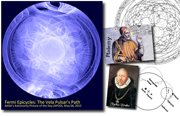 | Fermi Epicycles: The Vela Pulsar's Path. Exploring the cosmos at extreme energies, the Fermi Gamma-ray Space Telescope orbits planet Earth every 95 minutes. By design, it rocks to the north and then to the south on alternate orbits in order to survey the sky with its Large Area Telescope (LAT). The spacecraft also rolls so that solar panels are kept pointed at the Sun for power, and the axis of its orbit precesses like a top, making a complete rotation once every 54 days. As a result of these multiple cycles the paths of gamma-ray sources trace out complex patterns from the spacecraft's perspective, like this mesmerising plot of the path of the Vela Pulsar. Centered on the LAT instrument's field of view, the plot spans 180 degrees and follows Vela's position from August 2008 through August 2010. The concentration near the center shows that Vela was in the sensitive region of the LAT field during much of that period. Born in the death explosion of a massive star within our Milky Way galaxy, the Vela Pulsar is a neutron star spinning 11 times a second, seen as the brightest persistent source in the gamma-ray sky. It was NASA's Astronomy Picture of the Day (APOD) for May 04, 2012. 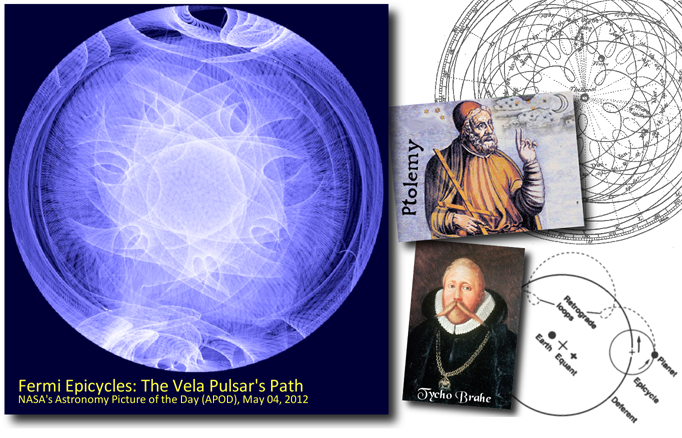 The theory of epicycles, the idea that celestial bodies moved in small circles as they traced larger orbits with Earth as center, is arguably the most famous aspect of Ancient Greek astronomy (Ptolemy). In the Ptolemaic system of astronomy, the epicycle (literally: on the circle in Greek) was a geometric model used to explain the variations in speed and direction of the apparent motion of the Moon, Sun, and planets. It was first proposed by Apollonius of Perga at the end of the 3rd century BC and formalized by Ptolemy of the Thebaid in his 2nd-century AD astronomical treatise the Almagest. In 16th century Tycho Brahe, an eccentric Danish nobleman and astronomer made very accurate measurements of Mars' positions and compiled the voluminous astronomical data which Kepler would use to construct his theories. Brahe postulated that even in the Copernican system, epicycles were required and believed in a variation of the Ptolemaic system in which the planets went around the Sun, but the Sun went around the Earth. Galileo made telescope observations that supported the Copernican view, satellites rotating around Jupiter, and the Kepler's revised heliocentric system was demostrated to give far more accurate description of planetary motions than the Ptolemaic one. The Copernican revolution was arguably completed by Isaac Newton whose "Philosophiae Naturalis Principia Mathematica" (1687) provided a consistent physical explanation which showed that Earth and the other planets are kept in their orbits around the Sun by the familiar force of gravity. |
June 12, 2012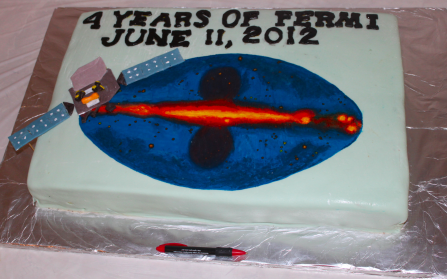 | Happy 4th Birthday Fermi! Today is the 4th anniversary of the Fermi Gamma-ray Space Telescope launch. In the past 4 years Fermi collected, through the main instrument the Large Area Telescope (LAT), over 1.37 billion of events (and 193 million of gamma-ray photon events ready for science analysis), distributed as public data by FSSC-GSFC and by the public Fermi data retrieval at ASDC. https://tools.ssdc.asi.it/?searchtype=fermi The LAT Collaboration has published 199 papers (Cat.I and Cat.II). Collectively these papers have been cited nearly 10,000 times. The LAT's fellow passenger on the Fermi satellite, the GBM has triggered on 1949 transients (and at 939 GRBs are creeping ever closer to the 1000 mark). The observatory has performed 77 autonomous repoints and the mission overall has produced over 800 refereed papers with new Fermi results or using/interpreting Fermi results and issued over 30 press/web releases. The most recent press release reports first Fermi LAT analysis results about the highest-energy, MeV-GeV, gamma-ray photons detected from the Solar Flare of March 7 (the flare occurred during the days of the last Fermi LAT collaboration meeting held in Abano Terme, Padova, and during a Flare Advocate duty shift performed by a member of the ASDC Fermi Team). Here below the Astronomy Picture of the Day, related to this Fermi Solar Flare: http://apod.nasa.gov/apod/ap120315.html and the recent NASA Press Release issued on June 11: http://www.nasa.gov/mission_pages/GLAST/news/highest-energy.html Here the Fermi LAT all-sky photon counts map of March 7, 2012 (E>100 MeV), showing that although the Vela pulsar is the brightest continuous LAT source, it was outmatched this day by the X5.4 solar flare, which brightened the gamma-ray sun by 1000 times. 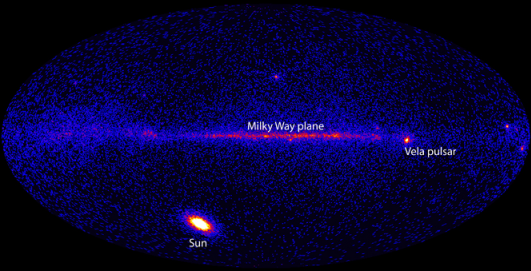 A special cake has been made to celebrate the 4th Fermi's launch birthday. This is shown in the picture below (a large size cake containing a delicious combination of chocolate and vanilla).  |
| June 6, 2012 | AGILE confirmation of the increasing gamma-ray activity from PKS 2233-148 New ATel issued: ATel #4154 (F. Lucarelli et al.) |
| June 5, 2012 | AGILE detection of increasing gamma-ray emission from a region including 2FGL J1823.8+4312 New ATel issued: ATel #4153 (F. Lucarelli et al.) |
| May 23, 2012 | AGILE 9th and 10th Scientific Workshops: all presentations now available We are pleased to announce that all the presentations given at the 9th and 10th AGILE Scientific Workshops, held in ASDC on 16-18 April, 2012, are now publicly available. As for the 10th AGILE Workshop, most presentations are published along with some supplementary information kindly provided by the speakers. The slides (pdf format) may be viewed, together with the final program, at the Workshops web sites: https://www.ssdc.asi.it/9thagilemeeting/ https://www.ssdc.asi.it/10thagilemeeting/ On behalf of the Workshops SOC and LOC, we thank very much all the participants. |
| February 23, 2012 | Swift follow-up observations of renewed gamma-ray emission from the FSRQ PKS 1510-089 New ATel issued: ATel #3939 (S. Vercellone et al.) |
| February 17, 2012 | AGILE detection of increasing gamma-ray emission from the FSRQ PKS1510-089 New ATel issued: ATel #3934 (F. Lucarelli et al.) |
| February 3, 2012 | Swift follow-up observation of the detection of a gamma-ray enhanced emission from the FSRQ PKS 1510-089 New ATel issued: ATel #3910 (S. Vercellone et al.) |
| February 2, 2012 | AGILE detects enhanced gamma-ray emission from the FSRQ PKS 1510-089 New ATel issued: ATel #3907 (F. Verrecchia et al.) |
| January 27, 2012 | Fermi LAT detection of bright gamma-ray flux related to the strong solar flare of January 23 2012 The Fermi Large Area Telescope (LAT) detected on January 23, 2012, a very bright and high energy (E>100 MeV) gamma-ray activity from the sun produced by the strong M9-class solar flare erupting on the Sun's northeastern hemisphere at 03:59 UT. This event is resulting the strongest solar flare and radiation storm since 2005 bombarding our Earth. It has been produced by sunspot 1402 with a very fast coronal mass ejection (CME) partially Earth directed (see, for example this video, this video and this video). A rush of radiation in the form of solar protons already has begun bombarding the Earth and is likely to continue through Thursday 26. The radiation storm is the largest of its kind since 2005 but still ranks only a three on the scale of one to five, enough to be considered ''strong'', with the potential to disrupt some communications and satellite systems and to bring auroras to high-latitude skies, but not ''severe''. Following one of the longest and weakest periods of activity in many cycles, the Sun is brimming with activity again, and this flare is a preview of what may be to come in the solar maximum of 2012�13, having attracted the attention of the main newspapers and media. A solar eruption and flare is followed by a one-two-three punch. First comes electromagnetic radiation, followed by cosmic rays mostly in form of energetic protons (90%), helium nuclei (alpha particles) and electrons. Then, finally the coronal mass ejection (the plasma from the sun itself), hits the Earth. Usually that travels at about 2 or 3 million km/h, but this storm is particularly speedy and is shooting out at about 6.4 million km/h. It is the plasma that causes much of the noticeable problems on Earth, such as electrical grid outages. During the first half of Jan. 23 (UT) the Large Area Telescope, one of the two instruments on the Fermi Gamma-ray Space Telescope, detected a long-lasting and bright gamma-ray emission positionally consistent with the Sun position on the sky at the time of the flare. First results indicates that gamma-ray emission above 100 MeV from the Sun during the brightest flux peak was a factor of about 50 greater than the gamma-ray flux of the solar disk for the quiet Sun ATel#3886. During this event the Sun was detected as the brightest gamma-ray point source of the E>100MeV sky, overwhelming the brightness of the Vela pulsar (see the figure below). 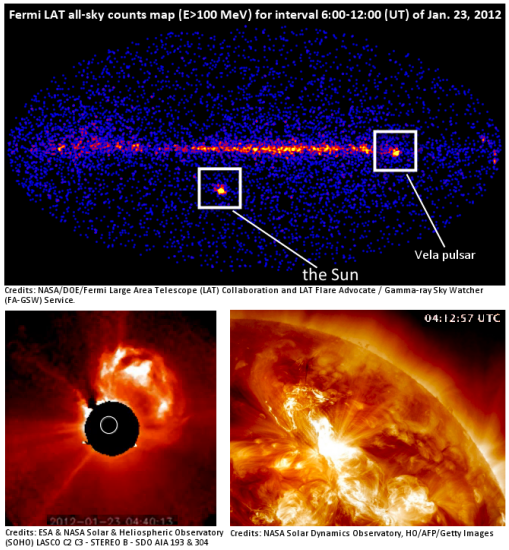 Fermi LAT reported other episodes of enhanced gamma-ray activity from the Sun on last year (ATel#3214, ATel#3417, ATel#3552, ATel#3635). These results followed Fermi LAT Data Quality Monitor duty service, LAT Solar science group analysis and LAT Flare Advocate and Gamma-ray Sky Watcher (FA-GSW) duty service (Ciprini et al. 2012, eConf C11/05/09, arXiv:1111.6803). The FA-GSW service provides for a day-by-day quicklook review of the high-energy gamma-ray sky seen by Fermi LAT, offering alerts for potentially new gamma-ray sources, interesting transients and relevant flares of celestial sources. A public weekly digest containing the main highlights is published in the Fermi Gamma-ray Sky Blog. The FA-GSW service is coordinated by the Fermi Team at ASDC and, in particular, the duty shifter during this solar flare event was S. Ciprini of ASDC (INAF). |
| January 13, 2012 | AGILE detection of a high Galactic latitude gamma-ray source New ATel issued: ATel #3862 (M. Cardillo et al.) |
| January 11, 2012 | AGILE gamma-ray detection of the Catalina transient CSS111117 New ATel issued: ATel #3858 (C. Pittori et al.) |
| January 4, 2012 | Detection of a Supernova component contributing to the light curve of the afterglow of the SuperAGILE GRB 111211A New GCN issued: "GRB 111211A: Detection of the SN with the 10.4m GTC", GCN #12802 (A. de Ugarte Postigo). |
| December 13, 2011 | GRB 111211A: A Superagile localization of a long GRB New GCN issued: GCN #12666 (F. Lazzarotto et al.). |
November 24, 2011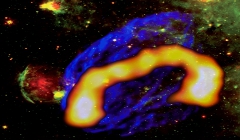 | AGILE sheds light on the mistery of the origin of comic rays AGILE has discovered a pattern of gamma-ray emission from the supernova remnant W44 that, combined with the observed multifrequency properties of the source, can be unambiguously attributed to accelerated protons interacting with nearby dense gas. The AGILE gamma-ray imager reaches its optimal sensitivity just at the energies in the 50 MeV-a few GeV range at which neutral pions (produced by proton-proton interactions) radiate with an unambiguous signature. The AGILE data resolves the problem of clearly identifying a source of energetic cosmic rays in our Galaxy exactly 100 years after the discovery of cosmic rays by Victor Hess in 1912. Up to now a direct identification of sites in our Galaxy where proton acceleration takes place was elusive. This important AGILE result is reported in a paper to be published by Astrophysical Journal Letters (A. Giuliani et al., 2011). All the scientific oriented activities related to the analysis, archiving and distribution of AGILE data are supported by the AGILE Data Center at ASDC. 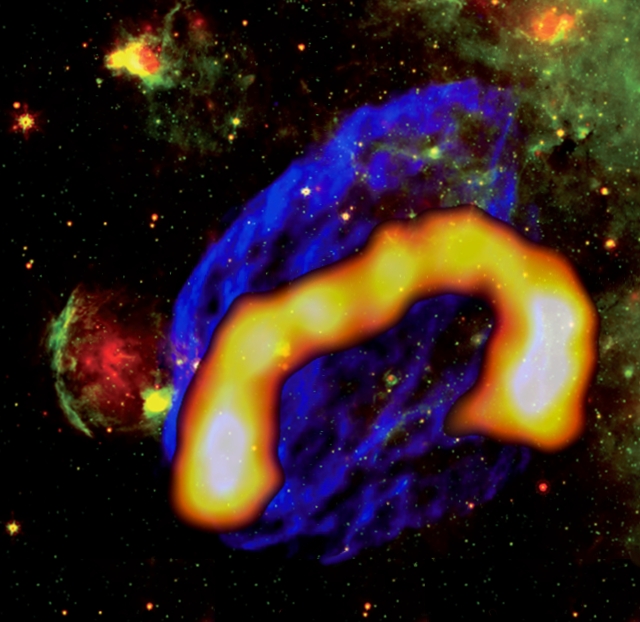 Figure credits: AGILE Team, G. Castelletti, G. Dubner |
| November 23, 2011 | Identification of a further gamma-ray flaring blazar following fruitful Fermi-Swift synergy The Large Area Telescope on the Fermi Gamma-ray Space Telescope, has recently observed, for the first time since launch, gamma-ray flaring activity from a source positionally associated with the flat spectrum radio quasar OG 050 (also known as TXS 0529+075 and 2FGL J0532.7+0733, with redshift z=1.254 and provided of bright X-ray and radio jet), see ATel#3750. Following this GeV flare, rapid Swift ToO observations were requested thanks to the Fermi Flare Advocate duty and were performed when the source was still in an active state. Swift XRT and UVOT quicklook data reduction performed through the ASDC online analysis tools, revealed on 2011 Nov. 11 a simultaneous high brightness state at GeV, X-ray and UV energy bands, and a simultaneous lower, post-flare, state four days later, confirming the firm identification of the associated flaring gamma-ray source with the blazar OG 050, see ATel#3773. Again the Swift satellite, thanks to its broad band coverage and scheduling flexibility, has created a perfect synergy with Fermi in high-energy astrophysics. 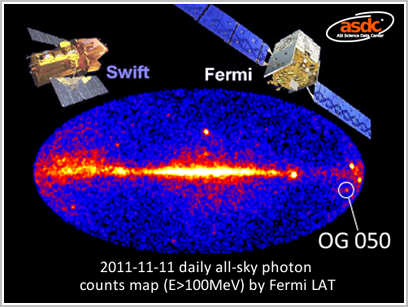 |
| November 9, 2011 | AGILE Cycle-3 Public Data Now Available The proprietary period for the AGILE Cycle-3 Observation Blocks (OB) from OB 8600 to OB 10400 has currently expired. The data are public and available from the ASDC Multimission Archive (MMIA) webpage for the AGILE Mission. Since the beginning of Cycle-3 the AGILE satellite is operating in a spinning observing mode, i.e. with the instrument axis sweeping the sky with an angular speed of ~0.8 degree/sec. The allowed pointing directions lie on a great circle orthogonal to the Sun direction, whose orientation changes with time, so that the whole sky is accessible during a six months period. The new public GRID data are related to the first 19 AGILE observations of Cycle-3, from 2009-10-31 to 2010-10-15. These data have been processed with the latest available software and calibrations optimized for the new observing mode. The new public AGILE archive is now containing both Cycle-3 spinning, and Cycle-1 and Cycle-2 pointing data. The query to the archive give access to the public data, producing an interactive table including the ASDC "On-line Analysis" tool. ********** Imaging tool at ASDC ********** The ASDC interactive tool allows web users to preview the AGILE public data fields and to perform a preliminary analysis around a chosen sky position. The tool uses the XIMAGE software package for multi-mission X-ray astronomy, adapted to gamma-ray image display and data analysis. This new version of the tool allows also to browse several multi-wavelength ASDC catalogs, and to overlay the source positions found in the field. Please send any feedback to the AGILE helpdesk. WARNING: use only as a preview of the AGILE gamma-ray field. To perform your own scientific analysis, please download and install the public AGILE software, and follow the User Manual included. Data delivery details and important recommendations for scientific analysis can be found in the AGILE data release note v6.0 (txt, pdf). |
| November 4, 2011 | Fermi Finds Youngest Millisecond Pulsar, reaching 100 gamma-ray pulsars An international team of scientists using NASA's Fermi Gamma-ray Space Telescope has discovered a surprisingly powerful millisecond pulsar that challenges existing theories about how these objects form. At the same time, another team has located nine new gamma-ray pulsars in Fermi data, using improved analytical techniques. More Information available on: http://www.nasa.gov/mission_pages/GLAST/news/young-pulsar.html In italian (by INAF): http://www.media.inaf.it/2011/11/03/una-giovane-pulsar-per-fermi/ |
| October 12, 2011 | NuSTAR Data Analysis Software Build 2 delivery to Caltech The ASDC has delivered on October 7th the Build 2 of the NuSTAR Data Analysis Software (NuSTARDAS) package to the California Institute of Technology (Caltech) NuSTAR Team. This build incorporates six software modules that allow to fully calibrate the event files. Build 2 also includes a main script, the NuSTAR pipeline ('nupipeline'), running in sequence all the tasks for NuSTAR data processing. NuSTARDAS is a package to produce cleaned, calibrated event list files and standard high-level scientific products starting from FITS formatted telemetry data. It is developed at the ASDC in collaboration with Caltech and the first complete version, including also the data filtering and the extraction of high-level data products, is foreseen for January 2012. The NuSTARDAS software will be used to generate the NuSTAR scientific archive and it will be also distributed to the users as part of the HEASoft package maintained by the HEASARC. |
September 28, 2011 | Shaw Prize for Astronomy to Enrico Costa Enrico Costa, Research Director at the IASF/INAF, has been awarded the 2011 Shaw Prize in Astronomy for his work on the Italian X-ray astronomy satellite BeppoSAX. He shares the prize with Gerald J. Fishman, Principal Investigator of the BATSE experiment, "for their leadership of space missions that enabled the demonstration of the cosmological origin of gamma ray bursts, the brightest sources known in the universe." BeppoSAX was launched in 1996 and operated succesfully until 2002. It was a project of the Italian Space Agency (ASI) with the participation of the Netherlands Agency for Aerospace Programs (NIVR). It was developed with the support of a consortium of scientific institutes in Italy and in The Netherlands and of the Space Science Department of ESA. Prime contractors for space and ground segments were Alenia Spazio and Telespazio. The ASI Science Data Center (ASDC) has been established in November 2000 based on the experience acquired with the management of the BeppoSAX Science Data Center. The most important result of the BeppoSAX Observatory was the discovery of the existence of the X-ray afterglows following Gamma Ray Burst (GRB) explosions. This was possible thanks to the BeppoSAX flexible repointing strategy and to the capabilities of its instruments. The X-ray telescopes on-board BeppoSAX were able to measure accurate positions of the afterglows enabling observers, using ground-based optical telescopes, to make the first identification of a GRB with a distant galaxy and thus confirming their cosmological origin. |
| September 24, 2011 | Gamma-ray activity of the blazar PKS 0402-362 detected by AGILE New ATel issued: ATel #3658 (M. Cardillo et al.) |
| September 16, 2011 | GRB 110915B: SuperAGILE localization of a long GRB New GCN issued: GCN #12341 (E. Del Monte et al.) |
| August 25, 2011 | Results on extensive Planck, Swift, and Fermi simultaneous observations of blazars available on arXiv/astro-ph A paper reporting the results of a large-scale collaboration involving the Planck, Swift, and Fermi teams, which led to simultaneous multi-frequency observations of a large number of blazars, has been submitted to A&A and is available on arXiv/astro-ph. |
| August 23, 2011 | 2-year Fermi-LAT Catalogs Released The Fermi-LAT collaboration presented the second catalog of gamma-ray sources (2FGL) and the second catalog of LAT Active Galactic Nuclei (2LAC), For a full explanation about the catalogs and their content see the "LAT 2-year Catalog Paper" and the "LAT 2-year AGN Catalog Paper" on arxiv. The 2FGL and 2LAC Catalogs are now available as ASDC interactive tables at https://www.ssdc.asi.it/fermi2fgl/ and https://www.ssdc.asi.it/fermi2lac/ . 2FGL lists 1.873 gamma-ray sources, 589 of which remain unidentified and could represent entirely new cosmic objects. |
| August 12, 2011 | GRB 110812A: SuperAGILE localization of a long GRB New GCN issued: GCN #12274 (E. Del Monte et al.) |
| August 10, 2011 | AGILE detects intense gamma-ray emission from a new unidentified source AGL J2103+5630 New ATel issued: ATel #3544 (A. Bulgarelli et al.) |
| July 4, 2011 | AGILE detects enhanced gamma-ray emission from BZQ J1512-0905 (PKS1510-089) New ATel issued: ATel #3470 (I. Donnarumma et al.) |
| June 22, 2011 | AGILE detects enhanced gamma-ray emission from the region of the Narrow-Line Sy1 PMN J0948+0022 New ATel issued: ATel #3448 (F. Lucarelli et al.) |
| June 14, 2011 | The last Herschel In-flight Announce of Opportunity is open! The last Herschel In-flight Announce of Opportunity is open! |
| May 31, 2011 | AGILE fourth Announcement of Opportunity The Italian Space Agency (ASI) announces the release of the fourth Announcement of Opportunity (AO4) for the Guest Observer Program of the AGILE mission. ASI is soliciting proposals from the world-wide astronomy community to apply for the 4th AGILE Announcement of Opportunity for obtaining one-year data rights on gamma-ray sources detected by the AGILE GRID instrument (Energy > 100 MeV) during Cycle-4, between December 1, 2010 and November 30, 2011. AO4 key dates: - Release of AO4: May 31, 2011 - Proposals submission period: June 1 - June 30, 2011 - AO4 Observing Period (Cycle-4 data): December 1, 2010 - November 30, 2011 The complete documentation for this AO4 can be found on-line at the AGILE-ASDC web page https://agile.ssdc.asi.it/ao4.html |
| May 29, 2011 | AGILE detection of enhanced gamma-ray emission from BL Lacertae New ATel issued: ATel #3387 (G. Piano et al.) |
| May 29, 2011 | Enhanced gamma-ray emission detected by AGILE from the Cygnus X-3 region New ATel issued: ATel #3386 (G. Piano et al.) |
| May 18, 2011 | AGILE detects enhanced gamma-ray emission from a new unidentified source AGL J2302-3251 New ATel issued: ATel #3357 (F. Lucarelli et al.) |
April 15, 2011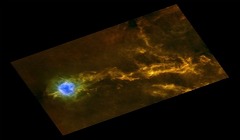 | The ESA's Herschel Space Telescope links star formation to gaseous filaments in molecular clouds The interstellar clouds of our Galaxy contain networks of long filaments of gas and dust. This is what was recently discovered by the Herschel satellite observing three nearby clouds: IC5146, Aquila, and Polaris. In this gaseous "tangles", Herschel discovered 90 filaments and, in the densest parts of them, newly-born stars are often found, showing that star forming process can be triggered by turbulence processing occurring within the filaments. The shockwaves traveling through the interstellar medium interact with the clouds, losing energy to them and, once dissipate, leaving these filaments of compressed material where the initial condition for the star formation occur. ASI News: http://www.asi.it/it/news/_herschel_la_nascita_delle_stelle_come_perle_lungo_filamenti_di_gas_e_polvere For more information about Herschel, visit: http://herschel.asdc.asi.it |
| April 15, 2011 | Renewed increase of gamma-ray activity from the Crab Nebula A renewed increase of the gamma-ray activity above 100 MeV from the Crab Nebula has been recently reported by Fermi in ATel #3276 (R. Buheler at al.) in the period April 9-11, 2011, and confirmed by the AGILE monitoring in ATel #3282 (M. Tavani et al.). A ToO Swift/XRT observation was promptly performed but no significant X-ray flux variation was detected, as reported in ATel #3279 (G. Cusumano et al.). Chandra was observing the Crab on April 12 and 13, 2011 as part of their monitoring program, which began following the previous surprising gamma-ray flare in September 2010. We recall that a gamma-ray flux increase from the direction of the Crab Nebula was reported for the first time by AGILE, and then confirmed by Fermi in September 2010 (ATel #2855 and ATel #2861). The new Chandra observations are reported in ATel #3283 (A. Tennant et al.). |
| April 11, 2011 | Swift discovers puzzling cosmic gamma-ray source On March 28, Swift's Burst Alert Telescope discovered a new gamma-ray source cataloged as gamma-ray burst (GRB) 110328A. Astronomers immediately realized that this source is very peculiar, being very bright with a peculiar strong flaring activity lasting much longer than in all other GRBs. Following the Swift discovery, several ground and space telescopes observed this puzzling cosmic source. A deep image in the optical band taken by the Hubble Space Telescope revealed that the source of the explosion is located at the center of a galaxy distant about 3.8 billion light-years away from Earth. In the X-rays, the Chandra X-ray Observatory showed that the source lies at the center of the galaxy Hubble imaged. Observations of this source are still ongoing. Astronomers think this strong energy emission could arise from the disruption of a star wandered too close to its galaxy's central massive black hole. In particular, the X-rays may be coming from matter moving near the speed of light in a particle jet that forms along the rotation axis of the spinning black hole as the star's gas falls into a disk around the black hole. For more information and images associated with these observations, visit: http://www.nasa.gov/topics/universe/features/star-disintegration.html
|
| March 28, 2011 | AGILE detection of Cygnus X-3 above 400 MeV New ATel issued: ATel #3239 (A. Bulgarelli et al.) |
| March 9, 2011 | III Fermi Symposium :ABSTRACT SUBMISSION OPEN! Dear Colleague, We are pleased to announce that abstract submission and registration for the 3rd Fermi symposium is now open. Please visit the web pages at http://fermi.gsfc.nasa.gov/science/symposium/2011/ for information about the meeting. Registration: The symposium registration fee is 350 Euro until April 8. There is a reduced fee for current students of 250 Euro. After April 8, the fee will increase to 450 Euro (and 350 Euro for students). Registration includes lunch each day, a tour of the Sistine Chapel and a social dinner. Abstract submission: We invite participants to submit abstracts for proposed scientific contributions to the symposium. The default mode of contributions will be posters. The scientific organising committee will select a subset of the abstracts for oral presentations in either plenary or parallel sessions. In addition to Fermi science, poster and parallel oral contributions on relevant analysis techniques and the status of related facilities (current and future) are welcome. For poster contributions, we are continuing the procedure from the last Fermi symposium: all posters should have a two-line abstract summary displayed at the top. The condensed summary, along with an optional more detailed abstract, will be included on the program website. The deadline for abstract submission is March 20 2011. ABSTRACT SUBMISSION IS NOW OPEN. Hotel reservations: The symposium webpage has links to lists of hotels in Rome, their distance from the symposium site and details on how to make reservations. Hotels in Rome are typically busy in May, so we encourage participants to make reservations early to ensure a place at the hotel of their choice. Program updates: We have updated the program to provide an updated block program and a list of the invited talks and speakers. |
| March 1, 2011 | AGILE detects enhanced gamma-ray emission from a region including the BL Lac Object S4 1749+70 New ATel issued: ATel #3199 (F. Lucarelli et al.) |
| February 8, 2011 | Gamma-ray flaring emission from Cygnus X-3 detected by AGILE New ATel issued: ATel #3151 (A. Bulgarelli et al.) 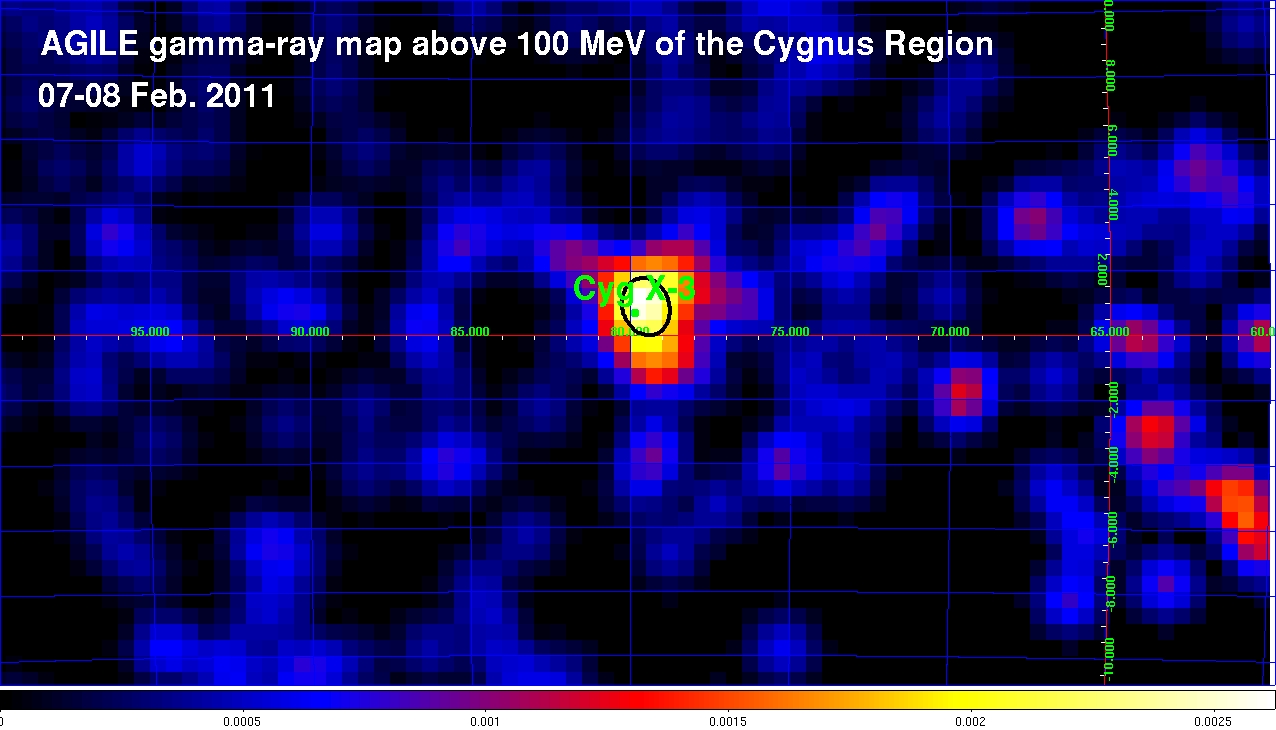 AGILE 1-day intensity map (E> 100 MeV) of the Cygnus region on February 7-8, 2011. |
| February 1, 2011 | AGILE detection of enhanced gamma-ray emission from Cygnus X-3 New ATel issued: ATel #3141 (A. Bulgarelli et al.) |
January 21, 2011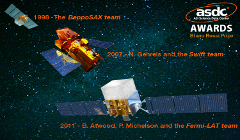 | Fermi Team wins Top High-Energy Prize 'Bruno Rossi' The 2011 Rossi Prize has been awarded to Bill Atwood, Peter Michelson and the Fermi-LAT team "for enabling, through the development of the Large Area Telescope, new insights into neutron stars, supernova remnants, cosmic rays, binary systems, active galactic nuclei, and gamma-ray bursts". The American Astronomical Society (AAS) High Energy Astrophysics Division (HEAD) awards the Rossi Prize in recognition of significant contributions as well as recent and original work in high-energy astrophysics. The prize is in honor of Professor Bruno Rossi, an authority on cosmic ray physics and a pioneer in the field of X-ray astronomy. The winners of the Rossi Prize will give a joint lecture at the 219th AAS meeting in Austin, Texas in January 2012. The Fermi Gamma-Ray Space Telescope, formerly GLAST, is an international and multi-agency space observatory that studies the cosmos in gamma-rays, the most energetic form of light. The LAT is one of two instruments onboard Fermi and is the most sensitive and highest-resolution gamma-ray detector ever launched. The ASDC is actively involved in the Fermi collaboration playing an important role in the development of the LAT scientific and data analysis software, especially for the automatic data processing, developing the software for the publication of LAT catalogues and the distribution of high level data products. ASDC staff is also contributing to many scientific activities within the Fermi LAT collaboration particularly in the fields of AGN, GRB and in multi-frequency data analysis. The Fermi team at ASDC is composed of: P. Giommi: full member, former AGN Science group coordinator in years 2006-2008, E. Cavazzuti: full member, one of the current AGN Science group coordinators and leader of Fermi team in ASDC, S. Cutini: post doc member with main research activity on GRB, AGN and catalog production, D. Gasparrini: post doc member, one of the Flare Advocate team coordinators with main research activity on AGN and catalog production, R. Primavera: technical member with activity on software programming (in particular the 'Quick Look' named Automatic Science Processing), C. Pittori and M. Perri: affiliated members with activity in multi-frequency data analysis. This is the third time that members of the ASDC have been awarded a Bruno Rossi Prize after BeppoSAX in 1998 and Swift in 2007. For more information about Fermi, visit: http://fermi.asdc.asi.it, http://www.nasa.gov/fermi Information on previous winners of the Rossi Prize can be found at http://www.aas.org/head/rossi/rossi.recip.html 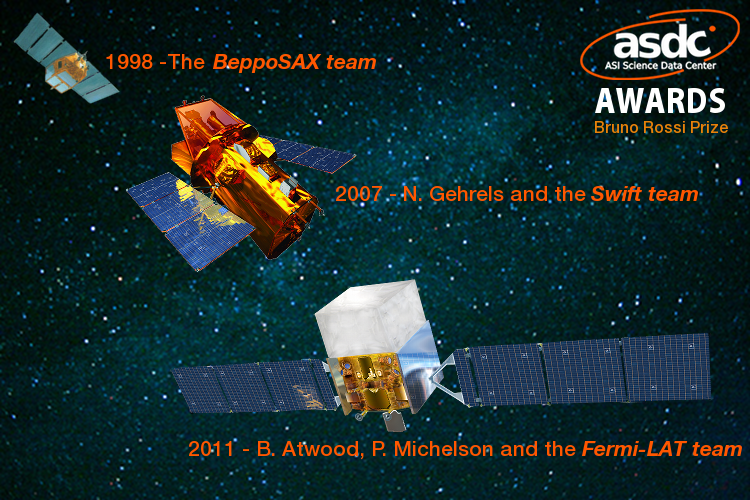 |
| January 13, 2011 | Herschel and XMM-Newton multi-frequency observations of the Andromeda galaxy The ESA's space observatories Herschel and XMM-Newton observed the nearest large spiral galaxy (Andromeda Galaxy or M31) over Christmas 2010. The Andromeda galaxy seen in the Herschel's SPIRE instrument bands (250,350, 500 micron) shows cool dust and gas heated by the star forming processes occurring within the dust clouds. Herschel's high sensitivity and spatial resolution allow us to study in a unique way the star formation on galaxy-scale in the nearest object similar to our own Milky Way. The Andromeda galaxy shows, in detail, concentric rings of star-forming dust that may have been formed during a collision with another galaxy. XMM-Newton shows instead later stages of the stellar evolution. The hundreds of X-ray sources in Andromeda, many of them clustered around the centre of the Galaxy, highlight the presence of hot gas and shock waves from supernovae, as well of massive and compact objects, often in close binary systems. More information is available on http://herschel.esac.esa.int/latest_news.shtml#M31 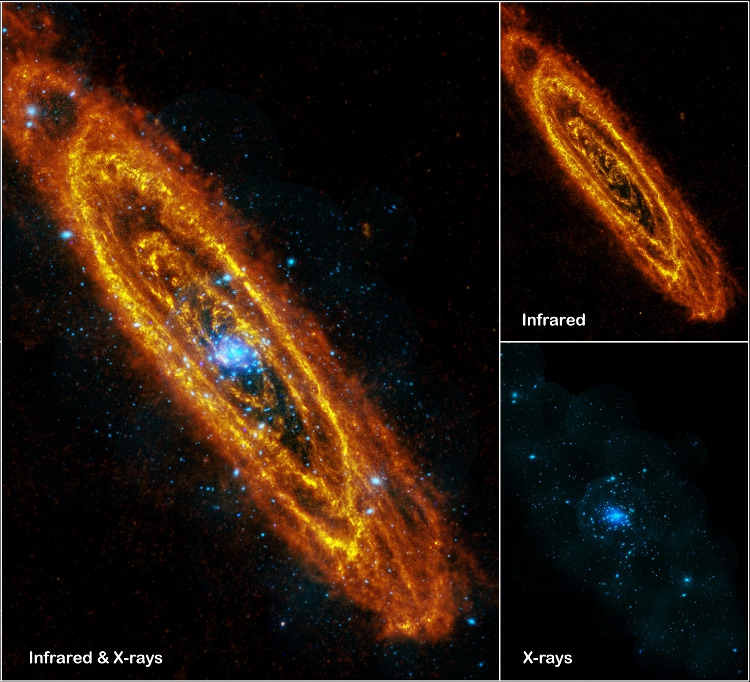 Image credits: ESA/Herschel/SPIRE/HELGA and ESA/XMM/EPIC/OM |
| January 12, 2011 | Fermi Catches Thunderstorms Hurling Antimatter into Space Scientists using Fermi Gamma-ray Space Telescope have detected beams of antimatter produced above thunderstorms on Earth. They think the antimatter particles were formed in a terrestrial gamma-ray flash (TGF), a brief burst produced inside thunderstorms and shown to be associated with lightning More Information available on: http://www.nasa.gov/mission_pages/GLAST/news/fermi-thunderstorms.html |
| January 4, 2011 | Terrestrial Gamma-Ray Flashes as Powerful Particle Accelerators AGILE latest article on Terrestrial Gamma-Ray Flashes (TGFs) reporting the discovery of gamma-ray radiation up to 100 MeV from Earth thunderclouds was published on January 3, 2011 by Phys. Rev. Letters: "Terrestrial Gamma-Ray Flashes as Powerful Particle Accelerators", M. Tavani et al. (AGILE Team), Phys. Rev. Lett. 106, 018501 (2011) . Download PDF (free) See also J. Dwyer Viewpoint published on Physics (Jan. 3, 2011):"Chance of thunder and gamma-ray flashes" 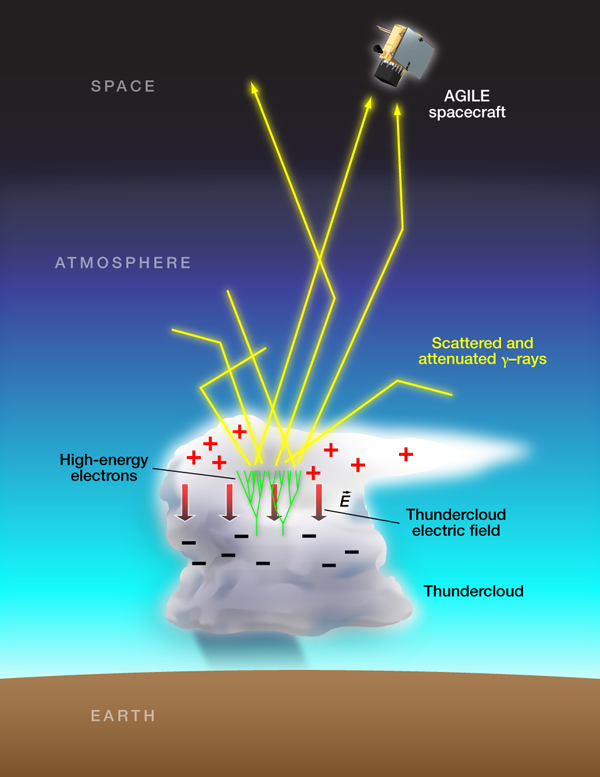 Figure credits: APS Physics/Alan Stonebraker |
| December 21, 2010 | Reprocessed AGILE Cycle-1 and Cycle-2 Public Data Now Available A new version of the whole AGILE archive for all Cycle-1 and Cycle-2 data, reprocessed with the latest available software (sw=5_19_18_17) is now available, including data of the last two AGILE Cycle-2 Observation Blocks (OB8300 and OB8400) whose proprietary period expired today. This is the same software version used for the creation of the proprietary Cycle-3 data delivered to successful proponents of the AO3 AGILE Guest Observer Program. During Cycle-1 and Cycle-2 AGILE was operated by performing long observations, called Observation Blocks (OBs), typically of 2-4 weeks duration. On November 4, 2009, toward the end of Cycle-2, AGILE scientific operations were reconfigured following a malfunction of the rotation wheel occurred in mid October,2009. The satellite is currently operating regularly in a spinning observing mode, surveying a large fraction of the sky each day. As in previous public deliveries, AGILE public data in pointing observing mode have been cleaned by eliminating time periods corresponding to repointing slews and occasional losses of fine-pointing attitude. Moreover the present data release also includes non-cleaned data, treated in a similar way to those presently taken in spinning observing mode. WARNING: to avoid spurious artefacts, this set of non-cleaned data must be carefully analysed using a smaller field of view (fovrad=50). The new public data are available from the ASDC Multimission Archive webpage for the AGILE Mission. Data delivery details can be found in the AGILE_data_release_note_v5.0 (txt, pdf) |
| November 30, 2010 | AGILE detection of the transient gamma-ray source AGL J1037-5708 New ATel issued: ATel #3059 (A. Bulgarelli et al.) |
| November 22, 2010 | Decreasing gamma-ray emission from the blazar 3C 454.3 New ATel issued: ATel #3049 (E. Striani et al.) |
| November 19, 2010 | AGILE detection of the extraordinary and prolonged gamma-ray activity from 3C 454.3 New ATel issued: ATel #3043 (E. Striani et al.) |
| November 17, 2010 | AGILE detects another extraordinary gamma-ray flare from the blazar 3C 454.3 New ATel issued: ATel #3034 (E. Striani et al.) |
| November 11, 2010 | AGILE Cycle-3 Guest Observer data now available The AGILE Data Center announces that Cycle-3 Guest Observer data from December 1, 2009 to October 15, 2010 are now available. All Cycle-3 Guest Observers have been invited via email on November 9, 2010 to login from the AGILE Data Center home page to the Guest Observer Program area with their username and password to retrieve available data for their accepted proposals. AGILE Cycle-3 data obtained with AGILE observing a large portion of the sky in spinning mode, have been processed with the latest available software and calibrations optimized for the new AGILE observing mode. |
| November 10, 2010 | Fermi Finds Giant Bubble Structure in our Galaxy Fermi Gamma-ray Space Telescope has unveiled a previously unseen structure centered in the Milky Way. The feature spans 50,000 light-years and may be the remnant of an eruption from a supersized black hole at the center of our galaxy. More information are available on: http://www.nasa.gov/mission_pages/GLAST/news/new-structure.html |
| November 5, 2010 | AGILE detects gamma-ray emission from AGL J2330-5036, in the region of BZQ J2329-4955 (PKS 2326-502) New ATel issued: ATel #3008 (F. Lucarelli et al.) |
| November 1, 2010 | AGILE/GRID detection of increased gamma-ray emission from 3C 454.3 New ATel issued: ATel #2995 (S. Vercellone et al.) |
| October 26, 2010 | AGILE detection of AGL J0813+2420, a new unidentified gamma-ray source New ATel issued: ATel #2971 (F. Lucarelli et al.) |
| October 17, 2010 | AGILE detection of prolonged gamma-ray activity from the blazar PKS 1830-211 New ATel issued: ATel #2950 (I. Donnarumma et al.) |
October 7, 2010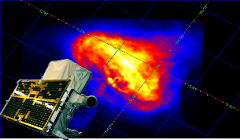 | The Crab "goes wild" in gamma-rays More suprises from sky observations in gamma-rays. The ASI satellite AGILE, thanks to its sky monitoring capability and fast ground segment alert system, has discovered an increased gamma-ray flux above 100 MeV from a source positionally consistent with the Crab Nebula. The unexpected discovery has been promptly reported on September 23, 2010 in ATel #2855 (M. Tavani et al.), and confirmed the next day by the Fermi satellite in ATel #2861 (R. Buehler et al.). Fermi interrupted its all-sky scanning mode and completed a dedicated pointed observation of the Crab Nebula from 2010-09-23 to 2010-09-27 to increase its exposure on the source. Measurements taken starting on 23 September show that the gamma-ray flux is back to normal values, see ATel #2879. The Crab Pulsar and Nebula are the remnants of the explosion of the supernova SN1054, and the spectra containing the diffuse and pulsed emission has always been considered the standard X-ray candle for X-ray and gamma-ray satellites used also for instrument calibration. Following the surprising discovery by AGILE, the results of INTEGRAL observations of the Crab nebula, performed for calibration purpose, and the Swift/BAT team routine monitor of the source were reported in ATel #2856 and ATel #2858 respectively. In these hard X-rays observations, however, no statistically significant increase in the Crab flux was observed. Special ToO observations were then requested and performed by Swift, see ATel #2866, Chandra, see ATel #2882, and Hubble Space Telescope, see ATel #2903. Comparing the current Crab Nebula image with the extensive database available in the HST public archive, an increased emission about 3 arcsec East of the pulsar was noticed. The Chandra exposure, taken a few days before the HST one, reported a brightening from the same region. Gamma-ray data suggests that the origin of the flare is related to the nebula rather than the pulsar emission, and provide evidence for particle acceleration mechanisms in nebular shock regions more efficient than previously expected from current theoretical models. 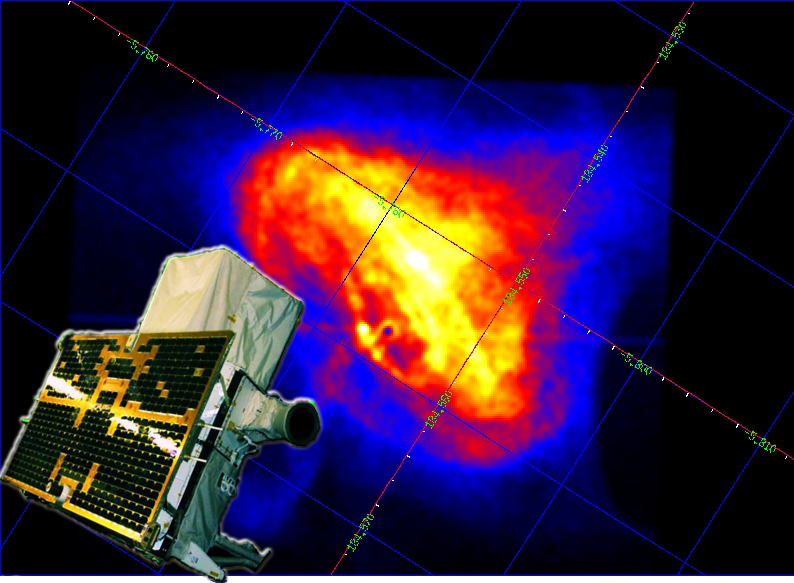 In the image background: Chandra X-ray Observatory data from the ToO observation of Crab on September 28, 2010, following the gamma-ray flare detected by AGILE. |
| October 6, 2010 | AGILE Cycle-2 Public Data Now Available The proprietary period for the AGILE Cycle-2 Observation Blocks (OB) from OB 6500 to OB 8200 has currently expired, and the data are public and available from the ASDC Multimission Archive webpage https://www.ssdc.asi.it/mmia/ for the AGILE Mission The set of GRID data which become public today corresponds to the first 22 AGILE observations of Cycle-2, from 2008-11-30 to 2009-09-30, following the second year AGILE Baseline Pointing Plan and including 2 Target of Opportunities (ToO) and 1 Partial Repointing. Data delivery details can be found in the AGILE_data_release_note_v4.0 (txt, pdf) |
| September 28, 2010 | AGILE upper limits above 100 MeV regarding the recent transient MAXI J1659-152 New ATel issued: ATel #2880 (F. Lucarelli et al.) |
| September 22, 2010 | AGILE detection of enhanced gamma-ray emission from the Crab Nebula region New ATel issued: ATel #2855 (M. Tavani et al.) |
September 15, 2010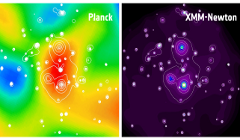 | Planck discovery of a supercluster of galaxies through SZ effect Clusters of galaxies are amongst the largest objects in the Universe. They are filled by a hot gas which interacts with the Cosmic Microwave Background (CMB) photons producing a characteristic distortion in the CMB blackbody spectrum known as Sunyaev-Zel'dovich effect. Thanks to its wide and well designed frequency coverage, the ESA Planck satellite has detected many clusters of galaxies through the S-Z effect during its survey of the microwave sky. A dedicated follow up program carried out with the ESA X-ray mission XMM-Newton has shown that one of the clusters detected by Planck is in fact a supercluster composed by many thousand of galaxies grouped in at least three individual massive clusters. This is the first discovery of a supercluster of galaxies through the Sunyaev-Zel'dovich effect. More information are available on: http://www.media.inaf.it/2010/09/15/il-gigante-dei-giganti/ (italian) http://sci.esa.int/science-e/www/object/index.cfm?fobjectid=47692 (english) 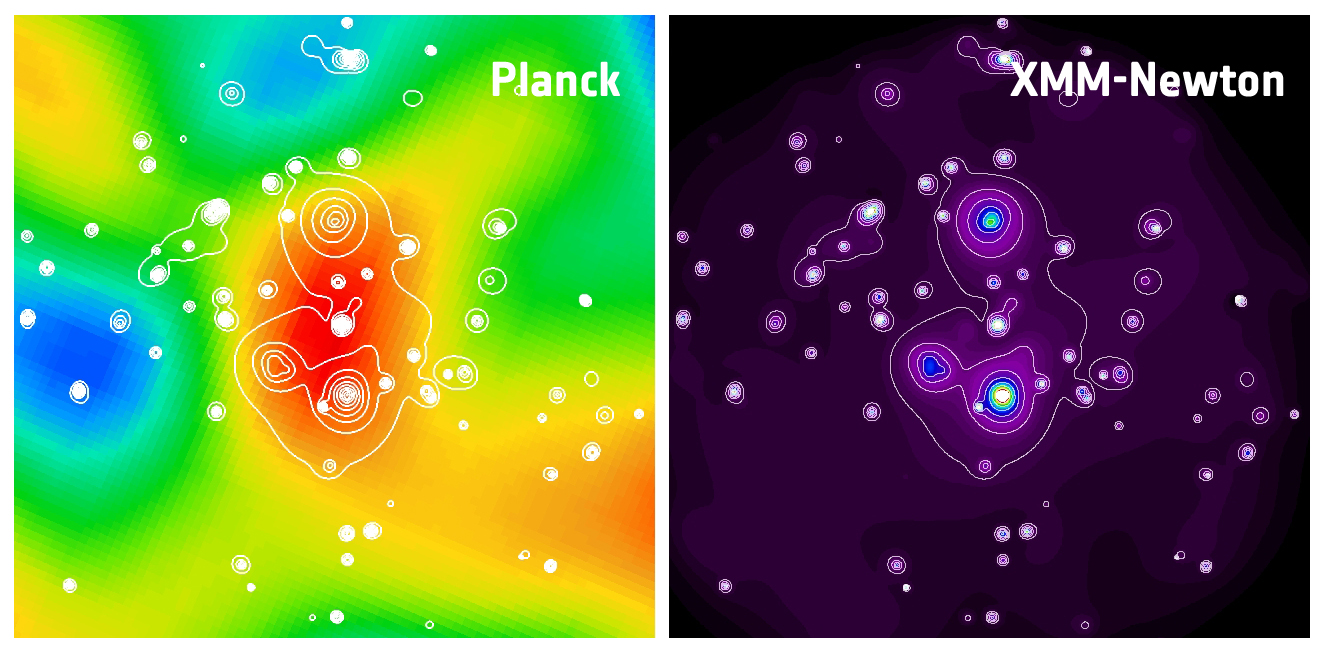 Credit: Planck image: ESA/LFI & HFI Consortia; XMM-Newton image: ESA |
| August 5, 2010 | AGILE detection of transient gamma-ray emission from the PSR B1259-63 region New ATel issued: ATel #2772 (M. Tavani et al.) |
| July 27, 2010 | AGILE detection of the new unidentified gamma-ray source AGL J2241+4454 New ATel issued: ATel #2761 (F. Lucarelli et al.) |
| July 26, 2010 | GRB 100724B: AGILE/GRID analysis New GCN issued: GCN #10996 (A. Giuliani et al.) The preliminary GRB lightcurves of AGILE MCAL and GRID instruments are shown in the figure below. 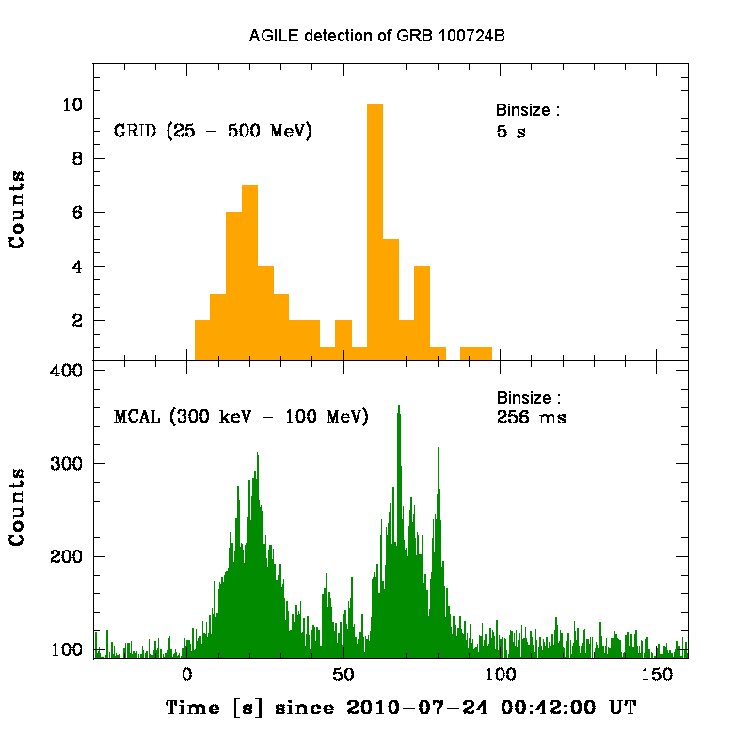 |
| July 26, 2010 | GRB 100724B: gamma-ray detection by AGILE New GCN issued: GCN #10994 (M. Marisaldi et al.) |
| July 6, 2010 | AGILE AO-3 list of approved targets The official list of all AGILE AO-3 approved targets is now available here. In all cases of gamma-ray sources partially or fully fitting the proposed error boxes specified by different groups, the AGILE Mission Board encourages collaboration among these groups . |
July 5, 2010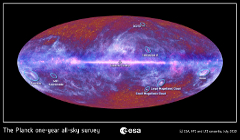 | Planck unveils the Universe � now and then The ESA Planck satellite has recently completed its first survey of the microwave sky. For the first time it has been possible to map the whole sky in frequency bands from 30 to 857 GHz. On July 5 ESA has released a low resolution version of the Planck official maps obtained combining data from all of the Planck channels. The image shows clearly the diffuse emission from the Interstellar Medium in our Galaxy, the tiny background fluctuations of the primeval Universe as well as many extragalactic sources, thus confirming the huge scientific potential of Planck. More information are available on: http://www.asi.it/it/news/planck_svela_luniverso_comera_e_com (italian) http://www.esa.int/esaCP/SEMF2FRZ5BG_index_0.html (english) http://www.media.inaf.it/2010/07/05/universo-di-planck/ (italian) 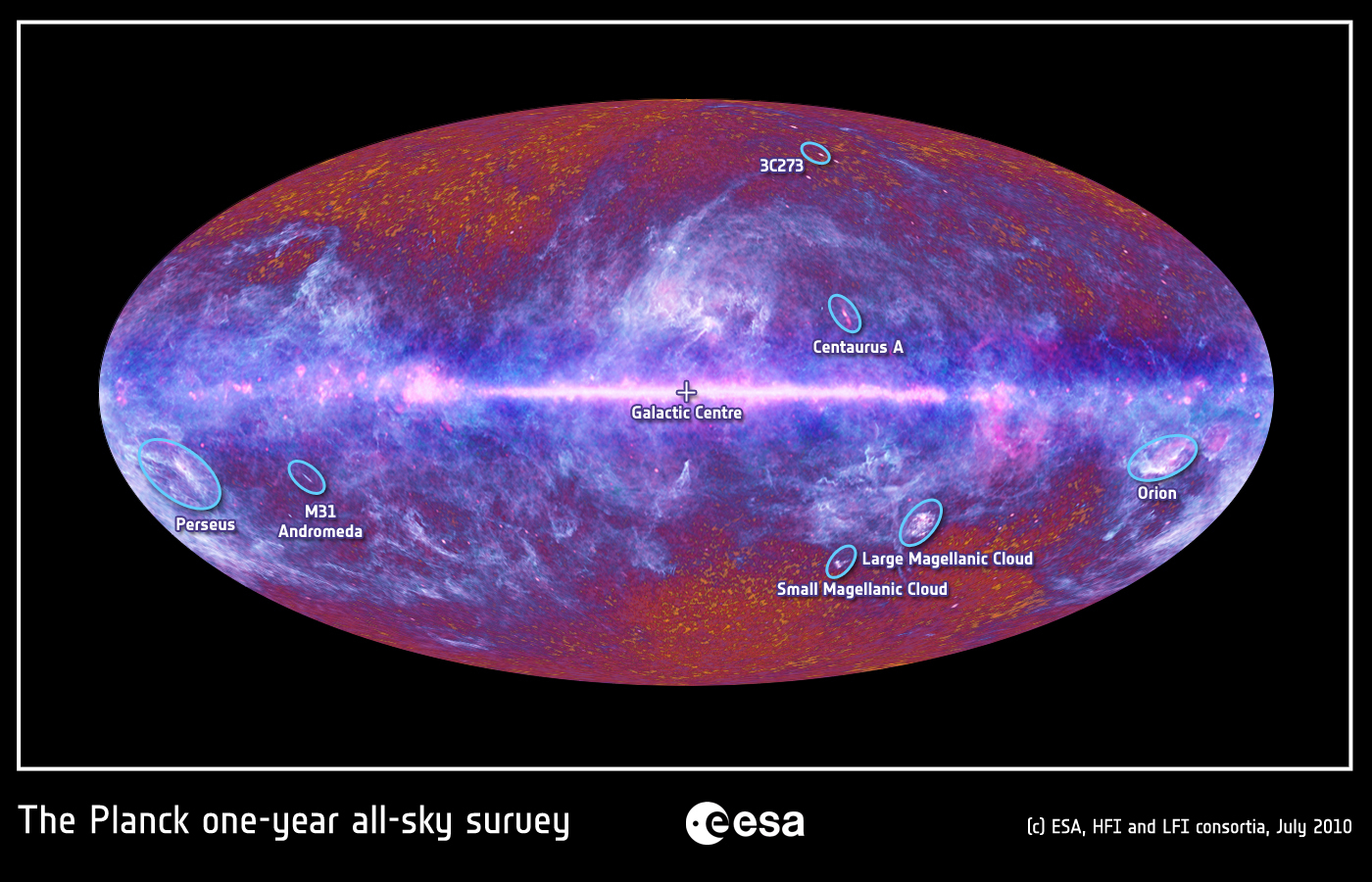 |
| July 2, 2010 | AGILE gamma-ray detection of Cygnus X-1 New ATel issued: ATel #2715 (S. Sabatini et al.) |
| July 1, 2010 | Funding of data analysis projects (ADAE): deadline postponed to July 16, 2010 The deadline for ADAE proposal submission (ASI-INAF agreement I/009/10/0) has been postponed. The new deadline is July 16, 2010 |
| June 28, 2010 | Swift follow-up of the blazar 4C+21.35 (PKS 1222+21) after a bright gamma-ray flare New ATel issued: ATel #2698 (F. Verrecchia et al.) |
| June 21, 2010 | AGILE and Fermi detection of intense gamma-ray flare from the blazar 4C+21.35 (PKS 1222+21) New AGILE ATel issued: ATel #2686 (E. Striani et al.) New Fermi ATel issued: ATel #2687 (G. Iafrate et al.) On June 19, 2010, AGILE and Fermi reported the detection of intense gamma-ray emission above 100 MeV from the Flat Spectrum Radio Quasar 4C+21.35, also known as PKS 1222+21. Flaring activity from this source has been also detected in the past few days by the MAGIC (ATel #2684) at energies above 100 GeV. |
| June 18, 2010 | Call for proposals for funding of data analysis projects We announce the opening of a call for proposals for funding of data analysis activities by Italian researchers resulting from a) Guest Observers observations in the field of High Energy Astrophysics b) Guest Observers and archival data in the field of Cosmology (with the exclusion of primordial cosmology) as foreseen by the ASI-INAF agreement I/009/10/0. Documentation (Italian language only) and application forms can be found at the following link: http://dbms.astropa.unipa.it/ADAE Deadline for proposal submission is 14 July 2010. |
| May 28, 2010 | AGILE detection of gamma-ray emission from Cygnus X-3 New ATel issued: ATel #2645 (A. Bulgarelli et al.). |
| May 28, 2010 | GRB 100528A: SuperAGILE Localization of a Long GRB New GCN issued: GCN #10810 (E. Del Monte et al.) |
| May 26, 2010 | AGILE detection of gamma-ray emission from 4C+21.35 (PKS 1222+21) New ATel issued: ATel #2641 (A. Bulgarelli et al.) |
| May 20, 2010 | The first Herschel In-flight Announce of Opportunity is now open! This is the first in-flight Herschel Announcement of Opportunity for observing proposals. It will be followed by another AO in about a year's time. The AO is open to the world wide scientific community. More information can be found here |
| May 13, 2010 | Swift discovered a long gamma-ray burst GRB 100513A at z~4.8 On May 13, at 02:07:08 UT, the Swift Burst Alert Telescope (BAT) triggered and located a distant long Gamma-Ray Burst GRB 100513A. Thanks to the Swift X-ray Telescope (XRT), the X-ray afterglow was detected and localized with 2.5 arcseconds uncertainty only two minutes after the burst trigger. Several ground based observations revealed the optical counterpart within 1 hour after the trigger. The redshift of this burst has been estimated z=4.772 through the optical afterglow spectrum, taken 4.1 hours after the burst with the 8 m Gemini North telescope. So far, about 15 GRBs have been detected with z>4. More details on this discover can be found here. |
| May 10, 2010 | AGILE detection of gamma-ray emission from the Cygnus X-3 region New ATel issued: ATel #2609 (A. Bulgarelli et al.) |
April 19, 2010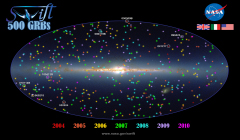 | Swift catches its 500th Gamma-ray Burst! On April 13 Swift discovered GRB 100413B in the constellation Cassiopeia, the 500th burst detected during its five years life. It is a long burst, a type usually associated with the death of a massive star. Swift satellite was launched in November 2004 and primarily studies gamma-ray bursts (GRBs), the biggest and most mysterious explosions in the cosmos. "Each burst has turned over a new piece of the puzzle and a clearer picture is emerging." said Neil Gehrels, Swift's lead researcher at Goddard Space Flight Center in Greenbelt, USA. The figure shows the locations of Swift's 500 gamma-ray bursts, color coded by the year in which they occurred. In the background, an infrared image shows the location of our galaxy. Cick here to view the video showing the GRB highlights of the Swift mission. For more details see the NASA press release, the INAF press release and the news on the ASI site. 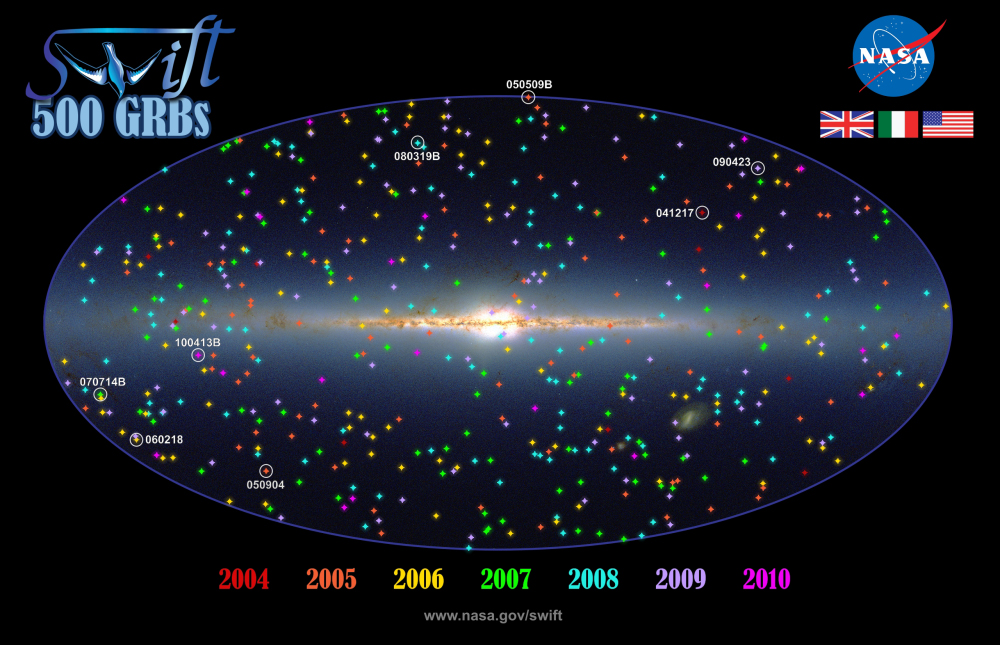 Credit: NASA/Swift/Francis Reddy |
| April 14, 2010 | AGILE detection of the new unidentified gamma-ray source AGL J0906-1241 New ATel issued: ATel #2552 (C. Pittori et al.) |
| April 14, 2010 | AGILE detects enhanced gamma-ray emission from the blazar PKS 2142-758 New ATel issued: ATel #2551 (F. Verrecchia et al.) From 2010-04-10 11:30 UT to 2010-04-12 21:00 UT, AGILE has been detecting an increasing gamma-ray flux above 100 MeV from a source positionally consistent with the blazar PKS 2142-758. The source does not appear in the latest versions of gamma-ray catalogs but a recent gamma-ray flaring episode from this blazar was reported by the Fermi LAT Collaboration in ATel #2539. |
| April 13, 2010 | Swift discovered a long gamma-ray burst GRB 100431A On April 13, 2010 at 17:33:28 UT, the Swift Burst Alert Telescope (BAT) triggered and located a long gamma-ray burst named GRB 100413A. As for many GRBs, the burst started before the detector trigger time T, at ~T-45 s. A first cluster of peaks ends at ~T+40 s followed by a second one starting around T+90 s, up to T+240 s. The emission does not return to background between the two clusters. Swift slewed to the burst 140 s after the trigger and the X-ray telescope XRT revealed the X-ray afterglow. No optical counterpart was detected with the UV-optical telescope UVOT on board Swift and with several ground based optical telescopes. A tentative redshift of this burst was estimated from X-ray analysis of the photoelectric absorption. The higher significance solution was found for very large distances (redshift z~4). Although low redshift solution cannot be excluded yet, the high redshift solution compares well with the non-detection of the optical afterglow counterpart with UVOT and other robotic telescopes. More details on this discover can be found here. |
| April 9, 2010 | 8th AGILE Mini-Workshop - The Third Birthday We are pleased to announce the AGILE 8th Workshop to be held in Bologna (Italy) INAF-IASF, Area Ricerca, on April 28, 2010. The Workshop is aimed at providing an overview of the most relevant astrophysics results with a special afternoon session on Terrestrial Gamma-Ray Flashes (TGFs). Information about the Workshop, the registration form, the preliminary wokshop program, the logistic information can be found at https://www.ssdc.asi.it/8thagilemeeting/index.php For organizational purposes please notify your participation by registering at the workshop web site. |
| April 7, 2010 | GRB 100331B: SuperAGILE Localization of a Long GRB SuperAGILE detected a long gamma ray burst on March 31, 2010, at 21:08:38 UT. The burst position was reconstructed as: RA(J2000) = 20h 11m 56.95s Dec(J2000) = -11d 04' 02.04" with an uncertainty of 6' radius to account for possible systematics error due to the AGILE satellite spinning mode. A description of the burst can be found in GCN #10560 (E. Del Monte et al.) |
| March 30, 2010 | AGILE AO3 now open The Italian Space Agency (ASI) announces the release of the third Announcement of Opportunity (AO3) for the Guest Observer Program of the AGILE mission. AO3 key dates: - Release of AO3: March 30, 2010 - Due date for proposals: April 30, 2010 - AO3 Observing Period (Cycle-3): December 1, 2009 - November 30, 2010 The complete documentation for this AO3 can be found on-line at the AGILE-ASDC web pages https://agile.ssdc.asi.it/ao3.html. |
| March 25, 2010 | AGILE detection of a gamma ray flare from the Cygnus X-1 region New ATel issued: ATel #2512 (A. Bulgarelli et al.). |
| March 24, 2010 | Emerging Supernova in the Afterglow of GRB 100316D Long gamma-ray bursts (GRBs) are thought to be associated with the supernova (SN) phase of massive stars. However, spectroscopic evidence of SN signatures in the optical afterglow spectra have been detected only for nearby GRBs. So far only few GRBs have been observed at small redshifts (z<0.5) and one of these is the recent GRB 100316D at redshift z=0.059. A high-dispersion optical spectrum (range 350-900 nm, resolution 0.02 nm) of the afterglow associated to GRB 100316D was obtained with the VLT telescope (+XShooter) at ESO-Paranal on March 23.04 UT. The spectrum of the source shows very broad bumps with peaks reminiscent of an emerging broad line type Ic supernova. Indeed, the NIR spectrum of this source shows some similarities with that of SN 1998bw taken 7 days after outburst. There are however major differences with the spectrum of this transient, showing a significant flux deficiency in the visible in comparison with SN 1998bw. More details on this discover can be found here. |
| March 19, 2010 | Swift discovers a new Soft Gamma Repeater SGR 1833-0832 On March 19, 2010, at 18:34:50 UT, the Swift Burst Alert Telescope triggered and located a very short (16 ms) and soft (<100 keV) burst near the Galactic plane. The burst was soon recognized to be a burst from a new Soft Gamma Repeater (SGR) enabling its discovery and classification as SGR 1833-0832. Following the Swift discovery of the new SGR, a ToO program was activated with RXTE on 2010, March 19 and a coherent pulsations from the new SGR in the 2-20 keV PCA data at 0.1321 Hz was detected, corresponding to a spin period of 7.57 sec. Timing analysis on Swift/XRT data in PC mode confirmed the period detection, further confirming the discovery of a new, burst-active SGR. Archival Chandra ACIS-S observations of the field of the newly discovered Soft Gamma Repeater SGR 1833-0832 show no point source within the best Swift XRT error circle on 2009 February 13 with 8 ks of exposure. All the circulars (GCN) of SGR 1833-0832 can be found here. |
| March 16, 2010 | AGILE detects enhanced gamma-ray emission from the blazar PKS 0402-362 New ATel issued: ATel #2484 (E. Striani et al.) . |
| March 16, 2010 | Four Gamma-ray Bursts have been detected with Swift within 02:23 UT and 12:44 UT Four Gamma-ray bursts detected in the very same day is an extremely rare event since these objects have an average detection rate of about 1 each 3 days. Among hundreds of detected GRBs, there is only one analogous case of four GRBs detected on March, 19 2008. GRB 100316A, a Fast Rise Exponential Decay (FRED) 7 s long burst, was detected on March, 16 at 02:23:00 UT with Swift/BAT: an X-ray afterglow was detected and a tentative optical counterpart has been identified. All the Gamma-Ray bursts Coordinates Network Circulars (GCN) of GRB 100305A can be found here . At 08:01:36 UT a second burst, named GRB 100316B, was detected with Swift/BAT, with 5 s long multi-peak light curve. An X-ray afterglow with an optical counterpart was detected with Swift/XRT and Swift/UVOT, as well as from several ground based telescopes (GROND, Skynet/PROMPT, VLT/X-shooter). Optical spectral analysis performed with VLT/X-shooter shows several absorption features at a common redshift of z=1.180. All the Gamma-Ray bursts Coordinates Network Circulars (GCN) of GRB 100305B can be found here . A third GRB (100316C) triggered Swift/BAT at 08:57:59 UT of the same day. The BAT light curve showed a single-peaked structure with a duration of about 7 sec. An X-ray afterglow was detected with Swift/XRT. A possible optical counterpart was detected with the ground-based robotic telescope GROND. All the Gamma-Ray bursts Coordinates Network Circulars (GCN) of GRB 100305C can be found here . At 12:44:50 UT GRB 100316D was detected with Swift/BAT. The burst and the X-ray afterglow light curves and spectra are very non-typical for a GRB and similar to the GRB060218-SN2006aj burst (Campana, et al.; Nature, v224, p1008, Figure 1). The 5 arcsec XRT error circle, covers the edge of an extended DSS optical object. Two optical sources, consistent with the X-ray afterglow error circle, were resolved with the ground-based telescopes VLT/X-shooter and Gemini/GMOS. In the X-shooter spectra of both sources, several bright emission lines have been detected at a common redshift of 0.059, suggesting that these are two regions of a nearby galaxy. It is still unknown if this nearby galaxy is related with GRB 100316D. Further analysis and observations are in progress. A tentative redshift has been estimated from X-ray data analysis in the range 0.014 < z < 0.6. All the Gamma-Ray bursts Coordinates Network Circulars (GCN) of GRB 100305D can be found here . |
| March 5, 2010 | The Swift Burst Alert Telescope (BAT) triggered and located the gamma-ray burst GRB 100305A The Swift Burst Alert Telescope (BAT) triggered and located the long GRB 100305A. The BAT light curve showed a single-peaked structure with a total duration of about 20 sec. Swift slewed about 2 minutes after the burst and the afterglow X was detected with XRT. The X-ray light curve shows a single bright flare followed by a power law decay. No optical source has been found in the XRT error circle from space and ground-based observations, making this burst a good high-redshift source candidate although high dust extinction cannot be excluded yet. All the Gamma-Ray bursts Coordinates Network Circulars (GCN) of GRB 100305A can be found here. |
| March 4, 2010 | SuperAGILE detection of an X-ray burst from 4U 1608-522 New ATel issued: ATel #2461 (E. Del Monte et al.). On March 3, 2010 at 06:33:25 UT SuperAGILE detected an X-ray burst from a sky position consistent with the neutron star transient and atoll source 4U 1608-522. The SuperAGILE detection revealed a reactivation of the source, as confirmed by the MAXI/GSC detection of an X-ray brightening of the persistent emission (ATel #2462, M. Morii et al.) The SuperAGILE light curve of the event is shown in the figure. 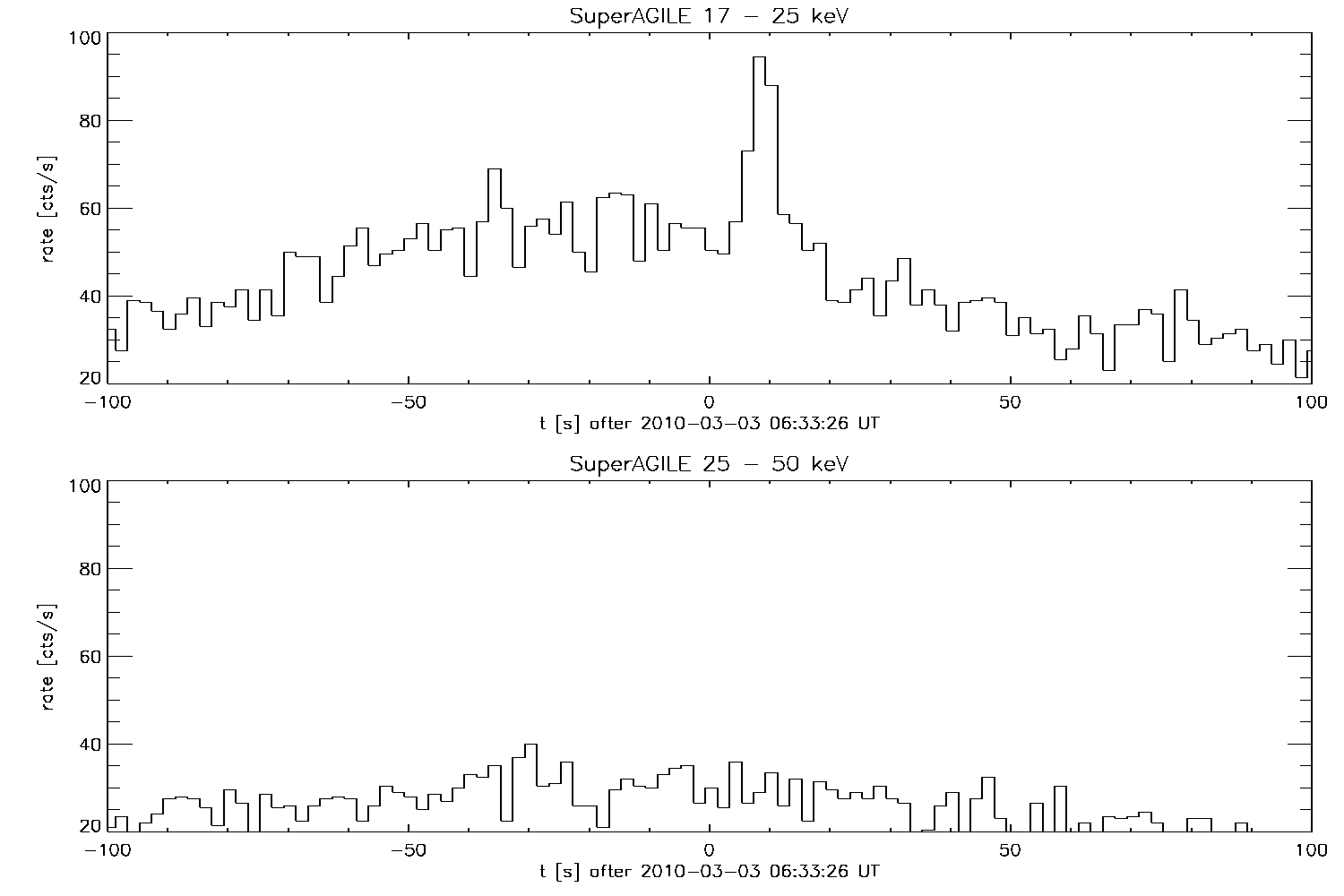 |
| March 3, 2010 | The Swift Burst Alert Telescope (BAT) triggered and located the gamma-ray burst GRB 100302A The Swift Burst Alert Telescope (BAT) triggered and located GRB 100302A. Swift slewed 2 minutes after the burst and the afterglow X was detected with the Swift X-ray telescope XRT. The X-ray light curve shows an intense flaring activity followed by the canonical shallow decay phase. A fading optical source has been found in the XRT error circle from ground-based observations, identified as the afterglow optical counterpart. All the Gamma-Ray bursts Coordinates Network Circulars (GCN) of GRB 100302A can be found here. |
| February 24, 2010 | AGILE detects enhanced gamma-ray emission from the blazar PKS 0537-441 New ATel issued: ATel #2454 (F. Lucarelli et al.) |
| February 19, 2010 | The Swift Burst Alert Telescope (BAT) triggered and located the gamma-ray burst GRB 100219A (19 Feb. 2010) The Swift Burst Alert Telescope (BAT) triggered and located GRB 100219A. Swift slewed 3 minutes after the burst and detected the afterglow both with XRT and UVOT. Several ground based optical telescopes have monitored the afterglow. In particular, observations performed with the VLT equipped with the X-shooter spectrograph taken 0.47 days after the burst, revealed a redshift of z=4.7 and several intervening systems along the line of sight. All the Gamma-Ray bursts Coordinates Network Circulars (GCN) of GRB 100219A can be found here. |
| February 18, 2010 | Helical magnetic fields in the Jet of the quasar 3C 279? A large multi-wavelength observational campaign, involving 250 scientists and 20 ground and space telescopes, was organized to study the blazar 3C 279 during the first year in orbit of the Fermi gamma-ray space telescope. The unexpected important result, just published in Nature, came from the combination of optical polarimetric observations with gamma-ray data. The insights into the structure of quasar jets from gamma-ray and optical polarimetric observations show a non-axisymmetric jet structure implying a curved trajectory for the emitting material within the jet, with the dissipation region located at a considerable distance from the black hole. This may suggest that the flaring activity is indeed related to the change of geometry and/or viewing angle rather than to the acceleration and cooling event in the jet. A joint ASI-INAF and SLAC press release has appeared on their respective websites. |
February 15, 2010 | The AGILE satellite detects "super-energetic TGFs" that could affect air travel "Terrestrial Gamma-Ray Flashes" (TGF) are phenomena of terrestrial (atmospheric) origin only lasting a few milliseconds that are likely associated to very intense tropical thunderstorms. The AGILE satellites detected several of these events since its first months of operations. The AGILE equatorial orbit, together with its advanced payload capabilities, allowed the discovery of TGFs with gamma-ray energy reaching up to 50 MeV. Such highly energetic radiation must be produced in atmospheric conditions requiring potential differences of 100 Mega Volts or more, hundreds of times larger than that required to produce the usual terrestrial lightning. As announced in a joint press release that can be found on the ASI and INAF websites, the AGILE Team and ASI are collaborating with ENAC (Ente Nazionale per l'Aviazione Civile) to understand the possible hazards to air traffic that these very energetic atmospheric events might cause. THE AGILE paper "Detection of Terrestrial Gamma-Ray Flashes up to 40 MeV by the AGILE satellite" by M. Marisaldi et al. (2009), previously announced on this website on October 29th 2009, is now being published in the Journal of Geophysical research and it is accessible on-line at: https://www.ssdc.asi.it/news/Marisaldi2009_AGILE-TGF.pdf |
| February 3, 2010 | AGILE confirmation of the new gamma-ray flaring source J0109+6134 near the Galactic plane New ATel issued: ATel #2416 (S. Sabatini et al.) An AGILE gamma-ray intensity map of the field E>100 MeV in Galactic coordinates (AGILE error box in green color and FERMI detection in grey color) can be found here. |
| January 25, 2010 | AGILE detection of AGL J2206+6203, a new unidentified gamma-ray source New ATel issued: ATel #2403 (A. Bulgarelli et al.) |
| January 14, 2010 | AGILE detection of enhanced gamma-ray emission from the blazar PKS 1510-089 New ATel issued: ATel #2385 (E. Striani et al.) |
| January 8, 2010 | AGILE detection of a gamma-ray flare from the blazar 3C 273 New ATel issued: ATel #2376 (L. Pacciani et al.) |
| December 31, 2009 | AGILE Detection of Gamma-Ray Emission from the Vela Pulsar Wind Nebula The AGILE detection of Vela X, described in the Science paper "Detection of Gamma-Ray Emission from the Vela Pulsar Wind Nebula with AGILE", (A. Pellizzoni et al.), is the first experimental confirmation of gamma-ray emission (E> 100 MeV) from a pulsar wind nebula. The AGILE detection establishes Pulsar Wind Nebulae as a new class of GeV gamma-ray sources. |
| December 28, 2009 | AGILE detection of AGL J1023-3738 , a new high-Galactic latitude unidentified source New ATel issued: ATel #2361 (E. Striani et al.) |
| December 22, 2009 | All AGILE Cycle-1 Data Now Public The proprietary period for the last 9 Cycle-1 Observation Blocks (from OB 5900 to OB 6400) has expired, thus the entire Cycle-1 dataset from December 1, 2007 to Novembre 30, 2008 is now public and available from the ASDC Multimission Archive webpage https://www.ssdc.asi.it/mmia/ for the AGILE Mission. This new public delivery reflects the current best understanding and testing of calibrations, background rejection, and processing results. |
| December 15, 2009 | AGILE detection of a gamma-ray flare from the blazar PKS 1222+216 New ATel issued: ATel #2348 (F. Verrecchia et al.) |
| December 3, 2009 | AGILE detects an extraordinary gamma-ray activity from the FSRQ 3C 454.3 New ATel issued: ATel #2326 (E. Striani et al.). The AGILE Gamma-Ray Imaging Detector (GRID) has been detecting an extraordinary intense gamma-ray emission above 100 MeV from the flat spectrum radio quasar 3C 454.3. The AGILE quick-look analysis yields a source flux of about (1800 +/- 400)e-8 ph/cm2/sec (E > 100 MeV). This flux value greatly exceeds the value reported by AGILE yesterday in ATel #2322 (E. Striani et al.), showing a rapid increase (about 80%) of the gamma-ray flux of 3C 454.3 in the last 24 hours. See ATel #2326 for further details. 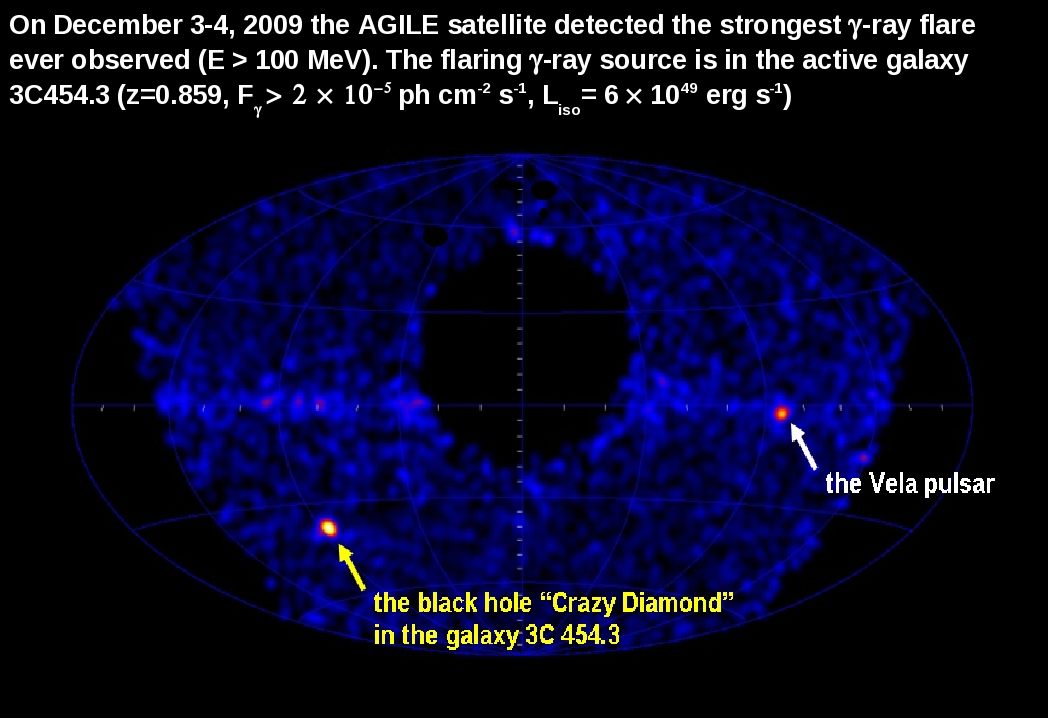 |
| December 2, 2009 | AGILE detects intense and prolonged gamma-ray activity from the FSRQ 3C 454.3 New ATel issued: ATel #2322 (E. Striani et al.) |
| November 23, 2009 | AGILE confirms high gamma-ray state of GB6 B1310+4844 New ATel issued: ATel #2310 (A. Bulgarelli et al.) |
| November 19, 2009 | AGILE first detection of gamma-rays above 100 MeV from the microquasar Cygnus X-3: to appear in Nature The paper "Discovery of extreme particle acceleration in the microquasar Cygnus X-3", by M. Tavani et al., 2009, to appear in Nature (see also arXiv:0910.5344), reports on the AGILE detection of gamma-ray flaring emission from the microquasar Cygnus X-3, which tends to occur before the onset of powerful relativistic radio jets. |
| November 12, 2009 | AGILE science operations resumed on November 4th, 2009 On November 4, 2009 at 12:25:54 the AGILE scientific operations restarted. The instrument is operating nominally, and all detectors are on and acquiring data. The satellite is currently in a safe spinning mode, with the fixed solar panels pointing towards the Sun and the GRID instrument FOV covering a good fraction of the whole sky. In the figure below we show a preliminary 100-orbit gamma-ray intensity map above 100 MeV in the spinning configuration. 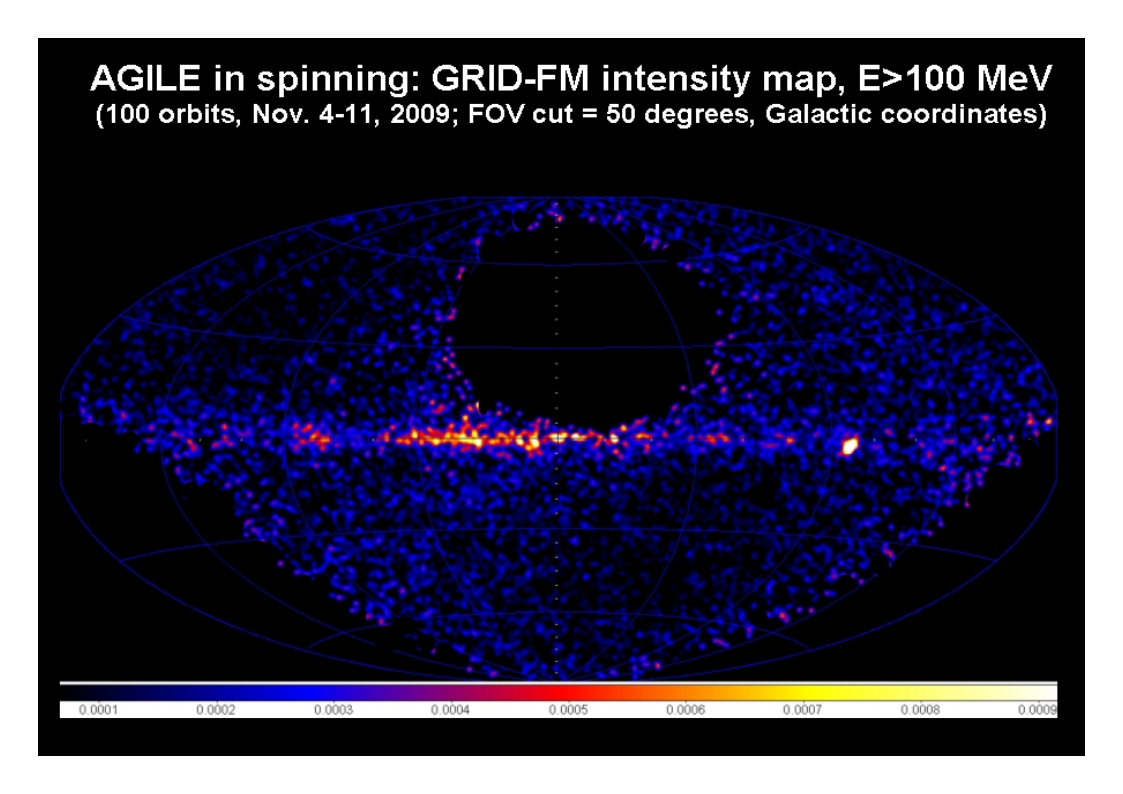 |
| October 29, 2009 | AGILE paper on Terrestrial Gamma-Ray Flashes now available The AGILE paper: "Detection of Terrestrial Gamma-Ray Flashes up to 40 MeV by the AGILE satellite", M. Marisaldi et al. 2009, is now accessible on-line here. The paper was accepted for publication in the Journal of Geophysical Research. Copyright 2009 American Geophysical Union. Further reproduction or electronic distribution is not permitted. |
| October 23, 2009 | AGILE science operations interrupted On Sunday, October 18th 2009, one of the subsystems on board the AGILE S/C suffered a malfunction that caused the satellite to leave its nominal pointing mode and switch to the "spinning" control mode. The "spinning" control mode guarantees the safety of the Spacecraft and of the Payload. Analysis is in progress in order to assess the status of the satellite and the possibility to restart operations as soon as possible. |
| October 23, 2009 | BANDO DI CONCORSO PER BORSA DI STUDIO NEL CAMPO DELLA RICERCA SPAZIALE - "Analisi dati del Large Area Telescope della missione Fermi" E� indetto un concorso per il conferimento di una borsa POST DOC, da svolgere all�Universit� di Stanford presso il LAT Operation Center (LOC) sul tema: �Analisi dati del Large Area Telescope della missione Fermi�. Durante la fruizione della borsa, il borsista dovr� svolgere attivit� di servizio legata alla gestione della missione Fermi ed all�attivit� di quick look all�interno del LAT Operation Center per non meno del 50% del tempo. Durante il tempo restante il borsista dovr� svolgere attivit� di ricerca nei seguenti campi � Ottimizzazione dei programmi di rivelazioni di sorgenti attraverso algoritmi standard e non � Ottimizzazioni dello studio della variabilit� delle sorgenti attraverso algoritmi standard e non � Gestione di cataloghi multilunghezze d�onda per facilitare l�identificazione delle sorgenti � Interpretazione dei risultati ottenuti all�interno della modellistica esistente Il responsabile scientifico del borsista sar� la Dott.ssa Patrizia Caraveo. Decorrenza presunta dell�incarico: dal 1� gennaio 2010. File allegati : invio-bando n27 FERMI-GLAST.pdf Bando 27-borsa-POST DOC-FERMI-2009 |
| October 15, 2009 | AGILE detection of the gamma-ray blazar PKS 1830-211 New ATel issued: ATel #2242 (E. Striani et al.) |
| October 14, 2009 | New AGILE public software package and test dataset available We are pleased to inform you that a new software package for AGILE-GRID data analysis is now available from the AGILE Data Center webpage https://agile.ssdc.asi.it/public/AGILE_SW_4.0_SourceCode/ The software is available both for AGILE Guest Observers and for general public users. The new AGILE software package BUILD_GRID_4.0.tgz is delivered together with a test dataset, test_dataset_4.0.tgz, and it is intended for the scientific software environment setup and testing. Warning: Since the newly delivered spacecraft auxiliary (LOG) files have a very accurate time resolution (100 msec), several GB of available disk space are needed for AGILE data analysis. The GRID analysis software is continuously evolving and regularly updated by the AGILE instrument Team and delivered to the AGILE Data Center (ADC) located in Frascati at the ASI Science Data Center for further testing, standardisation and integration into the ADC data analysis system. This public delivery reflects the current best understanding and testing of calibrations, background rejection, and processing results. |
| October 14, 2009 | Reprocessed AGILE Public Data Now Avalaible The AGILE-GRID public data release (v2.0) is now available from the ASDC Multi Mission Interactive Archive webpage: https://www.ssdc.asi.it/mmia/ which can be also reached from the AGILE home page: https://agile.ssdc.asi.it by clicking: Public --> Data Release The current set of public GRID data corresponds to the first 20 AGILE observations of Cycle-1, from December 1, 2007 to June 30, 2008. Plese note that all Cycle-1 OB data already included in previous deliveries have been reprocessed with the latest available software. MAIN IMPROVEMENTS: - Event filters: in previous data delivery a conservative event filter (F4) was used, optimized to select gamma-ray events within the central Field of View zone (< 40 deg radius) at the expenses of the effective area. The new standard AGILE event filter (FM) is optimized up to 60 deg off-axis. - Spacecraft auxiliary (LOG) files: the newly delivered auxiliary LOG files have a very accurate time resolution (100 msec) This new public delivery reflects the current best understanding and testing of calibrations, background rejection, and processing results. The previous public data release (v1.0) is still available from the MMIA AGILE webpage by selecting: Old Processing Archive. Data delivery details can be found in the AGILE_data_release_note_v2.0 (txt, pdf) |
| October 14, 2009 | GRB 091010: SuperAGILE Localization, AGILE-MCAL measurement and GRID upper limit SuperAGILE detected a long gamma ray burst on 10 October 2009,at 02:43:09 UT. The burst position was reconstructed as: RA(J2000) = 19h 54m 40.51s (298.669 deg) Dec(J2000) = -22d 32' 17.36" (-22.538 deg) with an uncertainty of 3' radius. A description of the burst can be found in GCN #10004 (I. Donnarumma et al.) and GCN #10005. AGILE-MCAL measurement and GRID upper limit for GRB 091010 can be found in GCN #10022 (M. Marisaldi et al.) In the figure below we report the superposition of the lightcurves of GRB 091010 as detected by SuperAGILE (on top, 17 - 60 keV) and MCAL (at bottom, 330 keV - 2 MeV). No significant signal is detected in MCAL above 2 MeV . 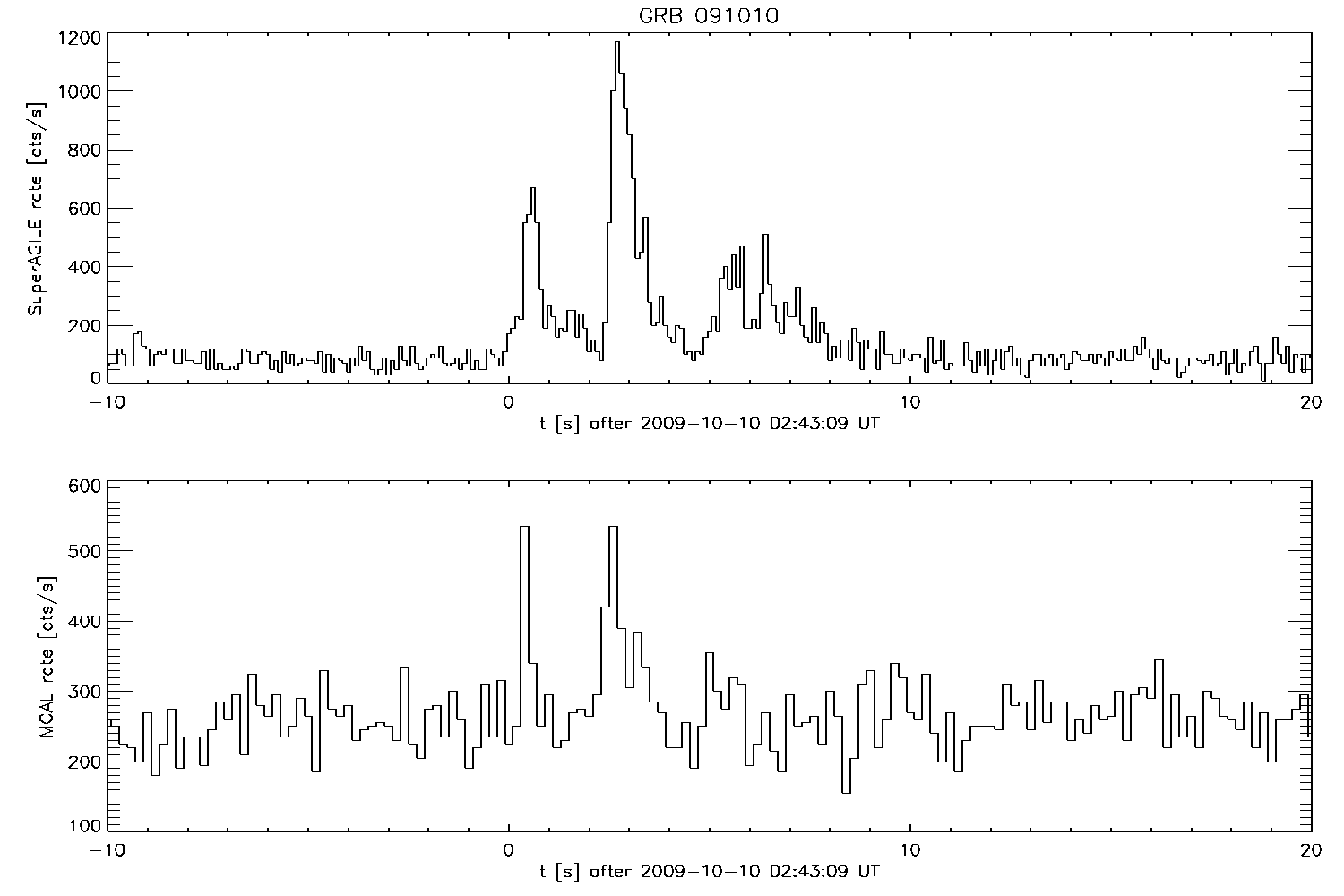 |
| October 14, 2009 | SuperAGILE detection of a type I X-ray burst from a position consistent with HETE J1900.1-2455 On 9 October 2009 02:57:43 UT SuperAGILE detected a type I X-ray burst from a sky position consistent with the accreting millisecond pulsar HETE J1900.1-2455. SuperAGILE detection details can be found in ATEL #2238 (Y. Evangelista et al.) |
| October 6, 2009 | RIUNIONE NAZIONALE per "NEW HARD X-RAY MISSION" 12 e 13 Novembre, ASDC-ESRIN, Aula Magellan RIUNIONE NAZIONALE PER DISCUTERE DI "NEW HARD X-RAY MISSION" 12-13 Novembre 2009 ASDC-ESRIN, Aula Magellan Via Galileo Galilei, Frascati L�esplorazione dell'universo nella banda degli X duri, al di sopra dei 10 keV, con le stesse capacita' di sensibilita' e risoluzione spaziale disponibili nella banda degli X soffici, al di sotto dei 10 keV, rappresenta uno degli obiettivi primari individuati dalla comunit� scientifica internazionale, e riconosciuto dalle agenzie spaziali pi� importanti. A questo, in tempi pi� recenti si e' aggiunta la necessita' di disporre di misure di polarimetria nella banda X. A queste tematiche fu assegnata la massima priorit� nello studio commissionato da ASI nel 2004 alla comunit� scientifica italiana (vedi documento Costa E., Perola C., Puglierin G., "Feasibility study on High Energy Astrophysics: field of interest and perspectives for the national community�, 2004). Stante questa situazione ed a seguito della cancellazione di Simbol-X da parte dell'agenzia francese per problemi programmatici, i ricercatori e gli istituti coinvolti nelle attivit� di cui sopra hanno preparato un documento di aggiornamento della missione "New Hard X-ray Mission" (NHXM), che, tenendo conto delle configurazioni precedentemente analizzate, e' basato su una struttura espandibile in grado di raggiungere una lunghezza focale di almeno 10 metri. Il modulo ottico prevede quattro telescopi identici (FoV=12�): tre di questi avranno nel fuoco tre camere identiche in grado di ottenere immagini (HEW<20�� a 30 keV) e spettri (E/DE=40-50 a 6, e a 60 keV) nella banda 0.5-80 keV, mentre il polarimetro X, sensibile nella banda 2-35 keV, sar� ospitato nel fuoco del quarto telescopio. NHXM si pone quindi come progetto di riferimento per la comunita' interessata a questo tipo di missione ed e' importante che tutti abbiano l'opportunita' sia di contribuire che di aderire al progetto. Il documento di cui sopra e' gia' stato distribuito a molti di voi e da molti sottoscritto, coloro che ancora non lo avessero lo possono scaricare al link http://www.brera.inaf.it/NHXM/ Pertanto chiediamo a tutti coloro che desiderano sottoscriverlo e che ancora non ce lo hanno comunicato, di comunicarcelo per e-mail all'indirizzo NHXM@brera.inaf.it entro il 9 ottobre 2009. Riteniamo inoltre opportuno un incontro nazionale dedicato, per presentare il nuovo concetto di NHXM alla comunit� nazionale, raccogliere idee e contributi, e discutere gli scenari possibili. La riunione si svolgera' presso l'ASDC, nella sede di ESRIN dell'ESA, Aula Magellan, a partire dalle ore 11 di giovedi' 12 novembre, per concludersi alle ore 17:00 del giorno sucessivo, 13 novembre, con la seguente Agenda (che verra' confermata di nuovo piu' avanti) e che potra' eventualmente includere qualche altro contributo se vi fossero delle proposte da parte della comunita': Giorno 1: 11:00 - Welcome (Giommi) 11:10 - Intervento del Presidente INAF (to be confirmed) (Maccacaro) 11:20 - L'attivita' stellare e il suo ruolo nella formazione stellare e planetaria (Maggio) 11:50 - L'emissione X da SNRs (Bandiera) 12:20 - L'accrescimento sugli oggetti compatti: le sorgenti galattiche (Stella) 12:50 - pausa pranzo 14:10 - Stelle di neutroni isolate (Turolla) 14:40 - Il centro galattico (Natalucci) 15:10 - Il mondo dei jet e degli shock (Ghisellini) 15:40 - L'accrescimento sui buchi neri super massivi: la varieta' degli AGN (Maiolino) 16:10 - coffee break 16:30 - NHXM: presentazione della missione e del documento (Tagliaferri) 17:00 - Concetto di missione (Attina') 17:30 - fine del primo giorno Giorno 2: 09:00 - L'emissione X nei Cluster di galassie e le code dure (Molendi) 09:30 - Risolvere il background X al suo picco (Comastri) 10:00 - Il Payload 1: le ottiche (Pareschi) 10:30 - Il Payload 2: i rivelatori di bassa ed alta energia e loro integrazione (Bellazzini) 11:15 - coffee break 11:45 - Payload 3: sistema di anticoincidenza e polarimetro (Costa) 12:30 - Indicazioni programmatico-strategiche ASI: prospettive per l'Astrofisica delle Alte Energie (ASI) 13:00 - pranzo 14:30 - Principali obiettivi scientifici di NHXM anche in confronto con Nustar, Gems, Next, IXO: La scienza galattica (Matt) La scienza extragalattica (Fiore) 15:30 - Open Discussion 17:00 - Conclusioni NB: la durata di ogni talk include 5 minuti di discussione Indicazioni sul come arrivare ad ESRIN si possono trovare al link https://www.ssdc.asi.it/asdc_location.html oppure http://www.esa.int/SPECIALS/ESRIN_SITE/GGG8UIPZ0GC_0.html#subhead4 Al fine di facilitare gli aspetti organizzativi, preghiamo tutti di confermare la propria partecipazione, mandando un e-mail all'indirizzo: NHXM@brera.inaf.it |
September 17, 2009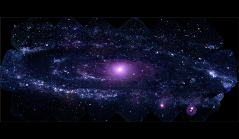 | Swift makes the highest-resolution ultraviolet image of Andromeda Galaxy The Swift satellite has acquired the highest-resolution view ever obtained in the ultraviolet band of the eighboring spiral galaxy M31 also known as the Andromeda Galaxy. The Andromeda portrait is a mosaic of 330 images acquired between May 25 and July 26, 2008, for a total exposure time of 24 hours, by Swift's Ultraviolet/Optical Telescope (UVOT). UVOT observed M31 at three different wavelengths (192.8, 224.6, and 260 nanometers) and revealed about 20,000 ultraviolet sources in a region 200,000 light-years wide. Several features are apparent in the new mosaic like the striking difference between the galaxy's central bulge and its spiral arms. "Swift is surveying nearby galaxies like M31 so astronomers can better understand star-formation conditions and relate them to conditions in the distant galaxies where we see gamma-ray bursts occurring" said Neil Gehrels, the Swift mission's principal investigator at NASA Goddard Space Flight Center. For more details see: http://www.asi.it/it/news/andromeda_in_look_ultravioletto (italian) http://www.nasa.gov/mission_pages/swift/bursts/uv_andromeda.html (english) A video with the data taken by Swift UVOT instrument is available at: http://anon.nasa-global.edgesuite.net/anon.nasa-global/ccvideos/swift_tour_m31.asx |
September 17, 2009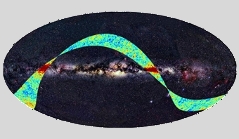 | PLANCK first light survey completed ESA�s Planck mission has completed its first light survey on August the 27th. Preliminary results coming from the two instruments on-board the satellite confirm the excellent quality of the data. Planck has now started routine operations that will last 15 months, and will provide all-sky maps of the microwave sky in 9 frequency bands from 30 to 857GHz. More information are available on: http://www.asi.it/it/news/planck_fa_il_primo_salto_nel_tempo_0 (italian) http://www.esa.int/SPECIALS/Planck/SEM5CMFWNZF_0.html (english) |
| August 31, 2009 | August 25, Fermi-LAT data now public! We are pleased to announce that the LAT level-1 data products are now publicly available! Currently photon event lists and associated auxiliary files needed for the analysis are available for download from the FSSC web site (http://fermi.gsfc.nasa.gov/ssc);. Shortly Fermi-LAT data will be retrievable from the ASDC web site where on-line quick look analysis tools will also be provided. ASDC experienced personnel is already available for support in detailed data analysis. |
| August 12, 2009 | "Swift Mission Conference: Celebrating 5 Years" - November 18th - 20th, 2009 The "5 Years of Swift" meeting will be held in State College, Pennsylvania on November 18th - 20th, 2009. A preliminary program and other information are available at the conference website: http://www.outreach.psu.edu/programs/swift-2009/index.html |
| August 10, 2009 | AGILE AO-2 list of approved targets The official list of all AGILE AO-2 approved targets is now available here |
| August 7, 2009 | The AGILE 7th Workshop: informations and updates As previously announced on July 23, the scientific AGILE Workshop: "The Bright Gamma-Ray Sky", will be held in Frascati (Italy), ASDC-ESRIN on 29 September - 1 October, 2009. Preliminary program and other useful information are now available at the 7th AGILE Workshop website: https://www.ssdc.asi.it/bgrsmeeting/ |
| July 23, 2009 | The AGILE 7th Workshop We are pleased to announce the AGILE 7th Workshop: "The Bright Gamma-Ray Sky", to be held in Frascati (Italy), ASDC-ESRIN on 29 September - 1 October, 2009. The Workshop is aimed at providing an overview of the most relevant recent discoveries in gamma-ray astrophysics, with particular emphasis on the multifrequency (radio, optical, X-ray, gamma-ray and TeV) observations of cosmic sources. We will focus also on how to strengthen the multifrequency response to alerts originating from the gamma-ray experiments. Detailed information will follow shortly on this web site. |
| July 17, 2009 | A second set of AGILE-GRID data now publicly available: period May 10, 2008 - June 30, 2008 The second set AGILE-GRID data published corresponds to 3 AGILE observation blocks (OB) of Cycle-1 including one Target of Opportunity (ToO) which cover the period May 10, 2008 - June 30, 2008. New public data are available (together with the first set released on June 10, 2009) from the ASDC Multi Mission Interactive Archive webpage: https://www.ssdc.asi.it/mmia/ which can be also reached from the AGILE home page: https://agile.ssdc.asi.it by clicking: Public --> Data Release |
| June 10, 2009 | AGILE Public Data Now Avalaible The AGILE-GRID public data release (v1.0) is now available from the ASDC Multi Mission Interactive Archive webpage: https://www.ssdc.asi.it/mmia/ which can be also reached from the AGILE home page: https://agile.ssdc.asi.it by clicking: Public --> Data Release This first set of GRID data gone public corresponds to the first 17 AGILE observations of Cycle-1 following the first year AGILE Baseline Pointing Plan (ABPP1) and including 2 Target of Opportunities (ToO) and 1 Partial Repointing. Data delivery details can be found in the AGILE_data_release_note_v1.0 (txt, pdf) |
| May 22, 2009 | Now available: AGILE-GRID public software package and test dataset We are pleased to inform you that a new software package for AGILE-GRID data analysis is now available from the AGILE Data Center webpage https://agile.ssdc.asi.it/public This release is available not only for AGILE Guest Observers, but also for general public users. The AGILE software package is delivered together with a test dataset and it is intended for the scientific software environment setup and testing in view of future public data releases. The GRID analysis software is continuously evolving and regularly updated by the AGILE instrument Team and delivered to the AGILE Data Center (ADC) located in Frascati at the ASI Science Data Center for further testing, standardisation and integration into the ADC data analysis system. This public delivery reflects the current best understanding and testing of calibrations, background rejection, and processing results. |
| May 21, 2009 | Muhlmann Award 2009 to the Swift team The Swift Mission team has won the Maria and Eric Muhlmann Award 2009 of the Astronomical Society of the Pacific for "recent significant observational results made possible by innovative advances in astronomical instrumentation, software, or observational infrastructure." |
| May 11, 2009 | AGILE detection of GRB 090510 AGILE detected the remarkable short GRB 090510 and a new GCN Circular was issued on May 10, 2009 : GCN #9343 (F. Longo et al.).This is the first short GRB with emission above 100 MeV detected by AGILE. |
| May 8, 2009 | AGILE Software and Data Distribution News We are pleased to inform you that a new software package for AGILE-GRID data analysis will be available from the AGILE Data Center webpage https://agile.ssdc.asi.it starting from May 21, 2009. This release is designed not only for AGILE Guest Observers, but also for general public users. The AGILE software package will be delivered together with a test dataset and it is intended for the scientific software environment setup and testing in view of future public data releases. Following the data distribution policy described in the AGILE Science Management Plan, a general public AGILE-GRID data release is foreseen for the beginning of June, at the end of the one year proprietary period starting from June 5, 2008, when Cycle-1 observers received data (collected during the period December 1, 2007 - May 10, 2008) in a format suitable for analysis and subsequent publication. The GRID analysis software is continuously developed and updated by the AGILE instrument Team and delivered to the AGILE Data Center (ADC) located in Frascati at the ASI Science Data Center for further testing, standardisation and integration into the ADC data analysis system. Following a recent update by the AGILE Team of the GRID software analysis tools, the public delivery of the software (previouly planned for today) will reflect the current best understanding and testing of calibrations, background rejection, and processing results. |
| May 4, 2009 | Swift discovers the most distant object in the Universe At 07:55 UT on April 23 the Swift satellite detected the gamma-ray burst GRB 090423 and promptly slewed to observe it with the X-ray and ultraviolet/optical telescopes. Just after 72 seconds from the trigger, the Swift X-ray telescope began observing the field of the burst and found a fading and uncatalogued X-ray source which allowed a very accurate localization of the burst (~2 arcseconds). Following the Swift detection, several on-ground telescopes observed the event and found that its distance was about 13 billion light-years (corresponding to a redshift of 8.1), making GRB 090423 the most distant object ever seen. At the epoch of the burst, the Universe was less than 5% of its present age when only the earliest generations of stars were present. 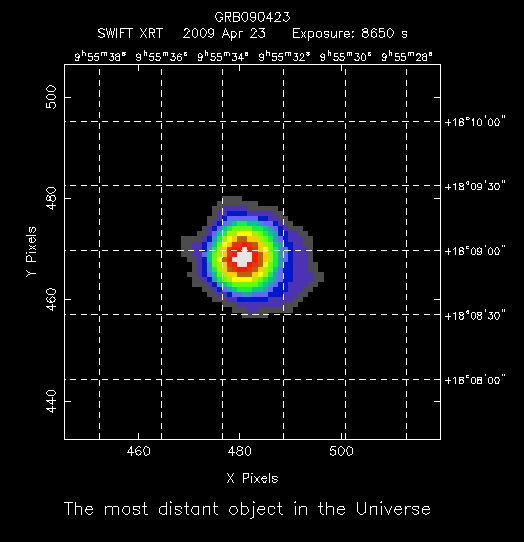 Swift-XRT image of the afterglow of GRB 090423 |
| April 21, 2009 | AGILE Detection of Gamma-ray Emission from the Eta-Carinae Region See AGILE top results: "AGILE Detection of Gamma-ray Emission from the Eta-Carinae Region" 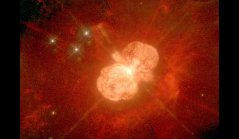 |
| April 19, 2009 | The candidate gamma-ray transient AGL J1734-3310 in the Galactic plane On April 17, 2009 a new AGILE ATel was issued: ATel #2017 (A. Bulgarelliet al.), reporting the AGILE detection a possible candidate gamma-ray transient. The candidate gamma-ray transient AGL J1734-3310 appears to be consistent in position with 1AGL J1736-3235 and also with the INTEGRAL unidentified source IGR J17354-3255. The ATel#2017 was subsequently referred to by ATel #2019 (S. Vercellone et al.) and ATel#2022 (J.A. Tomsick) concerning Swift and Chandra follow-ups, respectively. |
| April 8, 2009 | 6th AGILE Workshop: information and updates As announced on April 1, a Scientific Mini-Workshop: "AGILE: 2 years after" will be held in Milano on 22-23 April, 2009 in coincidence with the second anniversary of the launch of the AGILE Mission. Preliminary program and other useful information are now available at the 6th AGILE Workshop web site: https://agile.ssdc.asi.it/workshop2009.html |
| April 2, 2009 | AGILE Gamma-ray detection of GRB 090401B The gamma ray burst 090401B (GCN #9066 and #9067, Schady et al. ) occurred in the field of view of AGILE, approximately 41 deg off-axis. A description of the AGILE detection of the burst can be found in GCN #9069 (E. Moretti et al.). A refined analysis of the AGILE-GRID (Gamma-Ray Imaging Detector) data of GRB 090401B confirms the gamma-ray detection of the GRB at energies above 30 MeV with a statistical significance larger than 4 for a 10-second integration after trigger, as reported in GCN #9075 (A. Giuliani et a.) |
| April 1, 2009 | AGILE satellite: 10.000th pass over the ASI Malindi Ground Station On March 31, 2009 at 21:53:38 UTC the AGILE satellite successfully completed its 10.000th pass over the ASI Malindi Ground Station. All satellite subsystems and scientific detectors are working nominally after almost 2 years after launch. This very positive result is obtained thanks to the efficient collaboration of all involved Agilists, ASI, INAF, INFN and CIFS scientists, industry colleagues and technical operators. |
| April 1, 2009 | AGILE: 2 years after (6th AGILE Workshop) We are pleased to announce a Scientific Mini-Workshop in coincidence with the second anniversary of the launch of AGILE: "AGILE: 2 years after" to be held in Milano, 22-23 April, 2009 Congress Hall, INAF-IASF via Bassini 15, Milano, Italy. The Mini-Workshop aims to provide an overview of the Mission highlights and hot topics related to the current high-energy missions from the point of view of the AGILE scientific users and collaborators. Detailed information will follow shortly on this web site. |
| March 24, 2009 | GRB 090324: SuperAGILE Localization of a Long GRB SuperAGILE detected a gamma ray burst on 24 March 2009, at 02:48:09 UT. The burst position was reconstructed as: RA(J2000) = 17h 08m 42.73s (257.178 deg) Dec(J2000) = -48d 08' 47.59" (-48.147 deg) with an uncertainty of 3' radius. A description of the burst can be found in GCN #9029 (F. Lazzarotto et al.) |
| March 23, 2009 | A bright burst from AXP 1E 1547.0-5408/SGR J1550-5418 A bright burst from AXP 1E 1547.0-5408 / SGR J1550-5418 was triggered and imaged by SuperAGILE on 22 March 2009, at 22:39:16 UT. A new GCN Circular was issued: GCN #9014 (E. Del Monte et al.) |
| March 19, 2009 | AGILE detection of a gamma-ray re-brightening of the blazar PKS 1510-089 New ATel issued ATel #1976 (S. Vercellone et al.) |
| March 13, 2009 | AGILE detection of a bright and persistent gamma-ray flare from the blazar PKS 1510-089 During the current AGILE pointing centered near the Galactic Center, the AGILE satellite has detected significant gamma-ray emission above 100 MeV from the source 1AGL J1511-0809 of the First AGILE Catalogue identified with blazar PKS 1510-08, see ATel #1968 (Pucella et al.) and ATel #1957 (F. D'Ammando et al.). The analysis of the most recent AGILE-GRID data integrated from 2009-03-12 06:57 UT to 2009-03-13 05:03 UT for photon energies above 100 MeV, gives a detection significance of above 9 sigma for a source flux in excess of 400 x 10^-8 ph cm^-2 s^-1. 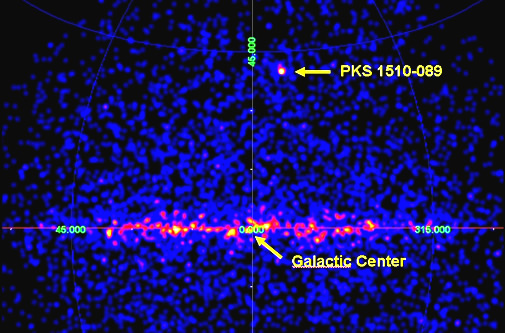 The figure shown above shows the gamma-ray count map of the relevant field of the current Galactic Center pointing. |
| March 10, 2009 | AGILE detection of the flaring gamma-ray blazar PKS 1510-089 New ATel issued ATel #1957 (F. D'Ammando et al.) |
| February 10, 2009 | Fermi-LAT Bright Source List released The Fermi-LAT Bright Source List has been released on February 9th, 2009. The list is available at ASDC and at the Fermi Support Center. For a full explanation about the source list and its construction see here. |
| January 28, 2009 | SuperAGILE detects a flare from the binary source 3A 0114+650 New ATel issued ATel #1917 (L. Pacciani et al.) |
| January 12, 2009 | AGILE: ToO toward the Carina Field The AGILE satellite will be pointing at the Galactic plane near the Carina Region: Ra(J2000)=10h 46m 40.5s DEC(J2000)=-59° 51' 39.5" (galactic coordinates: l=287.859 b=-0.693) for a 1-week period starting on Jan. 12, 18:00 UT, until Jan. 19, 18:00 UT. |
| December 22, 2008 | SuperAGILE source catalog and light curves now available We are pleased to announce that the SuperAGILE source catalog and light curves are now publicy available at the ASDC Webpage: https://agile.ssdc.asi.it/sagilecat_sources.html . The page will be automatically updated twice a day. |
| December 10, 2008 | AGILE First Catalog now available and AO2 deadline postponed We are pleased to announce that the "First Catalogue of AGILE-GRID High Confidence Gamma-Ray Sources" is now available from at the ASDC Webpage: https://www.ssdc.asi.it/agilebrightcat. Due to the unforeseen unavailability of part the AGILE scientific staff at ASDC, the preparation of the First AGILE Catalogue took longer than expected. In order to allow AGILE AO2 guest observers to benefit of this catalog in the preparation of their proposals the previous AO2 deadline of 12 December 2008 has been postponed to 7 January 2009. |
| November 17, 2008 | AGILE detection of a possible rebrightening of the gamma-ray source AGL J2021+4032 in the Cygnus Region New ATel issued ATel #1848M. Tavani |
| November 12, 2008 | AGILE AO2 issued The second Announcement of Opportunity for the participation in the AGILE Guest Observers Program has been issued today. The complete documentation for this AO2 can be found here |
| November 4, 2008 | AGILE detection of the gamma-ray source AGL J2030+4043 New ATel issued ATel #1827 (M. Tavani et al.) |
| November 3, 2008 | Key dates for the 2nd AGILE Announcement of Opportunity The AGILE Mission Board has set the following key dates for the 2nd AGILE Announcement of Opportunity (AO2) for obtaining data rights on gamma-ray sources observed during Cycle-2: - Release of AO2: November 12, 2008 - Due date for proposals: December 12, 2008 - AO2 Observing Period (Cycle-2): December 1, 2008 - November 30, 2009 The complete AO2 documentation will be available on-line on November 12, 2008 from the official AGILE Web site: https://agile.ssdc.asi.it |
| October 15, 2008 | SuperAGILE detection of Vela X-1 in highly active hard X-ray state A description of the current X-ray flaring activity of the source the Vela X-1 can be found in ATel #1782 (P.Soffitta et al.). The SuperAGILE orbital light curve of the source is shown in the figure. 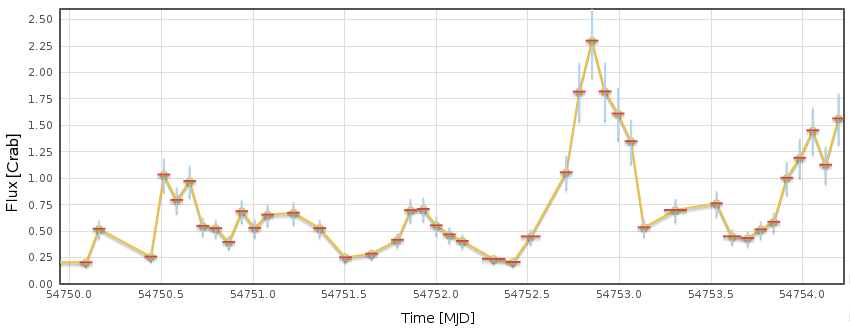 |
| October 13, 2008 | Two important findings for the AGILE Satellite COMUNICATO CONGIUNTO ASI-INAF-INFN (in italian) |
| October 10, 2008 | SuperAGILE detects an X-ray burst from SAX J1750.8-2900 New ATel issued ATel #1775 (L. Pacciani et al.) |
| October 1, 2008 | GRB081001: SuperAGILE Localization of a long GRB A description of the burst can be found in GCN 8305 (F. Lazzarotto et al.) |
| September 23, 2008 | SuperAGILE detects an X-ray burst from the Millisecond Pulsar SAX J1808.4-3658 New ATel issued ATel #1732 (E. Del Monte et al.) |
| September 10, 2008 | SuperAGILE detects IGR J16318-4848 in a bright state at hard X-rays New ATel issued ATel #1713 (L. Pacciani et al.) |
| September 8, 2008 | SGR 0501+4516: AGILE observations New ATel issued ATel #1705 (M. Feroci et al.) |
| August 28, 2008 | GRB 080828: SuperAGILE GRB Localization A description of the burst can be found in GCN 8151 (E. Del Monte et al.) |
| August 28, 2008 | NASA Renames GLAST as Fermi Gamma-ray Space Telescope The Gamma-ray Large Area Space Telescope, or GLAST, has begun its mission of exploring the universe in high-energy gamma rays. The spacecraft and its revolutionary instruments passed their orbital checkout with flying colors. NASA announced August 26 that GLAST has been renamed the Fermi Gamma-ray Space Telescope. The new name honors Italian-American Nobel Prize Enrico Fermi (1901-1954), a pioneer in high-energy physics. ASI Press release: http://www.asi.it/SiteEN/Default.aspx NASA Press release: http://www.nasa.gov/mission_pages/GLAST/news/glast_findings_media.html |
| August 28, 2008 | AGILE special ToO pointing on SGR 0501+4516 scheduled for August 31, 2008 Following the recent identification by the Swift Team of the previously unknown Soft Gamma Repeater SGR 0501+4516 (see ATel #1676, S. D. Barthelmy et al.), AGILE will repoint at the source on August 31, 2008 12:00 UTC. The AGILE ToO pointing on SGR 0501+4516 will last 10 days, and it is an anticipation of the Anti-Center pointing foreseen for September 30, 2008 according to the AGILE Baseline Pointing Plan (ABPP) - Cycle-1. The reference AGILE Baseline Pointing Plan for Cycle-1 was published at the beginning of the Cycle-1 on December 1st, 2007 and is visible on: https://agile.ssdc.asi.it/ao.html The currently scheduled AGILE pointings are visible on: https://agile.ssdc.asi.it/current_pointing.html |
| August 26, 2008 | GRB 080825B: GRB Localization by SuperAGILE A description of the burst can be found in GCN 8133 (Y. Evangelista et al.) |
| August 4, 2008 | New ATel issued ATel #1641 ATel #1641 |
| July 29, 2008 | GRB 080726: GRB Localization by SuperAGILE A description of the burst can be found in GCN 8020 (F. Lazzarotto et al.) The SuperAGILE light curve of the event is shown in the figure. 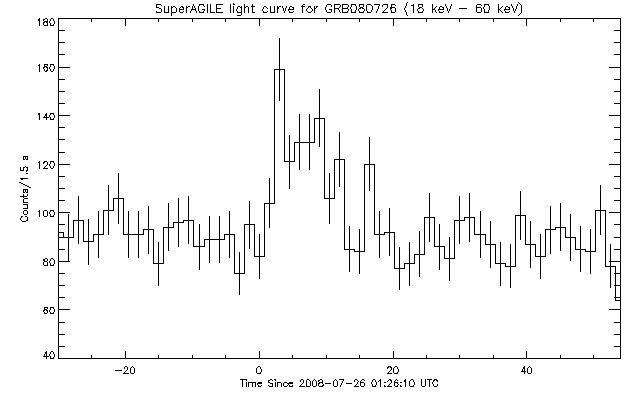 |
| July 23, 2008 | GRB 080723B: Detection and Localization by SuperAGILE A description of the burst can be found in GCN 8003 (E. Del Monte et al.) The SuperAGILE light curve of the event is shown in the figure.  |
| July 18, 2008 | New ATel issued #1619 ATel #1619 |
| June 26, 2008 | New ATel issued #1592 ATel #1592 |
| June 23, 2008 | New ATel issued #1585 ATel #1585 |
| June 17, 2008 | New ATel issued #1583 ATel #1583 |
| June 17, 2008 | New ATel issued #1582 ATel #1582 |
| June 16, 2008 | New ATel issued #1581 ATel #1581 |
| June 10, 2008 | AGILE special ToO pointing on W Comae (ON +231) Following a TeV outburst from the BL Lac W Comae reported by the VERITAS Collaboration in ATEL #1565, AGILE repointed at the source on June 9 2008, 16:00 UTC. The AGILE pointing coordinates at the beginning of the ToO pointing period are: RA(J2000) = 182.3 deg = 12h 9m 8.3s Dec(J2000) = 29.6 deg = 29° 36' 50.4" (galactic coordinates: l = 195.5 b = 80.4) This special pointing will last until June 15, 2008 12:00 UTC. Multifrequency observations are strongly encouraged. |
| May 27, 2008 | New ATel issued #1545 ATel #1545 |
| May 27, 2008 | New ATel issued #1547 ATel #1547 |
| May 15, 2008 | GRB 080514B: SuperAGILE/IPN GRB Localization and possible AGILE detection at E>50 MeV SuperAGILE and AGILE/MCAL detected a gamma ray burst on May 14th, at 09:55:56 UT. The event was localized by SuperAGILE at approximately 38 degrees off axis, in the one-dimensional portion of its field of view. The event was also detected by the burst detector onboard Mars-Odyssey, thus the IPN was able to reduce the SuperAGILE error box to the 100 sq arcmin error box, whose centroid is at (RA, Dec)= (322.820, 0.737). The error box corners are given by the following coordinates (RA, Dec): 322.962 (21h 31m 50.81s) 0.733 (0d 43m 59.69s) 322.774 (21h 31m 5.74s) 0.667 (0d 40m 2.78s) 322.867 (21h 31m 27.99s) 0.806 (0d 48m 21.16s) 322.678 (21h 30m 42.80s) 0.740 (0d 44m 23.63s) A description of the burst can be found in GCN 7715 (M. Rapisarda et al.) As reported in GCN 7716 (A. Giuliani et al.) a quick look analysis of the AGILE GRID data of GRB 080514B shows a possible detection at energies E>50 MeV at a position consistent with the SuperAGILE-IPN localization . |
| May 9, 2008 | GRB 080507: GRB localization by SuperAGILE SuperAGILE detected and localized a gamma ray burst on May 7th, at 07:45:00 UT. The burst position was reconstructed as (RA, Dec) (233.721 deg, 56.424 deg), which is: RA(J2000) = 15h 34m 53.11s Dec(J2000) = 56d 25' 27.3" with an uncertainty of 3' radius. The given uncertainty accounts for both the statistical and systematic errors. A description of the burst can be found in GCN 7697 (I. Lapshov et al.) The event was detected during the passage of the AGILE spacecraft through the South Atlantic Anomaly. The telemetry of the AGILE Gamma Ray Imager (GRID) is disabled during the passage through the South Atlantic Anomaly, thus no GRID data are available for this GRB. 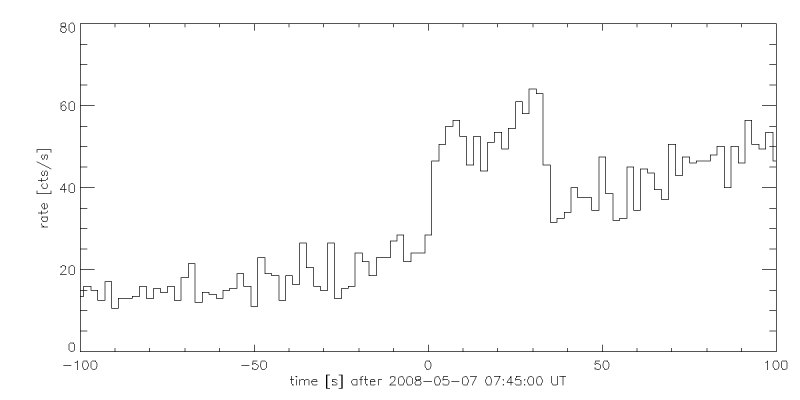 |
| April 29, 2008 | Swift detection of the brightest X-ray flare from S50716+714 On 28 April 2008 Swift detected the blazar S50716+714 at X-ray and UV flux levels significantly larger than ever observed before. An analysis of the XRT data gives a 0.3-10 keV X-ray flux of 4e-11 erg/cm2/s, about 50% larger than that observed at the peak of the giant X-ray flare of October-November 2007. Swift will continue the monitoring of S50716+714 over the next few days, while the AGILE Gamma-ray observatory will include this source within its field of view between April 30 and May 10, 2008. Multi-frequency observations are strongly encouraged (ATel.#1495, Giommi et al.) |
| April 29, 2008 | AGILE gamma-ray detection of a variable source in the Cygnus region The AGILE satellite, from data obtained between 2008-04-27 01:39 UT and 2008-04-28 01:27 UT, detected significant and variable gamma-ray emission from a source positionally consistent with 3EG J2020+4017, see ATel #1492 (F. Longo et al.). Multiwavelength observations of the source location are strongly encouraged. |
| April 22, 2008 | 5th Science AGILE Workshop We are pleased to announce the 5th Science AGILE Workshop "AGILE first year of gamma-ray astrophysics" to be held on June 12-13, 2008 at ASI-ASDC c/o ESA/ESRIN, Frascati . Detailed information will follow shortly on this web site. |
| April 10, 2008 | GRB 080408: GRB Localization by SuperAGILE SuperAGILE detected and localized a gamma ray burst on April 8th, at 18:12:48 UT. The event was approximately 13 degrees off-axis. The burst position was reconstructed as (RA, Dec) (114.678 deg, 33.305 deg), which is: RA(J2000) = 114.678 deg = 07h 38m 42.68s Dec(J2000) = 33.305 deg = 33d 18' 16.7" with an uncertainty of 3' radius. The given uncertainty accounts for both the statistical and systematic errors. A description of the burst can be found in GCN 7571 (P. Soffitta et al.) A preliminary analysis of the AGILE GRID data (E>100 MeV) does not show any significant gamma ray emission at the time and coordinates of the burst GRB 080408 localized by SuperAGILE, see GCN 7572 (S. Mereghetti et al.) Swift performed a Target of Opportunity Observation of the SuperAGILE GRB 080408, starting ~25 ks after the trigger. The results of XRT and UVOT data analysis in this field have been reported in GCN 7576, GCN 7577. A GROND (La Silla Observatory, Chile) detection of optical/NIR afterglow candidate is reported in GCN 7581. |
| March 27, 2008 | SuperAGILE detects an X-ray burst from a position consistent with IGR J17473-2721 The burst was detected on 26 March 2008, 23:19:40 UT, lasted approximately 40 s and it was significantly detected only in the energy range 17-25 keV, see ATel #1445 (E. Del Monte et al.). Considering the intensity, the temporal and spectral properties of the event as well as the spatial coincidence with the source IGR J17473-2721 near the Galactic Center, we propose that the burst observed by SuperAGILE was indeed a Type I X-ray burst, and suggest that IGR J17473-2721 is an X-ray burster. The SuperAGILE X-ray burst image and light curve are visible here . |
| March 26, 2008 | GRB 080319C: AGILE-MCAL observation of the prompt emission On March 19 2008 the Swift localized GRB 080319C triggered the Mini-Calorimeter (MCAL) instrument onboard the AGILE satellite at 12:25:56 UT (=T0), see GCN #7457 (M. Marisaldi et al.). |
| March 26, 2008 | AGILE detection of a gamma-ray source coincident with Blazar PKS 1510-08 The AGILE satellite detected on March 20 2008 significant gamma-ray emission from a source positionally consistent with the blazar PKS 1510-08, see ATel #1436 (F. D'Ammando et al.). Multiwavelength observations of the source location are strongly encouraged. |
| February 29, 2008 | AGILE AO-1 News The official list of all AGILE AO-1 approved targets is now available here |
| February 25, 2008 | AGILE gamma-ray detection of a variable source in the Musca region AGILE detected during the period between 2008-02-21 06:00 UT and 2008-02-22 07:30 UT a gamma-ray flaring source near the Galactic plane in the Musca region, see ATel #1394 (C. Pittori et al.). The source positional error box is centered at Galactic coordinates l = 312.2 deg, b = -0.3 deg, and has a radius of about 0.5 degrees. Multiwavelength observations of the source location are strongly encouraged. |
| February 12, 2008 | AGILE AO-1 News The AGILE Data Center (ADC) at ASDC is currently finalizing the schedule for AGILE AO-1 software, calibration and data release for Guest Observers. PI of accepted proposals will receive further information in the next days. |
| February 12, 2008 | AGILE TOO on Mkn 421 Following a TeV alert for the blazar Mkn 421,AGILE repointed at the source on February 9, 2008 09:00 UTC. This special TOO pointing lasted until today, February 12, 2008 12:00 UTC when AGILE returned to look at the South Galactic Pole region, according to the Cycle 1 Baseline Pointing Plan. |
| January 4, 2008 | AGILE back in standard observing mode From Dec. 31st, 2007 to Jan. 4th, 2008 the AGILE Payload has not been in observing mode due to technical problems. From 13:30 UT of Jan. 4th, 2008 the AGILE detectors returned to the standard operating mode. |
| December 1, 2007 | AGILE AO1 data taking period started The AO1 data taking period started today, as planned. The official list of approved AO1 sources will be released within a few days. |
| November 28, 2007 | AGILE gamma-ray detection of a strongly variable source in the Cygnus region AGILE detected on Nov. 24, 2007 a strong gamma-ray flaring source near the Galactic plane in the Cygnus region, see ATel #1308 (A. Chen et al.) The variable source positional error box is centered at Galactic coordinates l = 75.0 deg, b = -0.4 deg, and has a radius of about 1 degree. Multiwavelength observations of the source location are strongly encouraged. |
| November 15, 2007 | AGILE detection of a gamma-ray source coincident with Blazar 3C 454.3 The AGILE satellite, currently in its science performance verification phase, during the Observing Block that started on 2007-11-02 12:00 UT, detected significant gamma-ray emission from a source more than 40 degrees off-axis, coincident with the blazar 3C 454.3. See ATel #1278 (A. Chen et al.) for details. The AGILE pointing of the Galactic plane region that includes this gamma-ray source will continue until 2007-12-01 12:00 UT. |
| November 6, 2007 | GRB 071104: Gamma Ray Burst Localization by SuperAGILE SuperAGILE detected and localized a gamma ray burst on November 4th, at 11:41:09 UT (*). The event was approximately 22 degrees off-axis. The burst position was reconstructed as: RA(J2000) = 295.600 deg = 19h 42m 23.9s Dec(J2000) = 14.645 deg = +14d 38' 42" with an uncertainty of 8' radius. The given uncertainty accounts for both the statistical and systematic errors. An analysis of the AGILE Gamma Ray Imager (GRID) data is in progress. The Minicalorimeter also detected the event up to the energy range 0.7-1.4 MeV. A description of the burst be found in GCN 7042 (Donnarumma et al.) Swift started observing the field of view of the SuperAGILE burst GRB 071104 about 20.6 ks after the AGILE trigger. The results of XRT and UVOT data analysis in this field have been reported in GCN 7043, GCN 7045 and GCN 7044 (*) this value of the trigger time corrects the trigger time given in the GCN 7042, affected by a typo. |
| October 29, 2007 | AGILE pointing on blazar 0716+714 extended The AGILE special pointing on the optically active blazar 0716+714 will be extended until November 1, 2007. Multifrequency observations are strongly encouraged. |
| October 26, 2007 | AGILE special pointing on blazar 0716+714 Following an intense optical flare of the blazar 0716+714, AGILE repointed at the source on October 24, 2007 08:00 UTC. This special pointing will last until October 29, 2007 12:00 UTC. Multifrequency observations are strongly encouraged. |
| October 1, 2007 | AGILE AO1 issued The first Announcement of Opportunity for the participation in the AGILE Guest Observers Program has been issued today. The complete documentation for this AO can be found '' here |
| September 24, 2007 | AGILE detection of a gamma-ray source possibly associated with Blazar TXS 0716+714 / S5 0716+71 The AGILE satellite, currently in its science performance verification phase, during the Observing Block that started on 2007-09-04 12:00 UT, detected significant gamma-ray emission from a source possibly associated with blazar TXS 0716+714 (other name S5 0716+714). See ATel #1221 (A. Giuliani et al.) for details. Today, September 24, 2007 the GLAST-AGILE Support Program (GASP) of the Whole Earth Blazar Telescope (WEBT) reports on the observation of an optical flare of this blazar in the same period, see ATel #1223 (D. Carosati et al.). |
| September 14, 2007 | AGILE AO-1 postponed The dates of the AGILE AO-1 have been postponed by two weeks. This decision had to be taken in order a) to allow the completion of the AGILE calibration/performance verification phase and b) to complete the definition of the pointing plan for the first year of operations. The new dates of AO1 are : ● beginning of the proposal submission period 1 October 2007 ● deadline for proposals submission 31 October 2007 |
| September 3, 2007 | AGILE detection of a gamma-ray source off the Galactic Plane The AGILE satellite, currently in its science performance verification phase, during an observation centered near the Galactic plane (l=334.44, b=10.06) that started on 2007-08-27 12:00 UT, detected significant gamma-ray emission from a source at approximately 33 degrees off the AGILE pointing direction, see ATel #1199 (Bulgarelli et. al). |
| August 31, 2007 | SuperAGILE detection of GRB070824 On August 24th 2007, at 20:50:09 UT the SuperAGILE GRB-search ground software was triggered by GRB070824. The GRB was seen as a 3 second event, preceded by a weaker 2 s precursor 5 s earlier, leading to an overall burst duration of about ~10 s (T90=9.5 s), see light curve below (courtesy of I. Donnarumma, E. Del Monte, F. Lazzarotto, M. Feroci of AGILE Team). The GRB was observed by SuperAGILE at 48.1 deg off-axis, a region of the instrument field of view with only one-dimensional imaging. In addition, its arrival direction was partially obscured by the Earth's atmosphere. For these reasons, the SuperAGILE-only error box is a long, narrow strip limited by the instrument field of view and Earth occultation in one direction and by the imaging uncertainty in the other. This event was independently detected by other IPN experiments, namely Konus-Wind, Swift/BAT, RHESSI,AGILE/Minicalorimeter, and the AGILE/Anticoincidence, as well as by Konus-A (Cosmos-2421). Their detection combined to provide further constraints to the burst localization to a triangular region, as shown in the figure below (courtesy of Valentin Pal'shin, Ioffe Physico-Technical Institute). A detailed description of the burst and the localization area can be found in GCN 6767 (I. Donnarumma et al.) 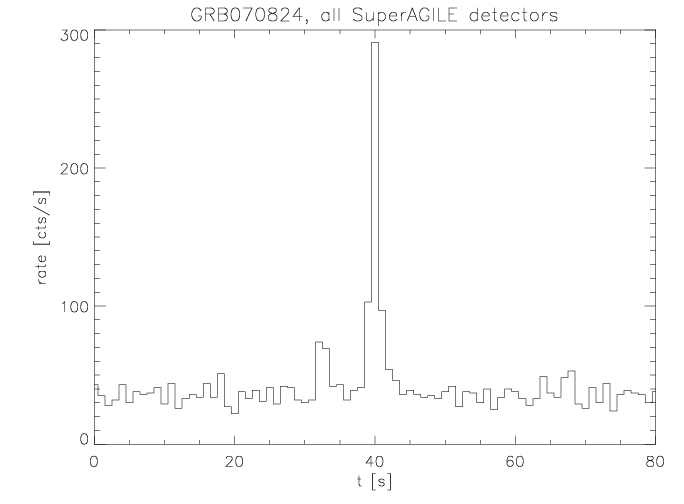 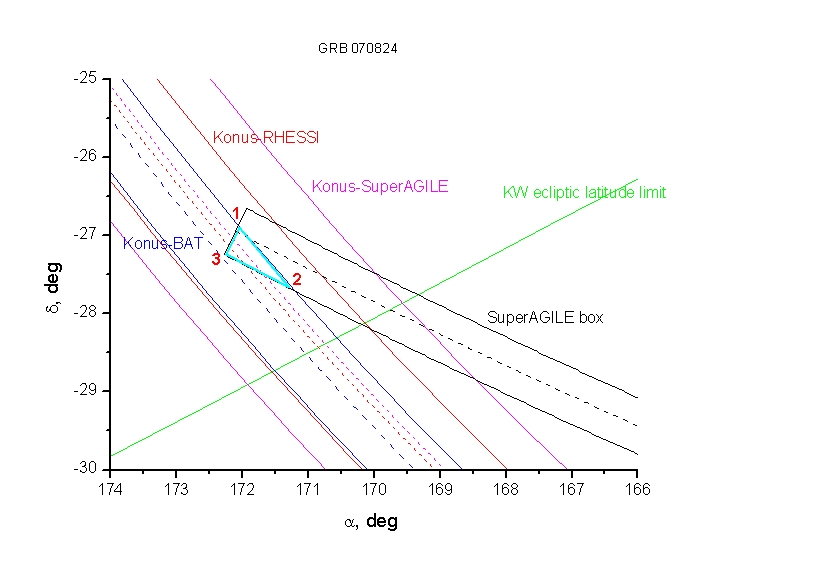 |
| August 9, 2007 | The final catalog of BeppoSAX WFC X-ray sources The final version of the ASDC catalog of BeppoSAX Wide Field Cameras sources is available on-line (wfccat/, see also astro-ph/0707.2941). The table includes 253 distinct X-ray sources detected by the BeppoSAX WFCs in the 2-10 keV band during the 6 years of operational lifetime, between 1996 and 2002. Many sources have been detected several times for a total of 8283 detections. Details and data products for each detection can be obtained from the ASDC Multi-Mission Interactive Archive (mmia) |
| August 7, 2007 | AGILE detection of the blazar 3c454.3 in a high state The AGILE satellite, currently in the science performance verification phase, has observed the 3C 454.3 field starting on 2007-07-24 14:30 UT, and ending on 2007-07-30 11:40 UT following the significant flaring activity of this blazar recently detected in the optical and X-ray energy bands. Considering that the AGILE in-flight calibration is still ongoing, a gamma-ray source positionally consistent with 3C 454.3 was detected by the AGILE GRID (Gamma-Ray Imaging Detector), see ATel #1160 (S. Vercellone et al.) and ATel #1167 (A. Bulgarelli et al.). The images below show the AGILE detection of the source in the gamma-ray energy band E > 100 MeV. The left picture is a detector image with superimposed a grid of Galactic coordinates in ARC projection. The right picture shows the same gamma-ray image distorted to match the Hammer-Aitoff projection in Galactic coordinates. 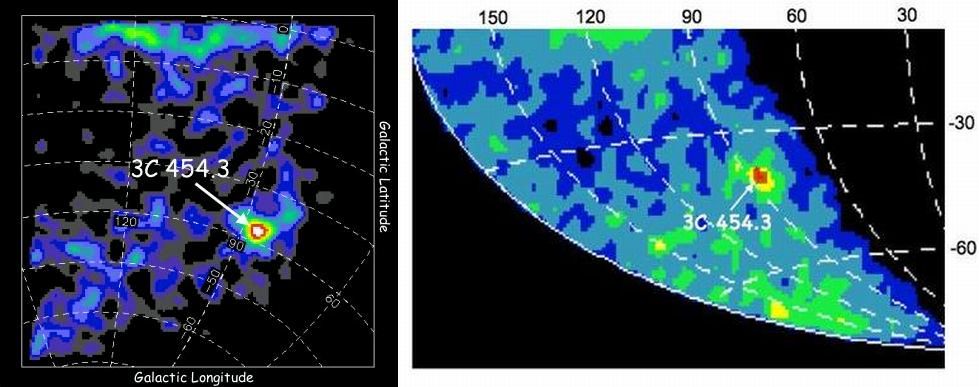 |
| July 26, 2007 | First Gamma-Ray Burst detected by SuperAGILE On July 24 approximately at 23:25:09 UT SuperAGILE detected and imaged GRB 070724b. The experiment is not yet in its optimal configuration and in particular, the onboard triggering and imaging is not active yet and the absolute position reconstruction is being calibrated by using celestial X-ray sources. Ground analysis results showed that the event was observed at 21 degrees off-axis and the observed duration in the 20-60 keV energy range is about 55 seconds, with a multi-peak time structure (see figures). The burst position was reconstructed as (RA, Dec) (17.629 deg,57.673 deg), which is: RA(J2000) = 01h 10m 31.0s Dec(J2000) = +57d 40' 23" with an uncertainty of 20' radius. The given uncertainty is almost entirely systematic and it is due to the very preliminary absolute position calibration, carried out only on 3 X-ray sources. At this preliminary stage the absolute positioning was obtained by the ground calibrations, preliminarily checked with these sources. The error box may be improved over the next hours/days. An analysis of the AGILE Gamma Ray Imager (GRID) data is in progress. A quick look analysis does not show any bright gamma-ray transient in coincidence with the X-ray emission of GRB 070724b. These results have been published in GCN 6668 (Feroci et al.) http://gcn.gsfc.nasa.gov/gcn3/6668.gcn3 Following the SuperAGILE trigger the field of GRB070724b was observed by SWIFT leading to the observation of 2 probable X-ray afterglow candidates (Romano et al., GCN 6669). 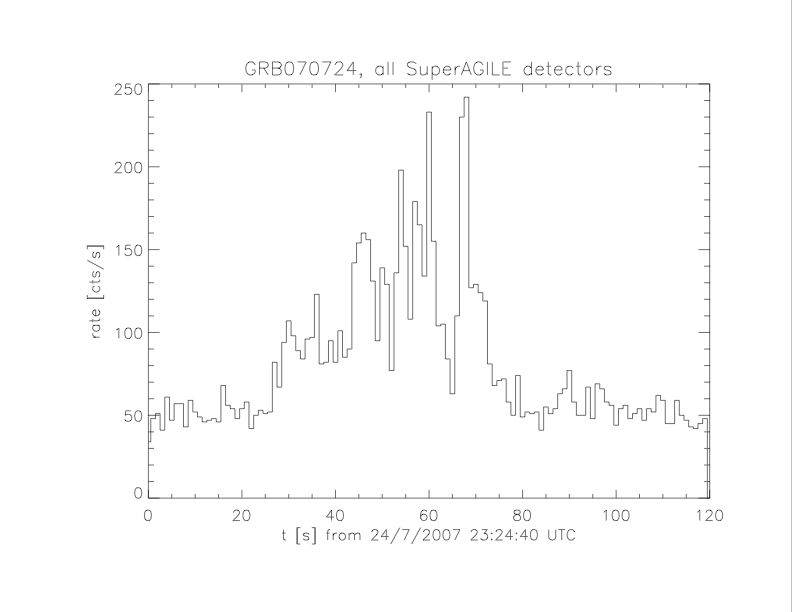 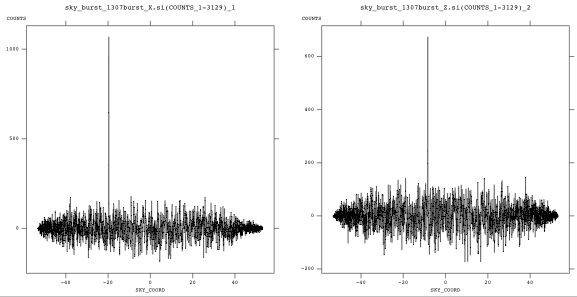 |
| July 26, 2007 | AGILE Observations of 3C454.3 On July 24, 2007 AGILE Observations of 3C454.3 the AGILE satellite carried out a re-pointing of the 3C454.3 field starting on July 24, 2007, 4:30pm, following the significant flaring activity of this blazar that was recently detected in the optical and X-ray energy bands. The pointing centroid coordinates of the co-aligned AGILE gamma-ray and X-ray imagers are: R.A. (J2000) = 17.829 DEC. (J2000) = 36.694 (l= 127.364, b = -26.007). The 3C 454.3 source turns out to be positioned about 36 degrees off-axis with respect to the AGILE pointing centroid. The AGILE gamma-ray imager detection capability at that off-axis position is nominal. AGILE will point at the 3C 454.3 field for the time period: start: July 24, 2007, 4.30 pm end: July 30, 2007, 12:00am. Multifrequency observations of the source are encouraged. Please contact Stefano Vercellone of the AGILE Team (stefano@iasf-milano.inaf.it, mobile phone: +39 347 3089 465). |
| July 23, 2007 | AGILE AO1 Preliminary documentation for the Announcement of Opportunity for Cycle 1 of the AGILE Guest Observer Program is now available at https://agile.ssdc.asi.it/ao.html. Proposals are due from September 15, 2007 up to October 15, 2007 at 18:00 UT. |
| July 16, 2007 | Francesca Tamburelli With deep sadness we have to report that our colleague Francesca Tamburelli died last Friday after fighting a long battle against cancer. Francesca has been involved with the BeppoSAX Science Data Center and with the ASDC since the very beginning. She was responsible for the specialist industrial support to the ASDC (provided by Dataspazio S.p.A.) and was the main architect behind the Swift and AGILE data systems. At the ASDC we have lost a bright mind and a dear friend. |
| July 10, 2007 | AGILE - GLAST Workshop On July the 2nd and 3rd it has been hold at ASDC site the italian Workshop dedicated to gamma-ray astrophysics from space, focused on AGILE and GLAST missions. The conference was attended by 140 people from the astrophysics and particle physics communities, industrial entities and the President of ASI, INFN and INAF. During the Workshop the First AO for AGILE Mission was prsented. Some first very promising results were presented, some of which have been announched in other News. Results from the GLAST on-ground calibration have been presented as well as the Science Working Group activity in preparation to the launch, now foreseen in January 2008. Part of the Workshop was dedicated to the sinergies with other observatories and telescopes, such as INTEGRAL, Swift, MAGIC etc. |
| July 6, 2007 | AGILE: SuperAGILE first light As announced previously, the hard X-ray imager SuperAGILE clearly detected a flare from the source GX301-2 as its first light. These images (courtesy of E. Del Monte, I. Donnarumma, Y. Evangelista, F. Lazzarotto, L. Pacciani of Agile Team) are the results of an immediate raw and very preliminary deconvolution of two detectors. Analysis of the data with the scientific software is in progress. Preliminary results show a declining of the source flux over the subsequent orbits. 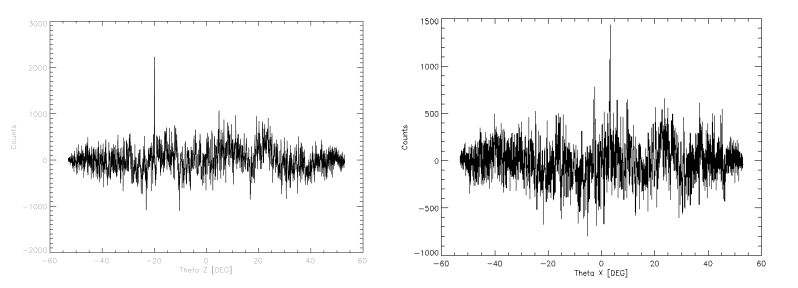 |
| July 4, 2007 | AGILE: 1,000 orbits and approaching the end of the Commissioning phase AGILE has completed yesterday its 1,000th orbit and has almost come to the completion of the initial start-up/Commissioning phase. On July 2nd, at the ASDC/ESRIN Workshop on Gamma-ray Astrophysics in Italy, several AGILE preliminary results have been presented. In particular: - The hard X-ray imager SuperAGILE clearly detected a flare of the source GX301-2 as its first light. - A gamma-ray burst was detected by all active detectors on June 22. The burst position turned out to be about 80 degrees off-axis. - The AGILE calorimeter has clearly detected emission in the 600 keV - 2 MeV energy range. |
| June 19, 2007 | AGILE Commissioning News In this phase the SuperAGILE instrument is undergoing its configuration setting, which we plan to complete at the end of june. |
| June 1, 2007 | AGILE first detection of a cosmic source: the Vela Pulsar The picture shows a preliminary count map (Galactic coordinates) of photons with energy above 100 MeV of the Vela Pulsar region. The observation duration is approximately half a day (7 orbits) between May 29 and 30, 2007. 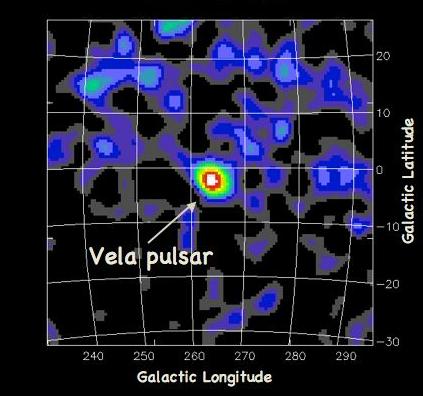 This image represents only the central part of the AGILE gamma-ray imager field of view and was built from data with a preliminary background rejection taken with an instrument configuration that is not yet optimized. The AGILE Commissioning phase will continue until the end of June. This phase is aimed at a fully operational setting of both the gamma/ray and X-ray detectors. |
| May 17, 2007 | AGILE Commissioning news. The AGILE Payload is now operated routinely and the thermal stabilization of the spacecraft is in progress. All Payload subsystems are in nominal conditions with satisfactory temperatures. The first scientific/calibration observations in nominal conditions are planned for the beginning of june with a pointing of the Vela region. |
| May 9, 2007 | First AGILE cosmic photon. Yesterday AGILE detected its first cosmic photon during a test calibration of the Gamma-Ray Imager (Silicon Tracker). The figure below is a view of the track left by the electron-positron pair produced by the incoming photon and recorded in the twelve silicon layers of the detector. 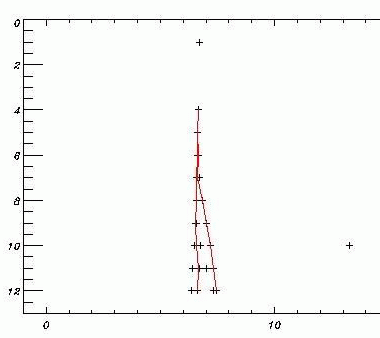 |
| May 8, 2007 | AGILE's 200th pass: all Payload subsystems in nominal conditions. Yesterday, the Payload Anticoincidence System (AC) has been successfully switched on and tested for the entire orbit, including the South Atlantic Anomaly. All test results are nominal and the real-time analysis indicates that the total count rate is as expected. The AC was the last major Payload subsystem awaiting testing after the mini-Calorimeter, the Silicon Tracker and SuperAGILE, which were switched on and tested last week. The Commissioning activities will continue with the Payload thermal stabilization phase, followed by the Scientific Commissioning phase. |
| May 3, 2007 | AGILE Payload switched on! Yesterday, Wed May 2, 2007, the AGILE mini-Calorimeter was switched on, today the Silicon Tracker (gamma-ray detector) and the SuperAGILE (hard X-ray) detector have also been switched on. All systems are nominal and the real-time analysis indicates that the AGILE Payload is in very healthy conditions. The Payload Commissioning will continue now with 11 orbits devoted to SuperAGILE and to the Anticoincidence System that will be switched on next week. |
| May 2, 2007 | AGILE satellite 100th pass On Mon, 30 Apr 2007 12:03 UTC the AGILE satellite has successfully completed its 100th pass. All test results are nominal. The satellite is currently in FINE SUN POINTING attitude, as scheduled by the Commissioning Plan. The Payload Commissioning Phase will begin on Wed, 2 May 2007 to verify the physical and functional integrity of the scientific instruments. |
| April 27, 2007 | AGILE satellite status On Apr. 23rd the AGILE satellite was injected in the nominal equatorial orbit in agreement with the Scientific Requirements of the Mission. The satellite is now in the initial Commissioning Phase. All test results are nominal. The satellite is being tracked at each orbit by the ASI Malindi ground station in Kenya. The AGILE data flow Malindi-Fucino-ASDC is nominal since its first pass on Apr. 23rd |
| April 23, 2007 | AGILE succesfully launched! AGILE was succesfully launched at 10:00 GMT by the Indian PSLV rocket from the Shriarikota ISRO base (Chennai-Madras), India. The first acquisition from the Malindi ground station occurred at 11:30 GMT. The orbital parameters are very close to the predicted values (altitude 550 km, inclination of 2-3 degrees) and the satellite status is nominal. |
| April 16, 2007 | AGILE satellite status The AGILE satellite has been successfully integrated with the PSLV launcher at the ISRO - Sriharikota launch base (Chennai-Madras) India. The final functional tests after integration have been completed on Sunday, April 15th, 2007, at 17:00 (Indian Time). The AGILE satellite is now ready for flight. The AGILE launch is currently scheduled for April 23rd, 2007 GMT Time 10:00, Indian Time 15:30, Italian time 12:00. |
| March 27, 2007 | AGILE satellite status On March 25th AGILE as been shipped to India (SHAR) for the launch campaign. Launch is currently scheduled for 23 April 2007. The following link provides more information from the Indian viewpoint at the Launch Pad. www.space-travel.com/reports/ISRO_To_Launch_Foreign_Satellite_As_Primary_Payload_First_Time_999.html |
| March 21, 2007 | AGILE satellite status The AGILE System Validation Tests 4 (SVT4) at the IABG facility (Munich) have been successfully concluded. AGILE is scheduled to be shipped to India (SHAR) for launch on march 25. |
| March 5, 2007 | Latest AGILE news AGILE satellite status The AGILE System Validation Test 4 (SVT4) currently under way at IABG facility (Munich) will be completed on March 13. AGILE will then be packed and shipped to India (SHAR) for launch. |
| January 26, 2007 | AGILE satellite status The AGILE satellite has been shipped at the IABG facility (Munich) for the final delta qualification tests before launch. |
| January 26, 2007 | India Test Technology For Space Vehicles All Four Satellites in Healthy Condition After PSLV-C7 Launch PSLV-C8 will take the Italian satellite, Agile, to outer space by the end of march 2007. |
| January 12, 2007 | Visit by Mr. Minister Fabio Mussi, Research and University Ministry at ESRIN During the visit of Mr. Minister Fabio Mussi at ESRIN, he will visit at 12:30 - 13:00 hours the ASDC, ASI Science Data Center, hosted in ESRIN. ESRIN, 16 January, 2007, Mercator Conference Room |
| January 12, 2007 | Rossi Prize 2007 for Swift The Rossi Prize 2007 of the American Astronomical Society is awarded to Swift. The citation begin something like this: "Neil Gehrels and the Swift Team for gamma-ray burst discoveries with the Swift mission ..." "This is a great recognition of all the wonderful science coming from Swift ...", Neil Gehrels wrote. |

